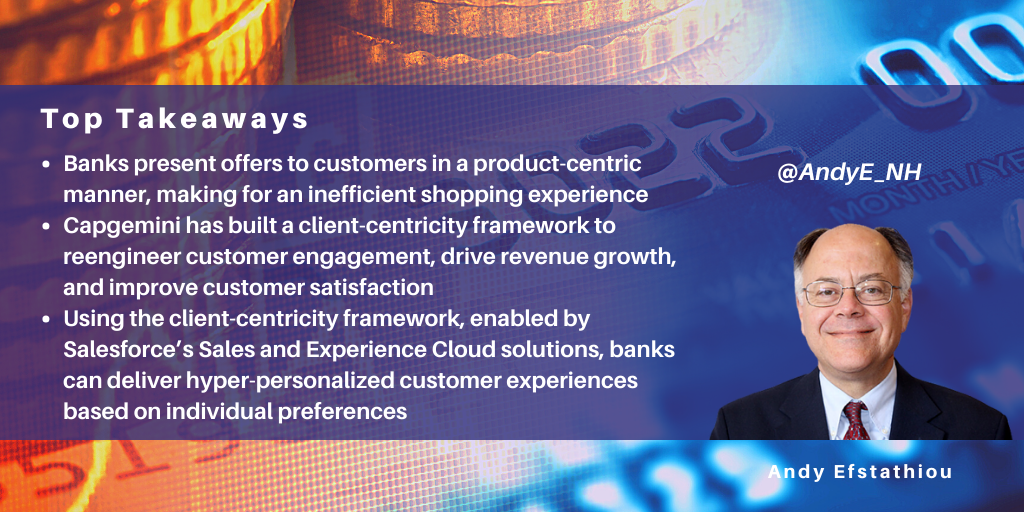
Financial institutions have complex portfolios of products presented to customers in a siloed, product-centric fashion, which makes shopping for financial products inefficient and reduces the overall customer experience. However, digital delivery promises to improve customers' shopping experience, CX, and CSAT.
Some firms in other industries have been doing this successfully, such as Disney for its theme parks. Each theme park has a complex set of offerings to choose from, and Disney uses its MagicBand to connect consumers to all their choices within the park and deliver the final experience. However, developing a customer-centric, unified shopping experience for financial services remains an industry challenge. In the early 2000s, Citibank tried to address these issues with its “Financial Supermarket” concept, But by 2008, the Citibank experiment famously failed.
Capgemini’s client-centricity framework
Capgemini and Salesforce are working together to enable enterprises to deliver customer-centric, unified, and optimized consumer experiences for financial services, similar to the Disney MagicBand concept. Capgemini has built a client-centricity framework to identify customer drivers and enterprise enablers that will support reengineered customer engagement, and in turn, drive revenue growth and improve customer satisfaction. Critical components of Capgemini’s client-centricity framework include:
- Customer drivers:
- Personalization: tailoring the customer’s experience
- Availability: ubiquitous, 24/7 access and responsiveness to customer inquiries/demands
- Trust: built via reputation, ethics, and actions
- Diverse offerings: providing a wide range of financial offerings
- Autonomy: empowering customers to make informed decisions
- Enterprise enablers:
- Strategy Alignment: ensuring corporate strategy aligns with customer needs
- Data capabilities: employing data to customize offerings to individual customers
- AI/technology upgrade: re-engineering the technology platform to a customer-centric approach
- Operating model automation: digitalizing and automating all operations delivery to customers
- Culture: attracting, training, and retaining employees with high domain knowledge and customer interaction skills.
Effective organizations can analyze customer drivers in real-time and prioritize offerings and fulfillment to meet a customer’s needs.
Salesforce technology
Salesforce provides the solutions and platforms to integrate and deliver enablement for clients. Key Salesforce offerings used in the partnership include:
- Data Cloud: the platform integrates sales, service, and marketing data from multiple silos to create a single experience across customer-facing functions
- Sales Cloud: a sales management solution providing lead and pipeline management, forecasting, and AI insights
- Service Cloud: a customer services platform that helps businesses manage and resolve customer inquiries and issues
- Marketing Cloud: the platform integrates data, teams, technology, and AI to enable real-time personalization
- Experience Cloud: enables a business to create branded digital experiences to share information and collaborate
- Financial Services Cloud: a platform built on the SF Sales and Service Cloud platforms but customized for the financial services industry, including industry compliance requirements and data compliance. Initially designed for the wealth management industry, it supports relationship managers managing customer relationships
- Einstein 1 and Co-pilot Studio: AI assistants that respond to natural language inquiries
- Next Gen Tableau: automates data analysis, predicts user requirements, and generates actionable insights.
These solutions provide functionality to enhance data quality and integrity, provide contextual suggestions, and customize AI actions to specific customers.
By combining these two offerings, Capgemini’s client-centricity offer and Salesforce’s Sales and Experience Cloud offerings, financial institutions can deliver hyper-personalized customer experiences based on their individual preferences. The AI embedded in these platforms enables advisors and customers to find available financial products that are relevant. Current engagements are delivering these capabilities to banks. Here is a recent example:
Client example: large U.S. bank
Challenge
A leading retail bank could not deliver the seamless customer experience it wanted. Specific challenges included:
- Fragmented customer experience due to the lack of a unified digital solution. Lack of a 360° customer overview resulting in a poor time-to-market for new product launches
- Fragmented operational silos, which created a disjointed customer journey, the slow release of solution enhancements, and reconfiguration challenges
- Manual interventions to communicate data across silos reduced visibility and increased error rates in market and transaction data.
Scope of Services
- Integrated and deployed an integrated solution of Salesforce, Mulesoft, and Marketing Cloud across all systems
- Solution was delivered across experience strategy, roadmap development, design, implementation, and standup
- Phased deployment strategy to minimize risk
- New activation channels were opened based on predefined segmentation to enhance customer engagement.
Benefits
- Customers experienced an omnichannel experience with priorities based on customer goals, regardless of initial channel entrance
- Improved lead management, resulting in increased conversion ratios
- Minimal impact on legacy systems
- Elimination of manual processes leading to lower error rates, faster throughput, and enhanced CSAT
- Integration benefits included real-time reporting to speed up troubleshooting, provide insights into customer behavior, and assess system performance.
As this case demonstrates, customers no longer have to “stumble upon” products that meet their needs by accessing multiple product silos; the platform can sift through an ocean of data to narrow down offerings and present a few highly relevant suggestions for final consideration. This should make dealing with a bank less stressful and more satisfying.
]]>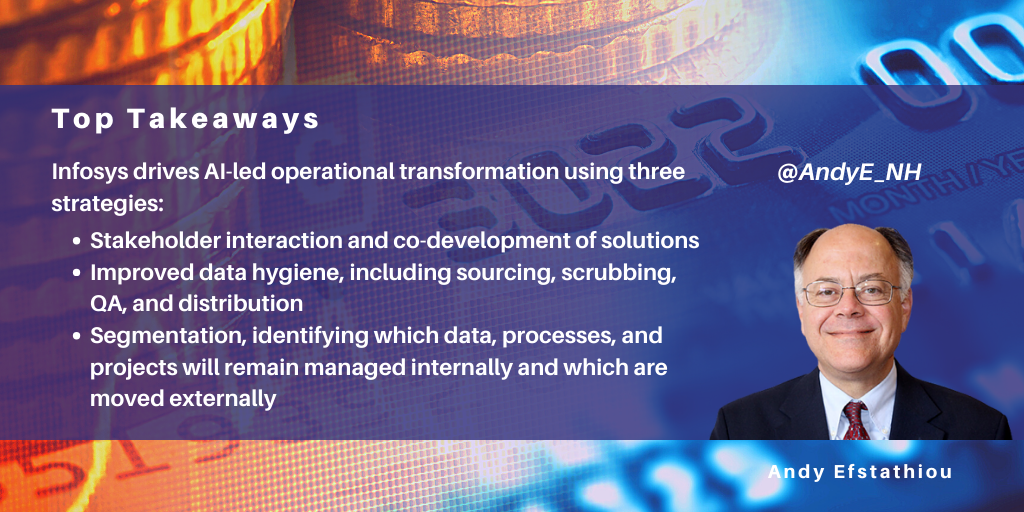
NelsonHall recently attended the Infosys U.S. Analyst Day in Dallas, the theme of which was “Being AI First”. It demonstrated clear progress since last year’s conference in Infosys’ thinking and approach to the critical steps for effective implementation and operational deployment of AI.
Key components of AI-led operational transformation
Infosys and its clients attending the conference identified three essential components to enabling an effective AI-led operations transformation:
- Stakeholder interaction and co-development of problem definition, goals identification, roadmap development, and operations transformation
- Data hygiene, including sourcing, scrubbing, QA, and distribution
- Segmentation, identifying which data, processes, and projects will remain managed internally and which are moved externally.
To drive the first component of stakeholder interaction, Infosys pursues a hub-first strategy for innovation. Hubs are operational centers of expertise where Infosys and its clients work on client projects to develop novel POCs and operational deployments. Clients prefer to be involved in innovating their operations and have relevant input to shape and drive the innovation process. This enables a co-creation process that allows enterprises to focus on innovation at a higher success rate. Infosys values the feedback, domain expertise, and deep knowledge of an institution’s differentiating factors that clients provide in a hub environment.
To drive innovation in a tightly coupled co-creation environment, Infosys has built tech and innovation hubs worldwide. In the U.S., it had committed to building four hubs in 2018, but it has set up six because of client demand. The six hubs are based in Providence, RI; Richardson, TX; Hartford, CT; Raliegh, NC; Indianapolis, IN; and Phoenix, AZ.
The ideation from hubs needs to be realized with AI functionality and delivered with operational flexibility. To enable that synthesis, Infosys has coupled two of its platforms, Topaz (an AI-first offering that helps enterprises create value from generative AI technologies) and Cobalt (a set of services, solutions and platforms for enterprises to accelerate their cloud journey), to speed up ideation and the operationalization of successful POCs. This enables innovation at both speed and scale.
To continue growing its capabilities, Infosys is investing in AI to support operational transformation. Infosys’ significant investments in AI-led transformation are:
- Infrastructure-led transformation to the cloud
- Data and AI transformation leveraging the cloud
- Business transformation led by enterprise apps and SaaS
- Platform engineering
- Non-IT workloads to the cloud.
Infosys’ AI-first strategy for financial services
Infosys has built its most comprehensive domain-specific AI capabilities for the financial services industry. Financial services is the largest industry segment for Infosys (~30% of revenues), and North America is the largest single market (~60% of total revenues).
Infosys’ AI-first strategy for financial services focuses on nine areas it uses to help banks improve their business performance. The focus areas are:
- Personalization at scale for sales and marketing
- Deepening relationships by helping advisors work with customers
- Portfolio management and product design and testing
- Risk scoring for credit, AML, KYC, and onboarding
- Operations improving CX and employee experience
- Modernizing tech and infrastructure with AI
- Talent and change management
- Making the enterprise data ready.
Client use case
Infosys provided a use case of a credit union. The credit union has been committed to giving back to its employees and members, and had to identify how changing technology and member preferences could be fulfilled and achieved with new delivery techniques and offers. Data is the core of the financial services industry, And the credit union segmented its data into three areas:
- Foundational data: this is unchangeable data that should remain on-premises. Examples include identifier data and legally private data
- Core data: this data includes transaction data and transient entity data. Examples include KYC, AML, fraud, and transaction data. This data can be moved to the cloud
- Sales and marketing data: this data changes rapidly in response to changing market conditions and various product campaigns. This data should be kept in the cloud from the start because it has a very short lifespan. However, the research data supporting the campaigns comes from internal and external data and, therefore, should not be kept in the cloud.
Infosys identified 200 use cases to manage the data and drive better customer value. Cases were ideated, POCed, and operationalized in a disciplined waterfall where unpromising use cases were dropped. The primary driver of use cases that make it to full operational deployment is customer data rather than product data. The client started the initiative with employees and leveraged Infosys’ tools and support to enable it to develop offerings and delivery methodologies that appeal to a younger generation with differing priorities and needs than the older generation.
Summary
Intelligent automation and data transformation POCs and projects have gained traction over the past year, propelled by the GenAI opportunity and hype. Only some of the many POCs and MVPs have translated into operational transformation at scale. Infosys’ approach to using AI to drive operational change uses client co-creation to build differentiating operational change, data hygiene techniques to enable effective analysis, and rigorous segmentation of data, projects, and processes to set role-based responsibilities. This approach allows for change to happen quickly and at scale.
Infosys provided examples of how it delivers these services in the financial sector, including regional and local banks. These banks represent a larger addressable market for IT services vendors than tier-one banks because they have older legacy systems and will be less likely to retain as high a level of internal operations as the tier-one banks in the long run.
The challenge for vendors is to identify compelling value propositions for clients. Infosys has addressed this challenge with its localization initiatives that drive the co-creation of differentiated operational offerings at scale. Data drives the financial services industry, and Infosys’ activities with a credit union, described above, outline how a data transformation program can be handled.
]]>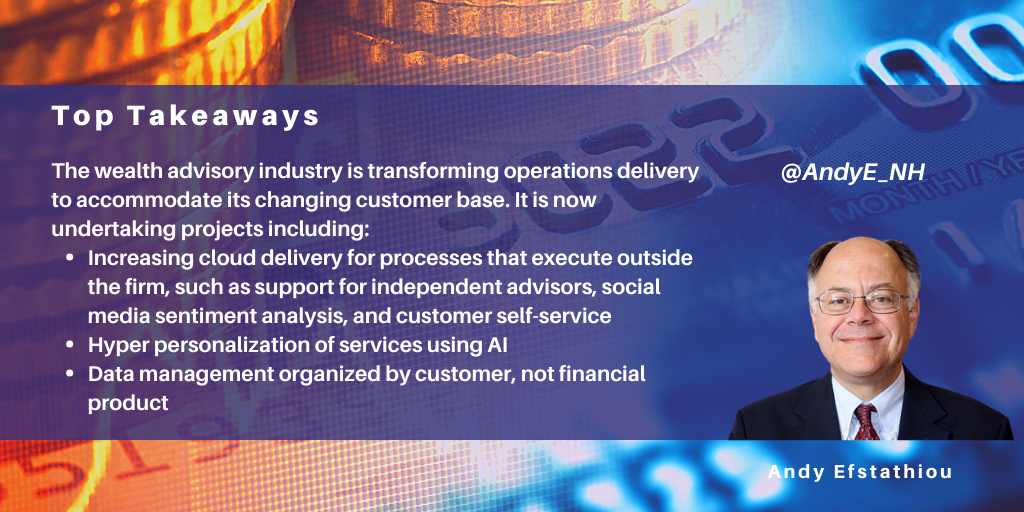
Financial institutions are rapidly starting or growing existing wealth and asset management businesses. In the U.S., wealth assets under third-party management have grown over the last five years by 16.8% CAGR to 2023 (Source: Statista). Wealth advisors are looking to continue to invest in and grow their wealth management businesses because they see continued growth coming from:
- Generational transfer of wealth from baby boomers to younger generations. The estimated transfer of wealth is $84 trillion over the next 20 years (per Cerulli Associates)
- Perceived risk of an economic downturn by the management of financial institutions. This would lead to significant losses in risk portfolios for the banks. However, wealth management is a fee-based business and not subject to capital losses.
NelsonHall’s operations research finds new customer demographics can be profitably served with digitalized service delivery. These customer demographics are the mass affluent and the unbanked. Government initiatives such as India’s program to issue Aadhaar numbers to all citizens enable previously unbanked citizens to access financial services. Governments are moving towards individual retirement funding, necessitating individuals to start saving. Digitalization of service delivery allows profitable service delivery to a much larger mass affluent customer base.
Changing customer base
The growth in the wealth advisory industry is driven by a changing customer base, which has very different priorities and expectations from the traditional wealth client base. Key new customer priorities are:
- Investments that reflect the client’s values. Examples include investments that score well on ESG and transparency. Weaknesses in effective scoring and benchmarking these attributes remain a challenge
- Digital engagement with advisors. Today’s customers are familiar with digital engagement and expect to have it across their entire environment. Currently, most younger wealth management customers are unhappy with the quality and functionality of their wealth managers’ digital interaction offerings
- Digital tools to educate themselves and provide portfolio and return attribution analyses. The quality of these tools varies widely across wealth managers. Current tools are perceived as inflexible and lacking functionality
- Support for multiple family members. Wealth managers no longer interact with one founder as wealth is transferred to the next generation. As multiple family members are active in decision-making and often pursue different goals from each other, the wealth managers need to support cooperation between family members and customize services for individual needs
- Easy to understand investment strategies. Many investment advisors previously advised on complex investment strategies and structured instruments. Today, investors are looking for simpler investment strategies, such as indexing, to deliver investment performance for them.
These customer priorities and the operational challenges that inhibit them from achieving their goals are driving new initiatives in the industry to enable wealth managers to change their business models and deliver new services.
New wealth & asset management initiatives
New industry initiatives include:
- Cloud delivery for processes that execute outside the firm. Examples include shifting processes to the cloud, which supports external users, especially:
- Third parties such as independent wealth advisors (in the U.S., they are known as Registered Independent Advisors or RIAs) who sell services directly to the financial institution's customers. Cloud-delivered services are efficiently delivered anywhere and offer multiple solutions using APIs to accommodate the legacy solutions of the independent advisor
- Social sentiment collection, analysis, and reporting. Increasingly, investments are being evaluated using social sentiment as part of the analysis. Hyperscalers are delivering AI tools to support the analysis of social sentiment as part of their overall service offerings
- Direct-to-customer data access. As clients increasingly demand more self-service, they need access to both data and AI tools to perform their custom analysis. Hyperscalers have developed ecosystems with both data vendors and AI solution vendors that customers can access to create their custom analysis
- Compliance services that are perceived as a non-differentiating cost. That cost can be minimized by sharing best practices and utilizing a shared environment. In the past, the industry shared best practices in industry forums. Cloud delivery enables industry participants to share infrastructure and best practices continually. Cloud also enables real-time response to threats and deadlines to be shared faster and more effectively
- AI is being deployed to bring highly personalized offers to customers. Examples are the use of AI to:
- Support advisors in developing investment plans for customers
- Enable customers to shop investment offerings using self-service
- Enable customers to do independent investment analysis
- Data management is changing from a siloed approach by investment product type to data collection, analysis, and reporting organized by customer.
These operational transformation initiatives make wealth and asset managers directly accessible to third parties, including customers and business partners. The changes will bring many startup service providers to the wealth management industry. Ultimately, IT services vendors supporting the industry will need to be able to support the IT needs of tiny enterprises to continue effectively servicing the industry. That, in turn, will drive significant change in the IT services industry.
]]>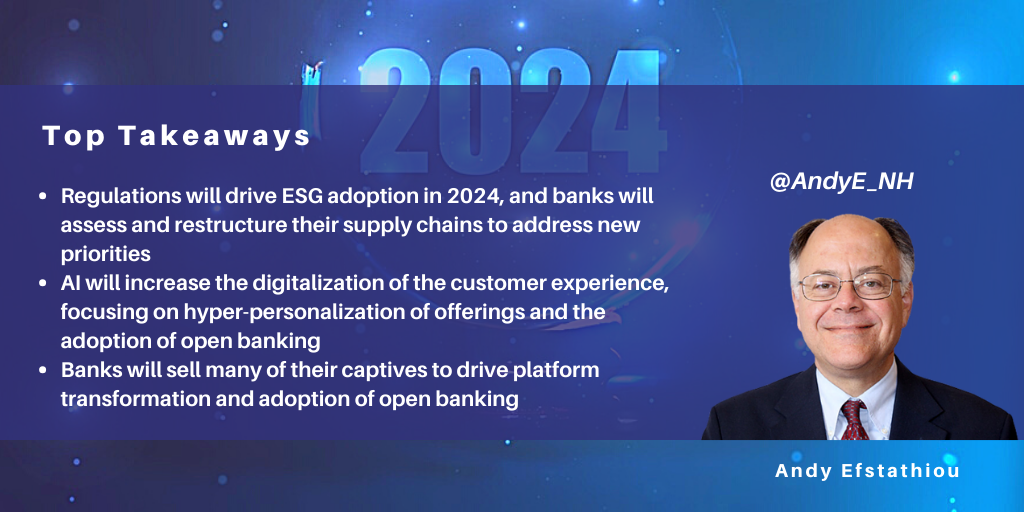
In 2024, the financial services industry will face strong economic headwinds. Usually, this is a formula for downsizing and consolidation. However, today’s headwinds are so strong that the industry will need to:
- Assess and restructure its supply chains to address new priorities such as ESG reporting
- Accelerate customer experience transformation to increase personalization and deliver many new, relevant product offerings
- Sell many more of its operations captives to accelerate digitalization and improve the brand experience across markets and business lines.
Prediction 1: ESG reporting
ESG activities will increase in North America, Europe, and India. There will be an increasing focus on auditability to mitigate “greenwashing” criticisms and make it more difficult for unscrupulous actors to engage in greenwashing initiatives.
Regulations will drive ESG adoption in 2024. The most advanced and demanding regulations are coming from thought-leading regulators in Europe, the U.S., and India:
Europe (Germany)
- January 2024: the EU’s Corporate Sustainability Reporting Directive (CSRD) requires companies to disclose their risks from environmental and social factors
- December 2023: the European Banking Authority disclosure of assets and activities and their exposure to climate change, customers’ and suppliers’ carbon exposure, Green Asset Ratio (GAR)
- June 2024: the European Banking Authority Banking Book Taxonomy Alignment Ratio (BTAR).
United States (California)
- April 2024: SEC-regulated companies must report their GHG emissions
- December 2024: Companies in California must establish processes for auditing their emissions data in anticipation of the 2026 reporting requirement.
India
- April 1, 2024: India’s 250 largest listed entities need to provide value chain ESG disclosures (the largest 150 entities were required to do so in 2023).
These regulations all target supply chain emissions and improve the auditability of enterprise ESG reporting. Many regulations target large corporations but, over time, anticipate lowering the size requirement for reporting ESG activities.
Prediction 2: accelerating digitalization of customer experience
In 2023, banks continued closing branches. 2023 was the fourteenth year of declining branches for U.S. banks, With PNC Bank and U.S. Bank each closing 10% of their branches. The decline of in-person banking options will continue to drive the digitalization of the customer experience. AI, including Generative AI, will drive the increasing adoption of digital customer contact services. The focus in 2024 will be on:
- Hyper-personalization of service offerings in response to a customer’s stated and implied preferences. These AI offerings will deliver less clutter to the customer and drill down to offer a few relevant offerings. Retaining these preferences will enable the customer to maintain an ongoing virtual conversation with the bank, rather than the current state of retelling the bank one’s preferences and goals each time the customer engages with the bank
- Accelerated adoption of open banking partnerships focused on providing specialized lending offerings to customers. Open banking has been slowly developing in response to regulatory requirements. Today’s economy has left banks facing capital and cost challenges, causing them to restrict their lending services. Meanwhile, customers seek customized lending services that meet their need for rapid approval and specialized financing for certain products or services. Open banking will enable banks to offload risk asset creation while enabling FinTechs to provide customers with specialized financing, including green loans. Many FinTech loan offerings delivered by open banking will be embedded finance offerings, becoming the future lending model.
Prediction 3: selling off captive operations
Financial institutions will sell many of their captive operations to improve cost efficiency. The emphasis will be on realigning costs to transform the bank’s business model. This will drive improved customer experience and greater operational agility across multiple businesses and markets.
The financial services industry is facing revenue declines and is looking to cut costs. The Financial Times estimates that the 20 largest global financial institutions have cut over 60k jobs in 2023 as of mid-December. This is the largest single-year decline in financial jobs since the Great Financial Crisis in 2008-09. Other industries are doing worse. Bloomberg estimates that 250k tech workers have already lost their jobs in 2023. The final numbers for the global economy will be larger, making cost control an even higher priority for businesses.
Captives are sold to third parties for three reasons:
- Operations and business model transformation: today’s banking economy necessitates banks transform their operations to service high-volume delivery at lower cost (e.g., premium wealth management services for mass-affluent clients and banking services for previously unbanked populations). Enabling this business shift requires pervasive digitalization of delivery, customer self-service where possible, and AI support for any remaining humans in the loop
- M&A enablement: banks are exiting non-core business lines and scaling core businesses. Most of the cost benefits of mergers are realized by rapidly integrating the two businesses. Third-party support for integrating the acquired entity into a single shared service center requires a technology operations provider focused on this transformation, after which it will scale down the integration force. Only third parties can provide the necessary skills at scale and still downsize upon completion
- Cost savings from reducing inputs (primarily labor) and sharing overhead across a larger operational volume (transforming a single tenant operation to a shared services environment).
Examples of these types of captive acquisitions include:
- Infosys-Stater: Stater is a large mortgage services provider in the Benelux countries. Infosys acquired 75% of Stater from ABN AMRO and is automating and managing its service delivery
- Infosys-Vanguard: Vanguard’s defined contribution business has partnered with Infosys to manage its service delivery, improve customer experience, and move its recordkeeping to the cloud
- TCS-Standard Bank (the largest African custodian): TCS will centralize and standardize the bank’s custody and securities settlement operations across 15 markets in Africa using TCS’ proprietary securities platform.
These activities will accelerate the digitalization of banking processes and the extent of open banking where institutions partner to deliver offerings to banking customers on shared platforms.
To keep up to date with NelsonHall's Banking research and thought leadership in 2024, subscribe to our Banking Insights newsletter on LinkedIn.
]]>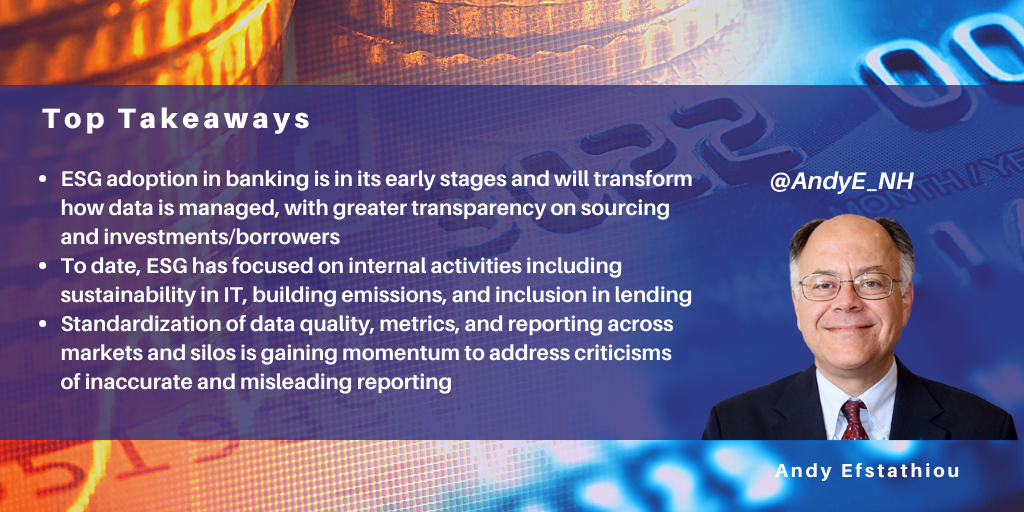
ESG services are an emerging set of tracking and reporting capabilities for enterprises. Emerging technologies do not mature in a straight line but cycle through peaks and valleys of development and adoption as they mature. In the past year, ESG services have passed from the euphoria stage of market adoption to the valley stage as the hype has been confronted by the real-world challenges of failure to meet expectations and outright fraud in some cases.
I am currently conducting a market assessment of how ESG services are transforming the banking sector, and here are some early findings.
ESG in Banking: early findings
The financial services industry is an early adopter of ESG reporting due to regulations that set implementation deadlines, and because of the data-heavy nature of the business.
Adoption is currently immature but is growing rapidly. Financial institutions are applying 60% of their efforts to environmental services, 30% to social services, and 10% to governance services. Social and governance initiatives are growing faster than environmental initiatives.
Currently, 70% of banks’ ESG initiatives are internal business activities, 20% investing and lending, and 10% supply chain activities (banks have small supply chains relative to manufacturing, wholesale, and retail).
Also, 80% of ESG activities have been focused on reporting, primarily for regulatory purposes. The remaining 20% of activities have focused on mitigating adverse ESG outcomes. As financial institutions are enabling better reporting, they are now accelerating their mitigation efforts.
Adoption is highest in Europe because its regulations are stricter than in other geographies, with earlier implementation deadlines. North America has the second highest level of ESG adoption. Regulations for ESG adoption in North America and Europe generally follow the same principles, with Europe implementing its regulatory deadlines earlier and with higher remediation hurdles. The rest of the world lags behind these two markets in adoption and has far less consistency in applying principles.
The adoption of ESG services in banking is concentrated in the following processes:
- Green IT: banks do not engage in manufacturing but manage large amounts of data. As such, their primary activities are delivered by IT systems. Reducing a bank’s carbon footprint in IT services is the primary path to increasing sustainability in bank operations
- Inclusion in lending/saving: a large percentage of all populations do not have formal banking relationships. Banks are reaching out to underbanked people as part of their social initiatives to provide banking services to unbanked consumers. The country with the highest level of activity in this area in India
- Rating investments based on ESG criteria for wealth and asset managers. This has been driven by regulation and customer preference. Sourcing, managing, and reporting the data is a massive undertaking, the buildout of which remains ongoing
- Rating carbon emissions data for real estate (buildings). Banks own, invest in, and finance real estate. Sourcing, managing, and reporting this data is more mature than for investments, but it is still an area that is growing
- Governance: financial institutions have fiduciary responsibilities to customers and regulators. Adapting their internal governance systems to deliver better ESG performance has been an area of growing importance over the past several years. Governance engagements are focused on consulting and change management activities.
Areas of emerging adoption include:
- Green lending: banks are experimenting with lending programs that provide a reduced interest rate when the borrower meets specific ESG requirements
- Standardizing metrics for evaluating the sustainability of suppliers and investments. Much of the pushback on ESG comes from using metrics that do not accurately reflect a company’s sustainability, such as greenwashing. Banks and ESG services vendors are working to identify relevant data and scrub it to make it a better indicator of an enterprise’s actual sustainability
- Standardizing the approach to ESG across lines of business and countries. Currently, multi-national banks have very different approaches to ESG issues across these silos. Banks are moving to standardize their approach to enable brand integrity and build a globally optimum response to ESG challenges.
Many ESG engagements are enhancing banks’ data management capabilities to assess and report on emissions. Below are two examples.
Case 1: British multinational bank and Capgemini
- Challenge: The client wanted to modernize its ESG data operating model and rationalize its data feeds on the emissions in its lending portfolio
- Scope of services:
- Built an ESG data store to measure the bank’s financed emissions
- Enabled tracking at the portfolio level
- Designed target operating model to deliver greater flexibility to changing regulations
- Designed data governance framework
- Benefits:
- Reduction in data sources: 50%
- Cost savings: $1m per year in third-party data sourcing spend
- Improved tracking and analytics capabilities
Case 2: Large capital markets firm and Infosys
- Challenge: The firm wanted to enhance its ESG data management for investments, and wanted to be able to:
- Ingest ESG investment data, validate it, and prepare it to be consumable at the issuer level
- Manage the large and variable number of structured and unstructured ESG data sources
- Scope of services:
- Created roadmap, conducted downstream impact analysis on consumption of ESG
- Vendor solution validation
- Implementation of ESG investments platform on AWS cloud
- Implemented NLP-based AI algorithms to support both structured and unstructured data
- Benefits:
- Productivity gain in data analysis: 50%
- Mapped 5k issuers
- Validated statistical accuracy of 400 ESG metrics
In December, I will be publishing a market assessment of ESG activities in banking, “Transforming the Banking Industry with ESG Services” which will delve deeper into how this global initiative is developing, what banks are doing to address these challenges, and how technology services vendors are supporting this transformation. Though this is a transformation that is still in its early stages, banking is one of the industries making the change quicker due to the regulatory deadlines it faces and its high use of IT services in all its business lines.
]]>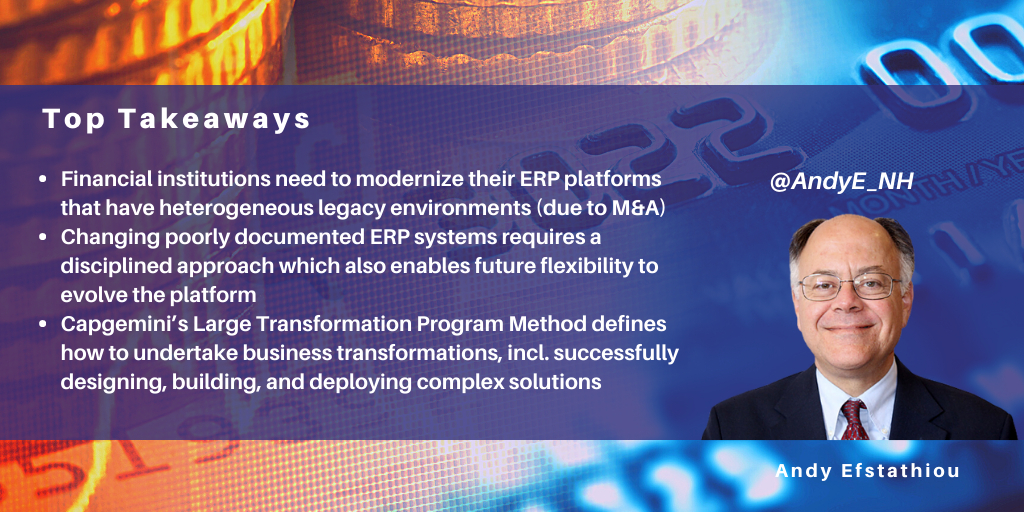
Financial institutions use legacy ERP solutions to monitor, control, and report on their business activities. At large institutions, most of these solutions were deployed in the 1990s and have inflexible architectures that need the requisite functionality to report on modern products, regulations, and industry practices. In this blog, I look at how Capgemini is helping clients tackle this challenge.
The Challenge
All financial institutions need to modernize their platforms because they have heterogeneous legacy environments due to M&A and an operational environment organized by product lines. In addition, differences in regulations and technology availability have required platform customization for each market. The market share for ERP solutions varies by sub-industry and specific market. The heterogeneous nature of all these systems makes consolidating product lines and general ledgers very difficult and often requires manual intervention.
In addition, these legacy systems face challenges, including:
- New regulations, such as IFRS 15 for banks and IFRS 17 for insurance companies, that will necessitate modernizing ERP platforms to remain compliant
- Legacy ERP systems do not have the functionality to track and report ESG issues. CFOs and all senior executives are beginning to implement ESG programs in their institutions and need to modernize their ERP systems to support ESG initiatives. Future system requirements for ESG services are not defined, so today’s platform renewal must enable flexibility to introduce new functionality with minimal disruption to the existing platform
- CFOs must close books quickly with data that provides one version of the truth. When the company decides to reorganize itself, the executives must be able to restructure systems across the new organizational structure and still generate the same reporting numbers. Today, with legacy EPR systems deployed in the 1990s, that is not the case.
As these market conditions continue to evolve, ERP solutions should be able to adapt quickly with minimal disruption to remain relevant.
Capgemini’s Approach to ERP Renewal
Capgemini has developed a program for ERP renewal in financial services to address this challenge in partnership with significant solution vendors. The program is customized by sub-industry (i.e., banking, capital markets, P&C insurance, and life insurance). Today, Capgemini partners with three solution vendors to address these problems: SAP, Oracle, and Workday.
Executives who buy these services are typically the CFO, CHRO, or CPO (Chief Procurement Officer).
Capgemini’s offering to modernize ERP platforms has five components:
- Assessments and roadmaps
- Implementation services
- Integration services
- Migration to the cloud
- Application management services.
During modernization, Capgemini rearchitects the technology environment to improve efficiency, declutter the environment, and remove customization. This “lift, shape, and shift” process to a cloud environment enables the client to convert from a Capex to an Opex cost model while achieving greater operational agility and a simplified technology environment.
Capgemini uses tools and accelerators to deliver this type of large complex project. The tools are part of its proprietary Large Transformation Program (LTP) Method. The method defines how to undertake business transformations, including successfully designing, building, and deploying solutions that can continue to evolve over time. An LTP is defined as a multi-year, multi-release, and multi-project delivery of solutions that evolve over multiple versions. Typically, LTP projects are globally delivered, requiring multi-tower services from a group of service partners. Typical benefits include productivity improvements of ~20% and cost reductions of ~30%.
Client Example
To illustrate how this is done, let’s look at an engagement with a leading multi-national, universal bank headquartered in London that wanted to transform its finance activities around an integrated general ledger (S4HANA) across multiple countries.
Business situation
The client wanted to modernize systems for country ledgers, A/P, A/R, project accounting, and fixed assets. The goals for the project were:
- Standardization and centralization of business processes
- Integration to feeder systems (e.g., T&E, B2B commerce, etc.)
- Integration of data platforms to risk data platform
- Enhance planning, budgeting, and financial closing systems using SAP FSDP to enable faster closing
- Improve cost allocation, profitability reporting, and transfer pricing capabilities.
Project scope
Capgemini delivered the following:
- An offshore COE for SAP S4HANA to support project delivery and ongoing maintenance and support
- Implementation of a Finance and Risk Data Platform
- Finance and profitability reporting using the client’s product data fields to allow franchisees and sales teams to receive accurate commissions on financial product sales
- Common data definitions and quality metrics to facilitate accurate data feeds across all bank systems.
Impact
The project delivered the following results:
- Center of excellence built with 98% offshore resources, which significantly reduced costs
- Reduced synchronization data from third-party systems to S/4 by 90% with 100% error-free status
- Implementation of Solution Manager automated job monitoring resulting in a 70% reduction in manual effort
- Migration from an HEC environment to a Hyperscaler environment reduced costs by 50%
- Reduction in manual effort and cost from move to cloud delivery
- New architecture makes implementing future platform changes easier and supports future business growth.
Summary
Large financial institutions have complex, heterogeneous legacy ERP systems that must change to address current market demands. Further, these systems will need to continuously evolve to remain relevant. Changing these poorly documented systems is a nightmare without a disciplined approach. Capgemini has developed an offering that cost-effectively addresses this challenge and enables financial institutions to improve user experience across employees, partners, and regulators.
]]>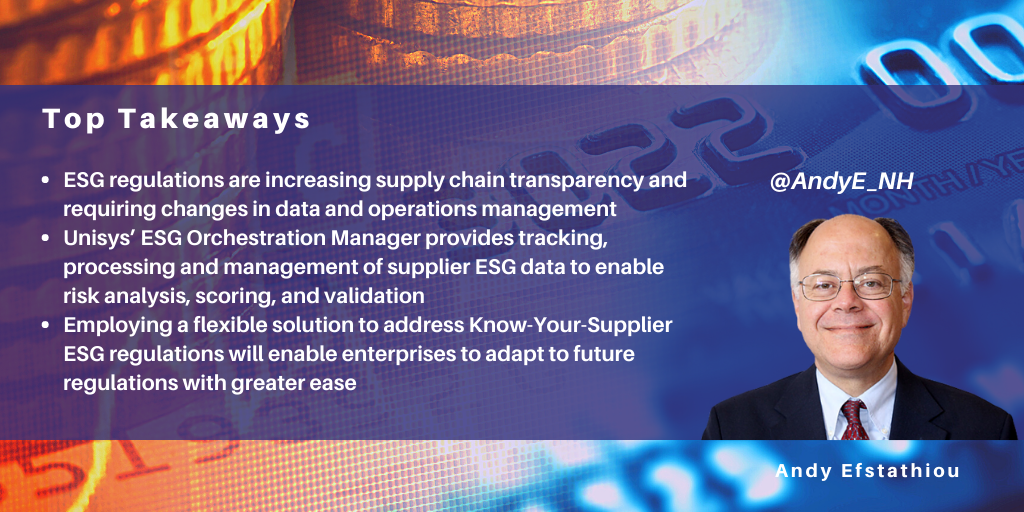
Compliance is driving the adoption of ESG initiatives by enterprises, and currently Europe is ahead of other markets in the rigor of its ESG-related legislation and regulatory code. In this blog, I look at what Unisys is doing to make it easier for enterprises to comply with Germany’s Supply Chain Act.
Background
In 2023, several new regulations have increased compliance requirements in Europe. These include:
- Germany adopting the German Supply Chain Due Diligence Act (Supply Chain Act), effective January 2023. The law requires companies to observe basic human rights standards in their supply chains. Currently, the law covers direct suppliers. The EU is working on a law, Corporate Sustainability Due Diligence Directive (CSDDD) which will cover indirect suppliers and is applicable to all EU states including Germany; it is estimated to become effective in 2025
- The EU adopting the Corporate Sustainability Reporting Directive (CSRD), passed in January 2023, which requires EU and non-EU companies with European activities to file annual sustainability reports. These reports need to be prepared in accordance with European Sustainability Reporting Standards (ESRS)
- On January 24, 2022, the European Banking Authority announced new ESG disclosure requirements for EU banks, effective from 2023 and 2024. The requirements include disclosure of assets and activities and their exposure to climate change, customers’ and suppliers’ carbon exposure, Green Asset Ratio (GAR), effective December 2023, and Banking Book Taxonomy Alignment Ratio (BTAR), effective June 2024.
Further regulations are in the works. For example, in June 2023, the European Commission proposed regulating environmental, social, and governance rating providers that provide ESG opinions or ESG scores.
These regulations are increasing costs for all businesses and requiring fundamental data and operations management changes. It is no longer sufficient to monitor one’s operations; now, an enterprise must watch and report on third parties.
Unisys’ Approach to Compliance with the Supply Chain Act
In the past, ESG tracking solutions have been developed with individual modules for each regulatory requirement. Unisys’ approach is to build a single orchestration solution that manages the entire ESG process from a single dashboard. The ESG Orchestration Manager delivers:
- Tracking, processing, and managing supplier ESG data
- Automated risk scoring
- Supply chain transparency.
There are three components to the ESG Orchestration Manager:
- ESG portal: the supplier and whistleblower process for providing and processing relevant data
- ESG cockpit: a dashboard for managing tasks and reporting, including:
- Supplier management
- Whistleblower report processing
- Validation of risk analysis
- Risk scoring reporting
- ESG insights: provides risk scoring, social media monitoring, and digital bill of materials (DBOM), including:
- Risk analysis of suppliers
- Dashboard with geolocated supplier risk ratings
- Risk rules management
- Supply chain risk scoring
- Social media and news monitoring.
The benefits provided by ESG Orchestration Manager compared to previous approaches to ESG regulations include:
- A single solution allowing rapid compliance with this new regulation and providing flexibility to adopt new requirements into the existing solution
- Proactive use of media analysis, mitigating the risk of reputational damage
- Mitigating risk of penalties, which can run to 2% of global revenues
- Providing insights into primary and secondary suppliers
- Facilitating understanding of supply chain dependencies
- Enabling auditing of data.
Conclusion
Unisys’ ESG Orchestration Manager offering fills a need for enterprises to rapidly and inexpensively comply with the first stage of a series of Know-Your-Supplier regulations. The initial cost of compliance is high, but the ongoing cost of compliance will continue to increase.
By developing a flexible solution that can adapt to future requirements, enterprises can reduce their current and future cost of compliance while deriving useful information to drive immediate improved operational performance.
]]>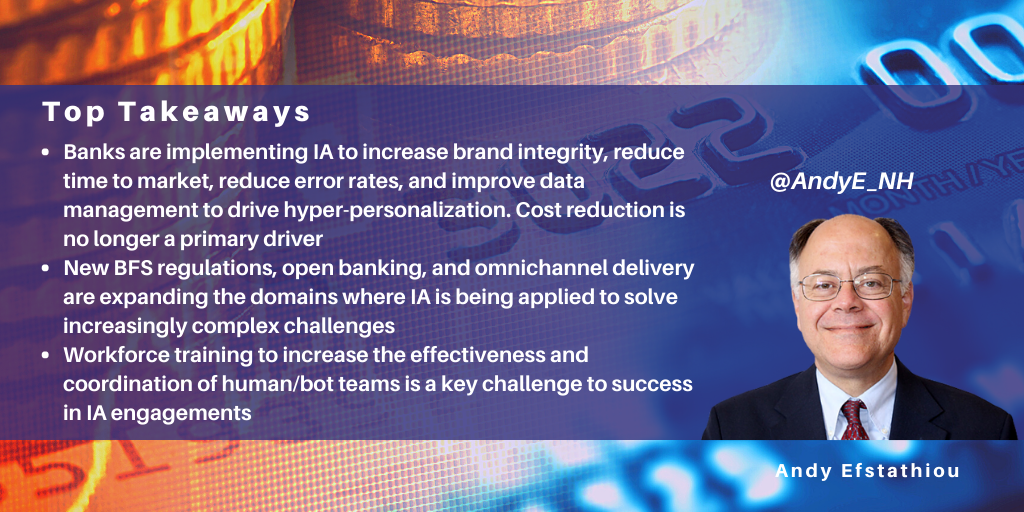
NelsonHall has just completed the research for a market assessment and forecast report on Transforming Intelligent Automation Services in Banking. We found that banks have accelerated the adoption of IA services in operations over the past two years, a shift that has been driven by:
- Declining operating margins on legacy businesses
- Pursuit of new customer demographics to replace the older customer cohort, which requires banks to launch and deliver new products digitally
- Changing business models (primarily to open banking) driven by regulations.
By transitioning operational delivery from manual to digital processing, financial institutions can drive:
- Greater brand integrity from consistent execution
- Faster time to market for new and seasonal products
- Reduced error rates which reduce costs and enable settlements on shortened deadlines
- Improved data management, which enables hyper-personalization.
IA adoption pattern
Tier-one banks have been the primary adopters, with every tier-one bank having an active IA program. Regional banks and industry services providers are increasing their commitment to IA projects. Only 30% of regional banks had IA programs three years ago; today, 75% of these banks have active IA programs. Local banks are where regional banks were three years ago, with 30% having active IA programs. Capital markets firms are late adopters but are beginning to adopt IA services to serve high-net-worth customers and meet reduced settlement deadlines.
The pace of lower-tier banks starting IA programs is accelerating, and three years from now we expect all financial institutions to be fully committed to IA in their business. The growth in clients and project scope will drive growth rates of IA revenues to 16.5% per year for the next five years to 2028. Managed services for IA operations will grow 17% over the forecast period. Growth has been fastest in mature markets, but now the emerging and APAC markets are growing faster than mature ones.
Financial institutions are focusing their efforts on the following:
- Operationalizing IA use cases: banks are deemphasizing the building of POCs to find ways to use IA and are instead concentrating on identifying high-impact use cases that can be operationalized to create value
- Improving data management: banks are changing their focus from improving data management within silos to improving data sourcing, management, and reporting across silos
- Expanding the pool of skilled employees to implement IA: banks are focusing on implementing tools (such as low/no code) that enable non-technical employees with domain expertise to build IA solutions with business impact at lower transaction volumes
- Enabling human/bot coordination and increased effectiveness: these initiatives are the least mature. Currently, banks are coordinating human/bot routines on customer-facing activities (i.e., customer contact, advisory, and lending origination). Banks are beginning to explore human/bot coordination in back-office settings, including settlements, reconciliations, and collateral management.
How vendors are enabling IA initiatives
Vendors are helping clients accelerate their IA initiatives by delivering enablement in four areas:
- Process identification and mapping: undertaking comprehensive process discovery, reengineering, automation, and embedding intelligence into processes that were previously unmapped and manual. The goal is to expand the footprint of automation in operations until all processes are digital or at least touched by digital services
- Data management: delivering three critical areas of data management:
- Data sourcing and scrubbing, focusing on standardizing data across a bank’s silos of products, markets, and sub-industries
- Expanding the range of data banks utilize into voice, image, and unstructured data
- Implementing predictive AI to support customer interactions and service
- Productizing IA offerings: the IA market has developed quickly. Most vendors have capabilities but not productized offerings. Vendors have developed productized offerings in the past two years to support lower-tier financial institutions and bank subsidiaries. These target clients are looking for rapid deployment of best practice capabilities at low cost
- Workforce effectiveness: delivering three areas of improvement:
- Developing IP, which supports employees and stakeholders in delivering IA projects with less training and fewer technical skills. This type of IP includes COEs, accelerators, APIs, low/no-code solutions, and solution libraries
- Training, including online, in-person, hackathons, and academies
- Coordination of worker/bot teams with user journey design tools and training.
Outlook
IA services in BFS are continuing to evolve new offerings and use cases. Developments include:
- New regulations, including:
- Open banking regulations, which will necessitate automating processes with third parties. This will involve integrating processes across counterparties not part of the initial financial institution. Integrating and automating processes across enterprises raises the challenge of coordinating governance
- Instant payments, which require increased automation to reduce error rates and faster settlement
- Faster securities settlement times, which require reduced error rates and faster settlement
- Application of relevant regulations to customers as they move across markets with differing regulations
- Data management, including:
- Management of third-party vendors and agents
- Use of increasingly powerful analytics requiring it to be used judiciously as well as effectively
- Increased application of IA to the omnichannel environment to:
- Increase customer choice of how to interact with banks
- Support customer interpretation of offers with visual and audio information
- Support the financial institution in understanding customer requirements and sentiment from real-time feedback analysis
- Expanding automation activities from customer-facing processes to back office and fulfillment processes. Automation to date has focused on customer interactions. Automation and AI will increasingly be applied to fulfillment processes and integrated into front-office processes.
Increasingly, business value from IA projects is less about cost savings and more about business agility. The ability to bring products to market faster and provide operational support for rapidly changing offerings is more important than cost savings on sunsetting offerings.
]]>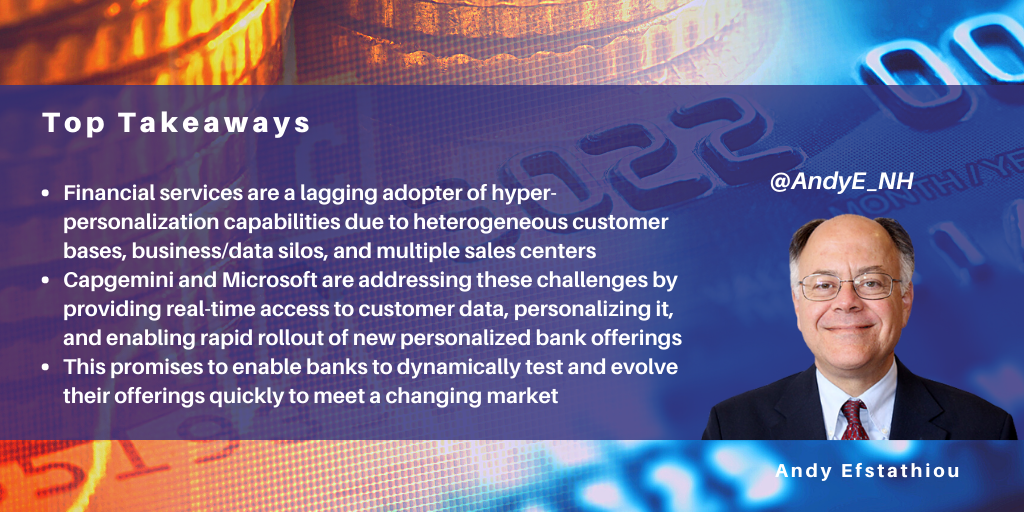
Capgemini has partnered with Microsoft to develop and market a dynamic hyper-personalization offering for the financial services industry. This blog explores how hyper-personalization capabilities can be adapted to the unique needs of the financial services industry.
Background
Enterprises want to increase the personalization of their offerings to customers to increase CSAT and sales success. However, effective personalization is an immature art. Enterprises have been using machine learning (ML) to drive the personalization of sales and marketing offerings to their customers. Still, the challenge of ML here is that the user can only generate incomplete information due to the iterative nature of the trials and limited contextual data. The ML bot can only observe the response to a chosen action but doesn't know the answer for other possible actions (i.e., it cannot analyze hypotheses, it can only analyze historical activities).
One method of increasing the effectiveness of personalization initiatives is using contextual-based ML techniques to improve recommendations. ‘Contextual bandits’ is a technique that reinforces the learning algorithm by using contextual information about the environment to make real-time decisions and using rewards at each step. Microsoft has embedded this technique in its Azure Personalizer solution, which enables enterprises to improve their personalization efforts to achieve better CSAT and sales closure.
The Challenge
Financial services is a lagging adopter of hyper-personalization capabilities. Early adopters are consumer industries, including CPG, consumer electronics, and media. Financial services lag in adoption due to the following:
- Heterogeneous customer bases: at the retail level, banks mix consumers and SMBs into a single practical customer base, which often has the same decision-maker, but differing needs and behaviors
- Multiple sales centers: M&A has led to multiple silos selling and competing with each other with the same products for the same customers. Banks continue to be organized by product lines, which also compete for the same clients from product silos.
These characteristics of the banking environment have made traditional AI and ML techniques a poor predictor of consumer behavior. If banks can apply additional parameters and data to understand consumer behavior better, they can develop improved personalized offers. The challenge in achieving this level of analysis is that the banks need to:
- Integrate data across channels, silos, and sources
- Access data across heterogeneous systems and environments
- Better understanding of customer needs
- Deliver personalized, integrated offers across channels.
Capgemini’s Approach
Capgemini and Microsoft have developed an offering to address these challenges. The contributions from the two companies are:
- Capgemini - IT and business services:
- Financial services solutions and accelerators aligned with Microsoft offerings
- IT services for Azure deployments and Microsoft Cloud for Financial Services
- Access to industry specialist ecosystem
- Microsoft - three software products:
- Azure Personalizer, which provides modeling tools and algorithms to contextualize a user’s content reactions
- Semantic Knowledge Graph, which extracts relationships from data and derives features for use in AI models
- Azure Synapse, a cloud-based analytics tool.
Financial institutions have had difficulty effectively implementing the infrastructure to drive hyper-personalization initiatives. Capgemini works with Microsoft and clients to drive this forward across multiple silos and LOBs. Critical to Capgemini’s activities is the ability to build systems that:
- Use real-time data
- Render the data analysis useable (using the Knowledge Graph)
- Personalize the data
- Develop a real-time trial offer
- Roll out successful offers
- Learn from mistakes in real-time.
Critically, the offering should be able to offer customers the best existing product and suggest new products for development. Suggesting product development is especially important for industry transitions, including the deployment of new regulations and changes in customer buying trends (for example, due to demographic differences). The offering also works with SMB customers, not just consumers.
This offering fills a need for financial institutions to help create personalized offerings for customers, especially from new demographic groups. Financial institutions use AI to analyze past data within silos to develop customized offerings but have not yet been able to create forward-looking offerings in response to changing conditions. This offering promises to enable banks to dynamically test and evolve their offerings quickly to meet a changing market.
]]>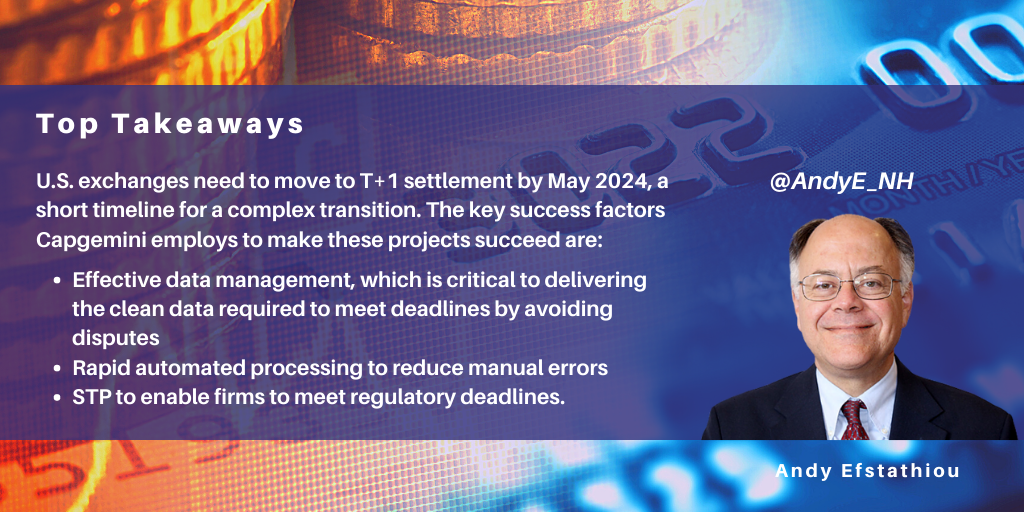
The securities industry is moving towards shorter settlement cycles to reduce risk and increase efficiency. The last reduction in settlement windows in the U.S. was in September 2017 when settlements moved from T+3 (three-day settlement) to T+2. In February 2023, the U.S. SEC announced that all companies trading securities on U.S. exchanges needed to move to T+1 settlement by May 28, 2024. Canada has indicated their markets will align with this settlement timeframe and other global markets are also considering alignment. Eventually, all markets will reduce their settlement times, as they have done in previous rounds, to remain competitive globally.
In this blog, I look at the challenge of shorter settlement cycles and how Capgemini is helping clients tackle the challenge.
The Challenge of Shorter Settlement Cycles
Reduced settlement times provide two primary benefits:
- Reduction of margin required to be posted at DTCC to insure against the risk of adverse market moves during the settlement period before security is delivered
- Increase in capital available for reinvestment in businesses, due to the above reduced margin requirements and access to settlement funds one day earlier.
However, there are risks to counterparties in implementing shorter settlement times. Major risks include:
- Shorter deadlines require greater accuracy and faster processing of trades. This means financial institutions need to increase their automation of settlement processes to reduce manual error and increase execution speed
- Trading in multiple markets, with different daily deadlines, means the effective daily deadline is even shorter for certain multi-market trades. The cost of an error and the difficulty of syncing counterparties is much more difficult than in a multi-day settlement process (and will be exponentially more difficult under a T+0 deadline). Again this places more pressure on settlement systems to be fast and accurate
- Ancillary activities, especially securities lending, are heavily impacted. Securities lending are likely to generate a higher level of fails, and fails can eliminate all the profit from the lending contract. Again, the new process will need to be robust enough to reduce fails to a level where lending activities are not driven to be unprofitable
- Trading volumes are not spread out evenly during the day. The majority of trades typically occur near the end of a trading session. Batch processing of trades under a shorter deadline is likely to have an adverse impact on the ability to affirm trades. In a T+1 environment, there is simply much less time to take most of the trade volume and process it in the window available.
Transforming legacy settlement systems in the 12 months remaining to go-live will be difficult. Depository Trust and Clearing Corporation (DTCC), which provides clearing and settlement services to the U.S. markets, recently surveyed its clients and found that over 50% are unsure they can meet the deadline. Most will have to turn to third-party help to implement the complex process and infrastructure changes required.
Capgemini’s Approach
Capgemini has built an offering to support industry participants looking to transform their legacy environment in time for the deadline. The key components of this offering are:
- Readiness assessment: assessing the client’s legacy platform, which requires highly specialized knowledge due to the nature of capital markets' post-trade systems
- Solution design and implementation planning: designing solutions that increase post-trade automation and implement these solutions on top of the existing platform
- Implementation: implementing a regulatory-compliant solution in an environment that is delivering high-volume ongoing services daily
- Testing: internal testing to assure success with the custom internal platform and external testing to coordinate with industry and regulatory partners
- Post-go-live remediation: to fix flaws and upgrade solutions over time
- Managed services: ongoing support as required and/or full outsourcing.
The key success factors for these projects are:
- Effective data management, which is critical to delivering the clean data required to meet deadlines by avoiding disputes
- Rapid automated processing to reduce manual errors
- STP to enable firms to meet regulatory deadlines.
Delivering these services successfully in a compliant fashion requires industry experience and a methodical plan to address each participant's custom environment. Achieving a compliant launch for complex custom systems in a 12-month timeframe, when over half of the participants are unsure they can meet the regulatory deadline, will require participants to use best practices as soon as they evolve within the next 12 months.
The business impact of successfully transitioning to shorter settlement deadlines is that counterparties will free up working capital to reinvest in their businesses. Collectively this will generate greater industry liquidity and reduce transaction costs for both investors and issuers. Greater market liquidity will allow more efficient markets to put more capital in both investors’ and issuers’ pockets.
Support from third parties will assist organizations with industry coordination and best practice adoption on this fast-track systems conversion project. Capgemini is well placed to capitalize based on its new offering and its track record in successfully assisting clients with T+3 to T+2 transition.
]]>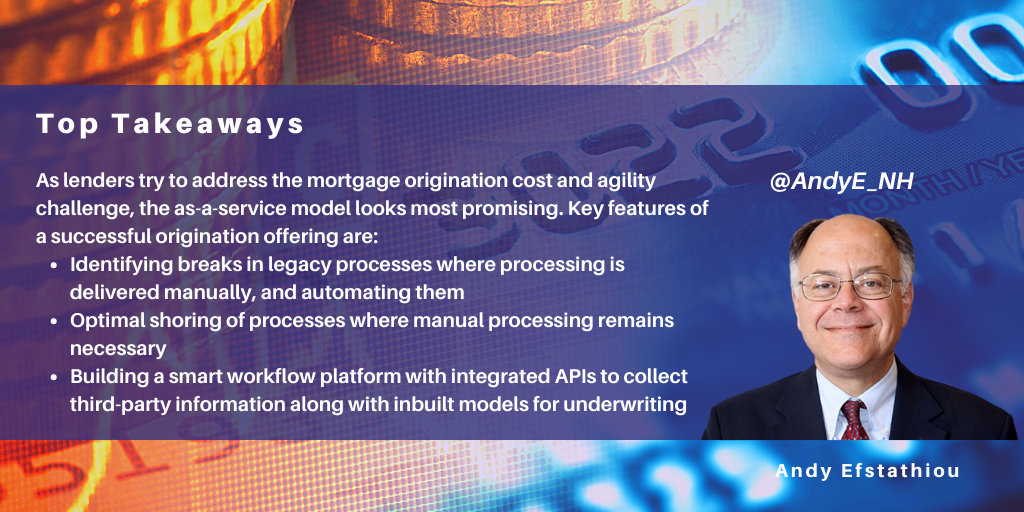
The lending business is highly cyclical due to its sensitivity to interest rates, economic cycles, and capital availability to fund loans. According to the Mortgage Bankers Association, these factors are currently driving down mortgage originations, which have fallen 60% y/y in the U.S. in Q4 2022.
The decline in originations pressuring the margins of this high-cost activity is the leading change in the industry. Delinquencies, while currently low, are expected to grow rapidly over the next year as the economy slides into an anticipated recession. Banks need to increase their agility to deal with these volume shifts cost-effectively. There are two key levers to address the shift in processing volumes:
- Automation, which enables an absolute reduction in OPEX based on upfront investment
- Outsourcing, with committed volume flexibility, enables the matching of revenues and costs.
Of the two, the more compelling savings can be made from automation, as long as transaction volumes across the entire business cycle can justify the initial investment. Mortgage origination is a clear first choice for automation because:
- The cost of mortgage origination in the U.S. is typically 10x the cost of servicing ($5k to $10k per loan in the U.S. depending on product complexity and lender platform maturity)
- Origination remains mostly a manual process. Most Loan Origination Solution (LOS) platforms in the market are providing only partial STP processing, relying mostly on manual sub-processes
- Originations are highly cyclical.
Lenders and services vendors are trying to address the mortgage origination challenge, and while no single model has won the market, the as-a-service model looks most promising.
WNS has developed a mortgage-as-a-service (MaaS) offering, working with mortgage lenders for years, and has identified many typical breaks in legacy processes where processing is manually delivered. Critical to the success of a MaaS offering is bringing the most effective resources to bear at each step of the process. The choices include:
- Intelligent Automation of manual processes, where possible
- Optimal shoring of processes, where manual processing remains necessary
- Flexibility for clients to opt for unit-based pricing model
The key steps in the origination process where MaaS transforms processing are:
- Pre-processing and sending initial loan estimate: after receiving the application, the MaaS delivers an initial loan estimate within three days. All offshore delivery
- Third-party orders: auto-triggered order checks including flood, credit, verification of employment, verification of deposit, title, mortgage insurance, appraisal, fraud, etc. All offshore delivery
- Document validation: documents have data extracted and are converted to a digital loan file. Exceptions are handled manually. All offshore delivery
- Conditions management: decision engine and underwriting, automatically raising conditions for consideration by loan officers. Combined onshore/offshore delivery
- Document reviews: review and analysis of income, collateral, asset, title, Agreement of Sale, and fraud. Combined onshore/offshore delivery
- Approval: onshore lender works with the offshore team to approve the loan package. Combined onshore/offshore delivery
- Loan closing: LE and CD prep of documents; schedule closing with the title company. Combined onshore/offshore delivery
- Transfer to servicing: digital loan file transfer to servicing platform. All offshore delivery.
The backbone of the MaaS offering is a combination of
- Smart Workflow platform with integrated APIs to collect third-party information along with inbuilt models for underwriting
- Intelligent automation powered by RPA and Artificial Intelligence.
The MaaS service integrates with the client LOS platform and digital front end to deliver services to bank customers. Because the offering is modular, clients can buy point solutions to automate individual components of the origination process.
Technology is necessary, but not sufficient for successful transformation of the loan operations process. The human element is a critical component of the success of the MaaS offering. The MaaS offering incorporates the development and utilization of talent with a comprehensive understanding of the mortgage process, associated challenges, and parameters of compliance and non-compliance. Initial and ongoing training and examinations in end-to-end loan review including compliance measures are required to continually improve the quality of performance and service levels that complement the areas of automation.
WNS’ MaaS offering has been delivering lenders benefits including:
- Productivity gains of 3x from automation and global delivery
- Customer inquiries and complaints: 50% reduction
- Reduction in loan origination costs: 40%
- QA/QC processes eligible for automation: 70%
- Loan final closure in 15 to 20 days.
These benefits are especially compelling as origination volumes decline and a MaaS service connects costs to revenues, allowing for costs to decline as volumes plummet. We expect to see the industry produce more MaaS offerings as the economy continues to shift. Early vendors, such as WNS, will have more mature offerings as lenders shift to outsourced as-a-service operations models.
]]>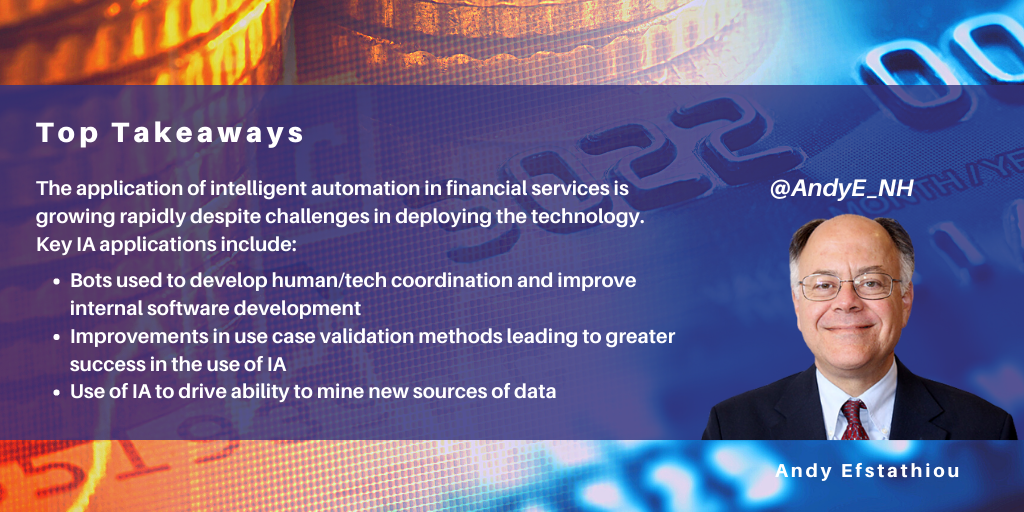
In the financial services industry, there was an initial expectation that demand for intelligent automation (IA) would fall off as clients changed platforms and moved to a microservices architecture. Instead, the application of IA in financial services has grown rapidly. The initial evidence from my current study shows that despite challenges deploying the technology effectively, the ability to bring decision making to the line-of-business user at a low cost of implementation makes a compelling value proposition.
Despite its ability to accelerate accurate, transparent process execution, implementing IA effectively is challenging. Key challenges include:
- Use case failure rate: the majority of use cases have not met their promised returns. Most POCs have not been operationalized. Increasingly, ITS vendors have had to build COEs and use case libraries to increase the cost effectiveness of IA projects. Success rates are rising, but only where ITS vendors are able to marry client operational knowledge with industry best practice
- Orchestration of bots: operations is a dynamic environment and bots are unable to reskill or change jobs without advanced orchestration services. Performance degrades rapidly in a poorly orchestrated environment
- Dynamic nature of business processes, including cyclicality, reengineering, and sunsetting: the tempo and structure of operations changes with time, requiring continuing process reengineering and new use case development
- Heterogeneous core banking platforms: most banks today are an amalgam of multiple platforms. Deploying automation across multiple environments and architectures requires process discovery, reengineering, and consolidation.
Despite these challenges, IA activities have taken off because:
- Banks lack sufficient investment capital for full platform replacement
- Bots have benefited from increasing functionality, mostly due to increased AI capabilities, which enable them to deliver greater value. For example, banks need to increase their employee productivity. The AI used for bots has been used to develop human/tech coordination capabilities which have enabled better customer interactions and improved internal software development
- Technology services vendors and banks have improved their use case validation methods, leading to greater success in operationalizing initiatives.
Over the past several years, as automation services have matured, banks have begun narrowing the number of processes they are spending resources on automating. Processes where IA is increasingly applied are:
- Technology development, especially software development
- Customer contact, especially human/bot delivered contact; often focusing on support for independent agents (such as third-party mortgage originators or independent wealth advisors)
- Cyclical processes, such as loan originations/collections, payments, and portfolio due diligence
- Compliance, with a heavy focus on KYC and AML processes
- Data management, especially in mining new sources of data (from social media and third-party data vendors).
IA adoption will continue to grow faster than overall technology adoption in the financial services industry because banks need to move fast to deal with rapidly declining margins and the need to change their business models. Automation vendors are remaining relevant in this developing market by investing heavily in building more AI functionality. Vendors who are struggling are the ones who have failed to embed robust new AI functionality in their offerings. Ultimately, intelligent automation is less about process automation and more about helping banks orchestrate their labor forces and business partners to deliver service to customers.
]]>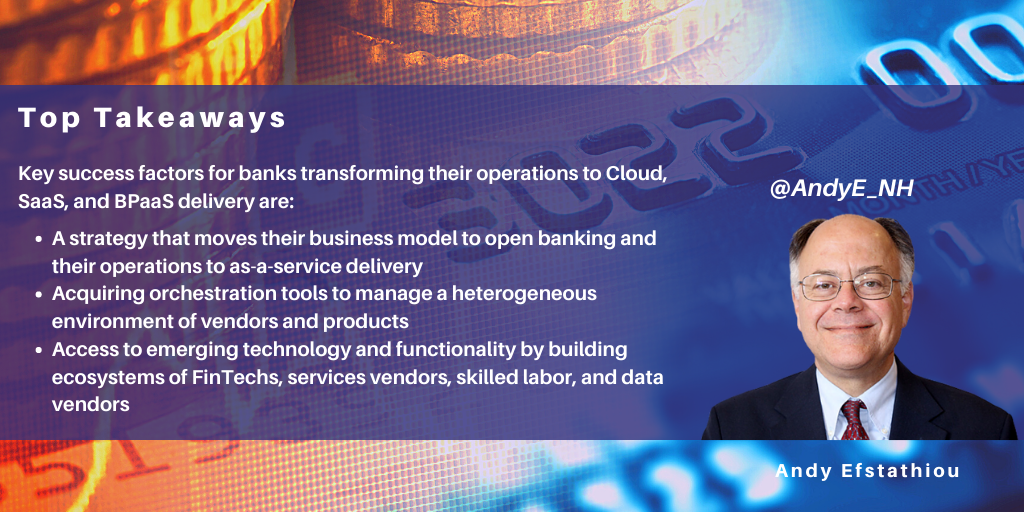
NelsonHall recently completed a market assessment and forecast report on Transforming Financial Services with Cloud, SaaS, and BPaaS Services. It reveals that the financial services industry is responding to the industrialization of cloud services from hyperscalers and IT services vendors by transforming its platforms to microservices architectures and then moving them to the cloud. Data management across markets, businesses, and entities has moved to center stage to drive compliance and customer management.
The operational transformation challenge
Tier 1 banks are looking for increasing operational agility with migration to cloud and as-a-service delivery. Smaller banks require productized solutions and SaaS/BPaaS services. All banks are increasing their data management and AI purchases. In the future, banks will move towards SaaS and BPaaS to reduce labor costs and increase the configurability of their businesses. Operational delivery will become agile to support reducing time to market and accommodate volume fluctuations.
However, the external environment has put up barriers to transformation. The key barriers impeding banks’ transformation efforts include:
- Platform modernization: legacy mainframe platforms need to be redesigned into a microservices architecture. Finding teams that can work with both legacy and modern languages is difficult
- Data management and analysis: effective use of AI requires large databases from which to derive insights. Most bank portfolios are too small to generate large data sets for meaningful analysis
- Accessing emerging technologies: skilled labor remains in short supply and worker turnover has made it worse
- Creating a roadmap: new business models require experimentation and agility, which large banks find difficult to undertake effectively.
Financial institutions must adapt transformation strategies
To transform their businesses, financial institutions will have to:
- Create a strategy that moves operations to the cloud and matches costs to revenues to enable greater agility. They will have to change their business model to an open banking model
- Build an ecosystem of operational vendors including: hyperscalers, with each one providing services in their area of expertise; IT services vendors with knowledge of the client’s environment; and FinTechs with key functionality
- Redefine the split of operations between external processes (high value, cyclical or one-time) and internal processes (lower value/less volatile)
- Acquire orchestration tools to manage a heterogeneous environment of vendors and products
- Transform application development to a DevOps and low/no code model to speed the innovation cycle and enable LOB staff to have greater input.
Services vendors are supporting clients with different services for each environment:
- Cloud: support for entering new markets and enabling open banking
- SaaS: data management tools, analytic tools, and data and solution provider partnerships
- BPaaS: offerings focused by line of business which have high volatility (e.g., collections and securities)
- Platforms: provision of low code/no code DeFi coding capabilities, APIs to solution/data vendors and industry consortia, enhanced solutions with hyperscaler partnerships, and orchestration tools to manage hybrid multi-cloud environments.
Summary
In summary, high competition and regulatory change is driving banks to focus on changing their business models and product mix. The change to shorter product cycles and lower margins means banks changing their operational focus from cost efficiency for fundamentally static businesses to agility for continuously changing businesses. Cloud, SaaS, and BPaaS infrastructure will drive accelerating change in banks’ product offerings, customer base, and market presence. The financial industry is at the start of a long-term transformation of its business model.
Find out more about NelsonHall’s Transforming Financial Services with Cloud, SaaS, and BPaaS Services market assessment and forecast report here or contact Guy Saunders.
]]>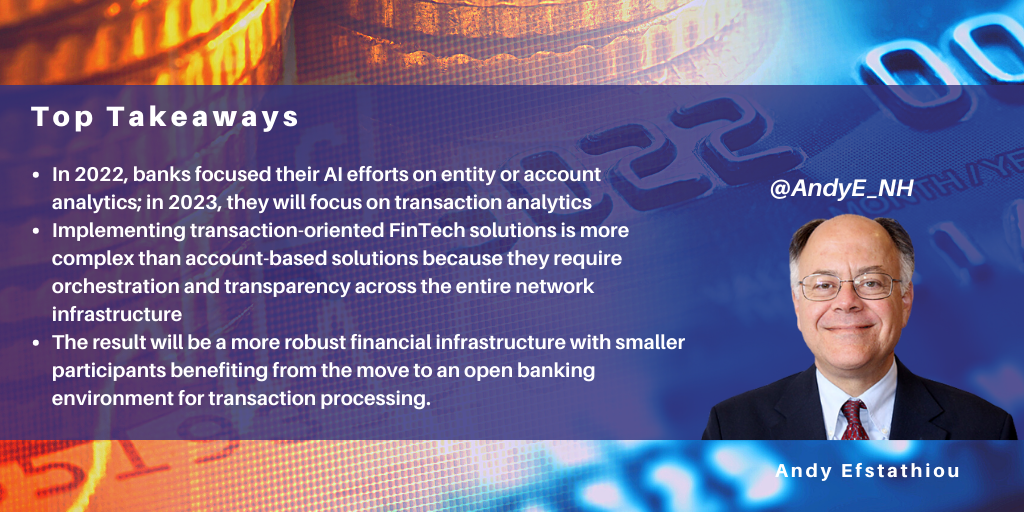
2022 has been a very strong year for IT services firms delivering cloud, digital, and AI services to the financial services industry. 2023 looks to be a very different year for these vendors as they are finding it difficult to hire skilled resources, find clients able to fund new large projects, and partner in strategic growth areas. Successful BFS technology consultants will need to focus limited resources in a few key growth areas to have a successful business in 2023. One strategic area for growth will be implementing transaction processing AI and data management tools.
To date, banks have focused their AI efforts on entity or account analytics. Typically, these tools provide customer service (e.g., customer onboarding and next-best recommendations) and compliance support (e.g., AML/KYC). We believe in 2023 banks will turn their compliance and customer analytics focus from entity analytics to transaction analytics. Financial institutions are driven by evolving regulations, which today are emerging faster from Europe than other geographies. Europe has several new regulations which are driving a change in focus to transaction monitoring. These include:
- The Digital Operations Resiliency Act (DORA): DORA seeks to mitigate the risk of cyber attacks on financial operations. Previous regulations took a balance sheet-based approach to risk mitigation by requiring capital buffers to address operational risk. DORA takes an operational approach to mitigating risk by requiring technology (i.e., cloud, supply chains, and IT outsourcers) to operate with transparency, rigor, and resiliency. The act was published on 11/17/2022, will come into force by Q1 2023, and financial institutions will be required to have implemented it by Q4 2024.
- A pilot regimen for market infrastructure in DLT: Passed June 2, 2022 by the EU, this regulation covers trading of currencies/securities using blockchain technology in multilateral trading facilities and settlement systems
- Regulations governing real-time payments/transactions: regulations include PSD2 and various securities settlement regulations, which have been shortening the settlement windows for various securities transactions towards an ultimate goal of instant transactions. Platforms need to move from batch processing to real-time processing with improved security and risk management to mitigate fraud and credit risk. An example of real-time payments implementation is the launch scheduled for summer 2023 of FedNow, the Federal Reserve bank’s instant payment service.
These regulations will drive securities exchanges, payments networks, banks, and capital markets firms to deploy cloud orchestration and AI FinTech tools to improve security and reduce operational risk. Already financial institutions are starting projects to address these challenges. Examples include:
- Goldman Sachs Transaction Bank (GS TxB): On Sept. 15, 2022 GS TxB announced a partnership with Stripe to provide corporate treasury services with embedded finance (the ability to make payments as part of the treasury application). This service requires APIs and AI to manage and deliver transaction flows safely and securely.
- State Street Bank launching a peer-to-peer repo program for the buy side to reduce the cost of collateral management, which is a critical trading cost. This facilitates bilateral trading by counterparties with varying credit and capital strength.
Implementing these transaction-oriented FinTech solutions is more complex than account-based solutions because transaction-oriented solutions require orchestration and transparency across the entire network infrastructure. These projects will be driven by the market exchanges and tier one institutions, but will require cooperation from all market participants.
The result will be a more robust financial infrastructure with smaller participants benefiting from the move to an open banking environment for transaction processing. The promise of safe digital payments in a decentralized environment will not be achievable without these investments in securing the industry infrastructure. The industry and regulators are committed to delivering on the promise, so the implementation work will start in 2023.
]]>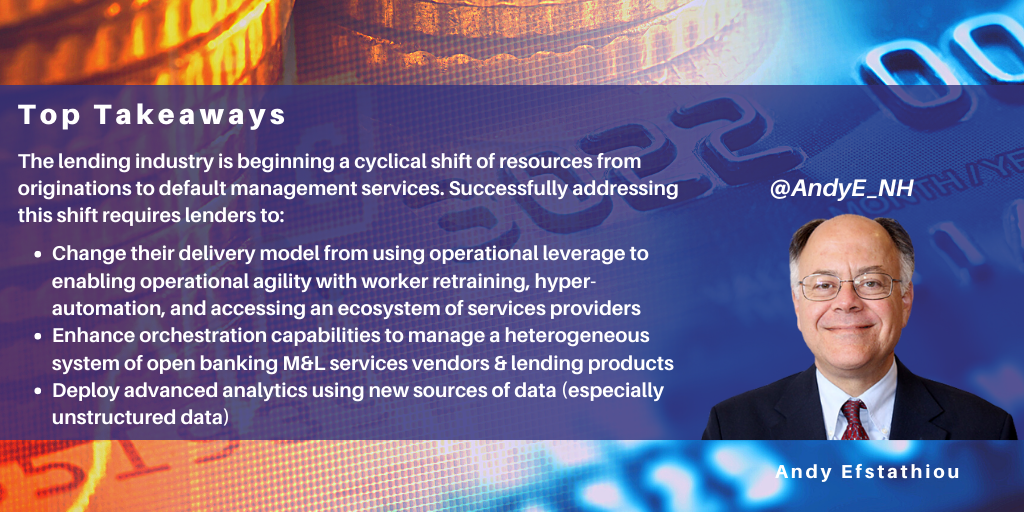
In NelsonHall’s recently published market assessment, Transforming Mortgage and Loan Services, we found that lenders are changing their approach to mortgage and loan operations from a focus on BPS and integration services to a focus on cloud migration and data management services.
The goal for lending institutions today is to be able to support open ecosystem models, new product introductions, and process automation delivered for a wider range of lender types based on cloud-delivered operations. The pace of industry change is increasing, while the industry begins its cyclical shift from a focus on originations to default management services. The shift to cloud and digital-first delivery has expanded the scope of transformation projects as more processes are opened to third-party partners.
The state of digital operations in the lending industry
For the past year, lending institutions have been:
- Implementing intelligent automation to reduce manual processing and increase accuracy
- Migrating to a hybrid cloud to increase flexibility for new functionality and product time to market
- Building data lakes to coordinate data across silos without replacing their entire data structure
- Providing customers with self-service tools to reduce the cost of delivery and increase CSAT with faster resolutions.
Today, financial institutions anticipate an aggressive decline in originations and increase in lender defaults. This will necessitate downsizing originations and growing default management capabilities. To meet this market shift, over the next year, financial institutions will focus on:
- Increased use of consulting and combined ITS/BPS to identify a road map and convert CAPEX to OPEX
- Reskilling of origination workers to default processes to scale up default work
- Rearchitecting the lending platform to a microservices-based cloud-native application with an architecture that could integrate into their other platforms
- Testing and running open banking environments to start building an ecosystem of participants and a library of business models.
However, the external environment has put up barriers to transformation. The key barriers impeding the efforts of financial institutions include:
- Useful adoption of analytics: new sources of data (especially unstructured data) provide greater opportunities for the use of AI. However, only tier one lenders have access to large internal data pools. Smaller lenders must draw from industry-wide data pools. Smaller markets and product runs present similar issues: developing quality data for analysis remains difficult
- Access to emerging technology: all service vendors are building ecosystems for emerging technologies and acquiring staff skilled in relevant technologies. Finding the best new technologies and embedding them in effective platforms remains difficult
- New products and markets: lenders are rolling out new loan products rapidly, requiring a response from other lenders in order to remain relevant. The new products require high automation, omnichannel access, and high compliance capabilities
- Access to qualified staff: changing technologies change the required mix of staff skills, and distributed work environments (primarily WFH) limits knowledge transfer. Currently, cloud migration, AI, and default management skills are the least available capabilities.
Rising to the challenge
To address these challenges successfully, lending institutions need to focus on two activities: strategy and process execution.
Key factors in strategy include:
- Creating a roadmap to move operations to the cloud and match costs to revenues, as origination volumes decline and collections volumes grow
- Changing the operational model: M&L managers need to shift from operational leverage to leveraging agility (the ability to cost-effectively switch out workloads). This requires increased process discovery to identify processes for automation. The business model needs to support an open banking environment
- Building an ecosystem of operations vendors with domain knowledge and experience with clients’ operations environments, vendors with complementary digital skills to deliver services, and the ability to work within client operational practices and transfer knowledge.
Key factors in process execution include:
- In the short term, staff training to renovate skills for cyclical issues (i.e., default management) and technology (FinTech, cloud, and IA)
- Preferred services vendors should have the widest pool of Fintech solution providers supporting them
- Data management and orchestration drive accuracy, efficiency, and compliance. Lenders need to build COEs and libraries of successful RPA and data management use cases
- Transforming application development to a DevOps and low/no code model to speed the innovation cycle and migrate to cloud delivery
- Orchestration: selection and implementation of orchestration tools to manage a heterogeneous system of (open banking) M&L services vendors and lending products.
In summary, lending institutions are changing their goals from improving process efficiency for originations to increasing operational agility across sub-processes and ramping up collections capabilities. Margin pressure is too strong for lenders to achieve their business goals with just operational efficiency enhancements. Lenders need to change their business models (from closed platform/static product offerings to open platform/evolving product lines) to enable them to access best practice, best-cost services on-demand, to drive their operational performance.
]]>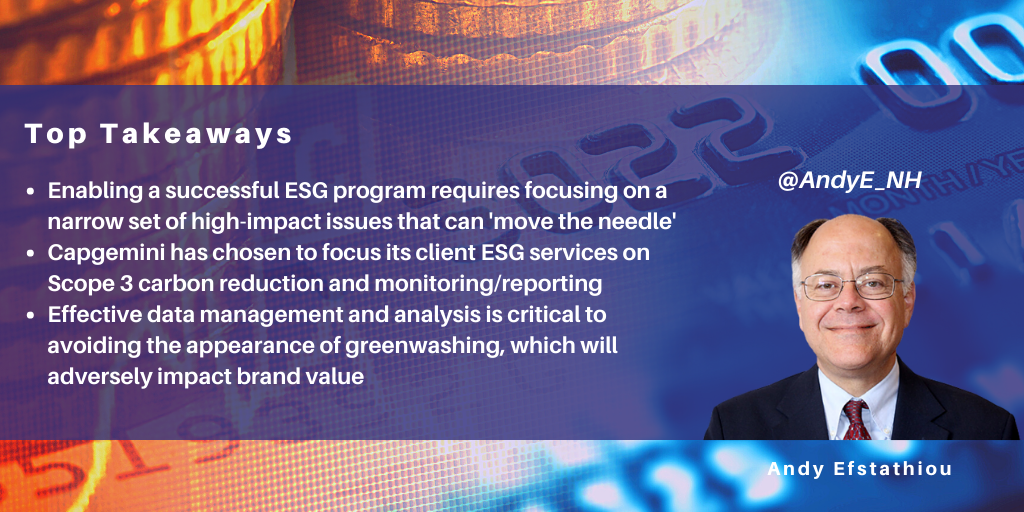
ESG is a hot, but poorly defined, topic. Many firms and investors have started ESG programs, but recent allegations of “greenwashing” and ineffectiveness have undermined confidence in them. So, what are the components of an effective ESG program? ESG is a wide set of dissimilar goals (e.g., carbon emissions reduction is very different than social inclusion). By focusing deeply on a few goals, enterprises can drive more profound change while building the framework for expanding the range of ESG activities as an ESG initiative matures. With this in mind, Capgemini has developed a set of ESG services to enable clients to methodically design a roadmap for establishing goals and improving their ESG performance.
Capgemini and ESG
Capgemini began its ESG journey by focusing on carbon emissions reduction. It has built a framework for pursuing its goals and is committed to achieving carbon neutrality by 2030. The focus of its ESG efforts is:
- Reducing/neutralizing carbon footprint (it has committed to carbon neutral operations by 2025 and being a net zero company by 2030)
- Reporting on ESG scores to the marketplace and stakeholders.
By developing its internal ESG program, Capgemini experiments and brings best practices to its consulting practice. It provides support in three areas for clients:
- Commit: consulting services to identify a vision, develop a roadmap, and scale and adjust priorities over time
- Act: implementing an ESG program with actionable initiatives to drive sustainability across customers, operations, and infrastructure. Capgemini partners with BFSI clients to focus on carbon reduction by creating sustainable products and services, bringing optimization and paper reductions through sustainable operations; and finally, in green IT, accelerating initiatives around legacy modernization and Cloud migration to deliver large carbon footprint reductions. The focus within each of these three initiatives is:
- Sustainable Products/Services/Experiences: New Revenue streams or distribution models as well as new products and services to drive greater resilience and sustainability through the customer base
- Sustainable Operations: ESG programs for financial institutions typically concentrate on Scope 3 carbon emission reduction. Banks and Insurers are also actively reducing their paper usage, with marketing and internal documents the typical focus
- Sustainable IT: IT is typically one of the largest emitters for financial institutions. There are several levers that can be pulled across applications, infrastructure and ways of working. For example, Cloud migration has delivered large carbon footprint reductions because cloud data centers are typically 70% more carbon efficient than internal data centers.
- Monitor and support: monitoring and reporting on ESG efforts enable stakeholders to evaluate progress and enable compliance with regulations (ESG regulations are strictest in Europe today). Capgemini helps develop a data strategy, build a data hub, and operate a data reporting and performance evaluation program. Unstructured data is increasingly important to ESG programs. Structured data (e.g., carbon emissions) change slowly over time, but sentiment (i.e., unstructured data) changes rapidly. Monitoring and reporting on sentiment are increasingly important to the successful management of an ESG program.
BFSI client demand
BFSI clients are buying each of these three services, but few buy more than one line of service, reflecting the maturity of their ESG programs. In the past twelve months, Capgemini has delivered 50 ESG projects for BFSI clients.
The types of engagements in highest demand by banks and financial institutions are:
- ESG strategy: key project components include clarifying purpose, setup strategy, choosing priorities, design roadmap, and functional operating model
- Designing new products and services: key project components include identifying new areas to explore, developing products/services, and identifying/building partnership ecosystems
- Moving to zero paper: key project components include identifying paper intense processes, developing strategy, redesigning processes, redesigning customer interaction/channels, and digitizing documents
- Face the data challenge: key project components include identifying KPIs for business needs, designing data strategy, creating data architecture, building risk models, and building reporting dashboards
- Green IT for sustainability: key project components include calculation of carbon emissions from IT products/procedures, and identifying workload optimization strategy to mitigate emissions.
Capgemini’s accelerators include:
- Tools focused on data management and analytics, including:
- 890: a plug-and-play AI and analytics product hosted on AWS
- IDEA: Industrialized Data & AI Engineering Acceleration to reengineer an enterprise’s data estate
- ESG 360: a data hub for ESG data
- Partner ecosystem including third-party data providers and accelerators to measure ESG in banks’ portfolios
- Thought leadership and COE, including participation in ESG consortiums and panels to support critical thinking about, and broad adoption of, ESG principles.
To date, adoption of ESG initiatives has varied widely by geography, with European institutions very active in ESG, especially projects for operations and monitoring. In North America, institutions have been slow to adopt ESG initiatives, with most projects focused on consulting engagements to define ESG goals and new business models. The difference in adoption has been driven by stricter ESG regulations in Europe than in the Americas.
Conclusions
ESG encompasses a broad range of activities. Enabling a successful ESG program requires focusing on a narrow set of high-impact issues that can “move the needle” and develop internal skills relevant to ESG for an enterprise. Capgemini has chosen to focus its client ESG services on Scope 3 carbon reduction and monitoring/reporting. Financial services institutions buy ESG services based on their level of ESG maturity. Effective data management and analysis is critical to producing quality management and reporting of ESG initiatives. Failure to accurately curate data has led to widely reported incidents of “greenwashing” and immediate loss of brand value. To mitigate that risk, institutions must employ best practices, proprietary IP, and industry vendor support.
]]>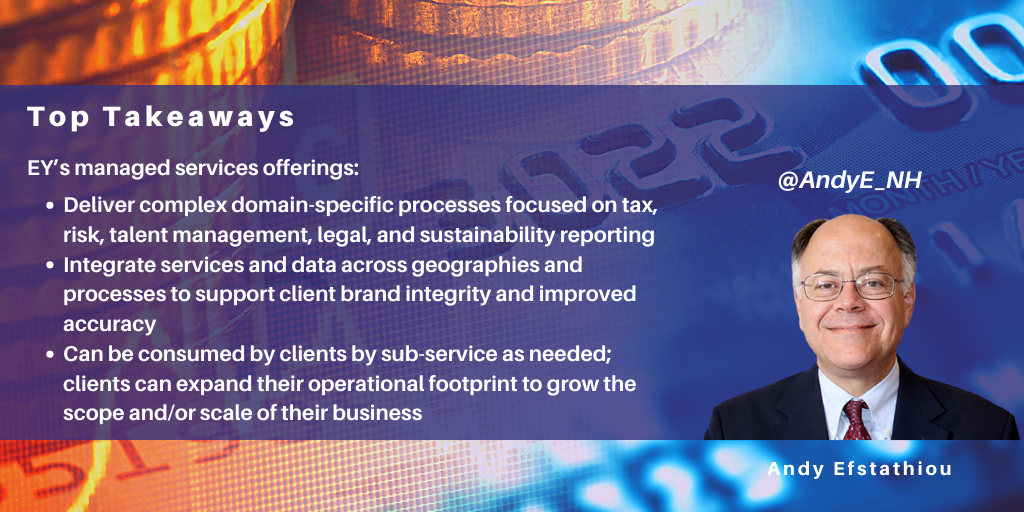
I recently attended the EY Managed Services Analyst Summit. EY’s managed services business just finished a gangbuster year, growing 30% over the prior year, with some sub-segments growing at rates up to 150% y/y. Managed services is EY’s fastest growing line of business, justifying EY’s 12-year-long commitment to this business. Here I look at EY’s managed services business, why it is satisfying a need in the market, and where it is going.
EY’s managed services offerings
The managed services business is expanding EY’s services offerings from advice and compliance to operations delivery services. EY’s managed services business differentiates itself from traditional BPO services by delivering “insight and enablement”. This means they wrap in consulting services and a technology platform (delivered using a microservices architecture) to provide higher value processes requiring domain knowledge and advanced functionality. EY employs three key competitive differentiators in these offerings:
- Domain expertise: drawing on its industry and process practitioners for best practices and each market’s custom requirements
- Integration: drawing on EY’s global delivery capabilities, including the EY fabric, proprietary IP, and alliance partnerships
- Orchestration: the delivery frameworks, infrastructure, and platforms to orchestrate consistent delivery across multiple markets and sub-industries.
The event showcased five of EY’s core managed service offerings including:
- Finance and Tax:
- Customer tax operations and reporting
- Enhanced corporate reporting and compliance
- Managed services and treasury
- Finance managed services
- Financial planning and analysis
- Tax and finance operate
- Risk and Cyber:
- Cyber operations
- Financial crime
- Risk managed services
- Forensics managed services
- Internal audit
- Compliance as-a-service
- Talent:
- Payroll
- Global mobility
- Legal: Legal managed services
- Sustainability: ESG reporting.
Finance/tax and risk/cyber are the most mature offerings. The most recent offering is sustainability, which was started two years ago. All offerings draw on resources from EY to support their delivery. For example, clients requiring LIBOR loan contract novation buy legal managed services. Lawyers and AI in legal managed services review contracts, but compliance services and GAP analysis are sourced from the risk/regulation practice. The most important shared service is data analysis and management. Data management capabilities support all managed service offerings (and all EY offerings).
Managed services delivery
Critical to the delivery of value is EY’s ability to deliver across enterprise silos, both geographic and line of business. EY’s consistency of delivery across global silos enables clients to build and maintain brand integrity across products and markets. Customizing delivery for each client requires multi-year commitments for most managed services offerings. Client retention is high and over half of new engagements are sole sourced, typically from existing EY clients.
EY enhances and delivers its managed services with its partner ecosystem. EY relies on a smaller, focused set of partners to co-innovate, create, and deliver its managed services. The three partners that presented at the event are Microsoft, SAP, and ServiceNow.
In each industry, EY works with additional partners to develop industry-specific offerings. For example, in BFS, EY works with additional partners including Pega, Experian, and Finacle.
Looking ahead
The two areas of focus for alliances over the next several years are optimizing existing offerings and developing new offerings. Developing improved data management techniques across markets will be a key focus.
EY managed services are targeting large global enterprises, many of whom are looking for support in their smaller markets, but eventually rolling out the services to home markets. As organizations are adapting to the digital world, the internal buyer is often changing from a process executive (e.g., compliance or risk manager) to a line of business executive. These new buyers need more technical expertise from vendors with greater domain skills. The nature of engagements is shifting to a combined IT/BPS offering with ongoing joint investment to drive increased efficiency and functionality over time.
Conclusions
The economy has changed over the past three years, driving costs up and increasing the dispersion of operating results across enterprises. To address this challenge institutions are looking for third-party help with the operational delivery of non-differentiating processes.
EY managed services is delivering complex domain-specific processes focused on tax, risk, talent management, legal, and sustainability reporting. It can integrate services and data across geographies and processes to support brand integrity and improved accuracy. Clients can consume sub-services as required, and expand the operational footprint as required to grow the scope and/or scale of their business. EY’s approach has been validated by the business’ high growth and client retention rates. Its ongoing investment plans to build greater infrastructure and broader offering sets should propel the business on an equally high growth rate over the next five years.
]]>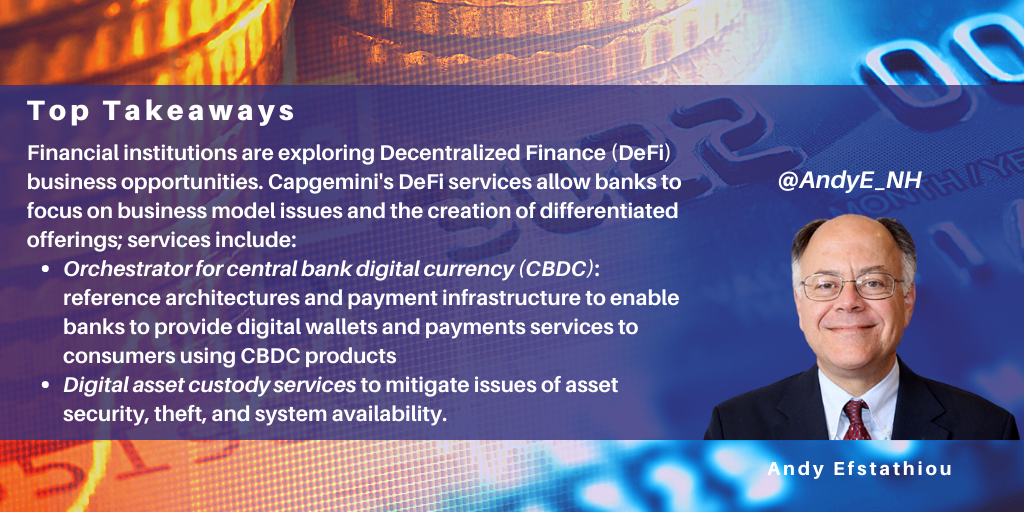
Industry background
Financial services are very centralized, with exchanges, central banks, and custodians delivering platform-based services to any user who wants to make a financial transaction or own a financial asset/liability. Decentralized finance, DeFi, is a financial system built on distributed ledger technology (DLT or blockchain) that allows a user to transact and own without an intermediary or centralized principal.
DeFi is in its early days, so the exact outline of such a system and the benefits achievable is not yet certain, but increasingly investors, including incumbent financial institutions, are building DeFi POCs and operations. Key DeFi applications being developed include decentralized:
- Payments: cryptocurrency and central bank currencies (CBDC)
- Lending (peer-to-peer)
- Exchanges (digital assets including securities, financial instruments, and currencies)
- Contracts (trade finance)
- Digital assets and Non-Fungible Tokens (NFT).
Interest from financial institutions is growing rapidly, with over 80% of central banks considering the establishment of digital currencies and over 7k cryptocurrencies now in existence. The key question is: how can financial institutions explore and execute a strategy for building a DeFi set of offerings without diverting large sums from their existing business and at the same time reinventing the wheel?
Capgemini’s framework and approach
To address this emerging opportunity with its clients, Capgemini has developed a set of assets and capabilities. Key components of Capgemini’s DeFi capabilities include:
- Tech Radar: evaluates and provides a POV on emerging technologies. Currently, 300 items have been assessed for the DeFi domain
- Digital Asset offerings: integration services for the digital asset custody lifecycle
- Trusted Data Exchange: an accelerator that enables data exchange for blockchain technology
- Blockchain Garage: consultants who work with clients to identify use cases, develop POCs, or integrate blockchain technologies into legacy platforms
- Ecosystem partnerships: a partner ecosystem of product and platform vendors
- Academic research: applied research programs with academic institutions
- Thought leadership: Capgemini published thought leadership pieces to identify trends and Capgemini’s POV on DeFi opportunities and challenges.
Both the opportunity and the challenges for DeFi are very large. To make an impact on commercializing this emerging technology, Capgemini has decided to focus its efforts in two areas:
- Orchestrator for CBDC products: central bank digital currencies can provide payment capability to consumers who currently do not have access to the financial system (financial inclusion). It can also reduce the cost of cross-border transactions. Because digital currencies can embed code, they are programable to promote governmental goals. These currencies will need custodians to reduce consumer risk. This will likely be retail banks that will store the currency in digital wallets for consumers. Capgemini is building the capabilities and running the POCs with banks to support orchestrating and managing CDFCs. Examples of engagements to date include:
- Working with SWIFT to build CBDC integrations to enable cross-border, cross-digital currency payments
- Developed reference implementation of a decentralized crypto exchange
- Built a distributed trade finance platform for a trade finance industry participant
- Developed payments infrastructure for multiple central banks
- Digital asset custody: digital asset custody is necessary to address the issues of asset security, theft, and system availability. Large retail banks typically have internal teams working on setting up digital asset custody services. Capgemini is targeting all other types of retail banks with services including Consulting, Implementation and Operate. Capgemini has domain-specific custody IP in asset tokenization, asset transfer networks, digital wallets, on-chain settlements, security, lending, and reporting. Because time-to-market is critical in this fast-evolving market, middle-market banks are looking for pre-packaged solutions that can be configured and rapidly deployed.
Conclusions
The financial services industry currently operates on a highly centralized operating model. The model works well, but the centralized model has high cost and complexity. Cost and complexity effectively limit access to the industry to customers, vendors, and products that already have large financial resources. DeFi operates on a decentralized model using DLT technology to deliver service without intermediaries or centralized principals. DeFi offers the promise of lower cost and greater access for transacting and owning digital assets.
The scale and speed of the transition to a DeFi business model are very high, which requires vendors and banks looking to succeed to focus on a few opportunities and specialize in building a competitive advantage. At the same time, any initiative needs to be plugged into an ecosystem of FinTech vendors to provide infrastructure and context to each bank’s initiatives.
Capgemini has built, and is growing, an ecosystem of FinTech vendors for the DeFi opportunity, and has chosen to focus on two opportunities in the DeFi space (orchestrator for CBDC products and digital asset custody).
These mutually reinforcing opportunities position Capgemini to provide infrastructure services (both implementation and management) for individual banks’ initiatives. These offerings will allow banks to focus their efforts on business model issues and the creation of differentiated offerings for their markets. By reducing time-to-market for new DeFi offerings, banks should be able to create new businesses and attract new customers who have never participated in the financial services industry previously.
]]>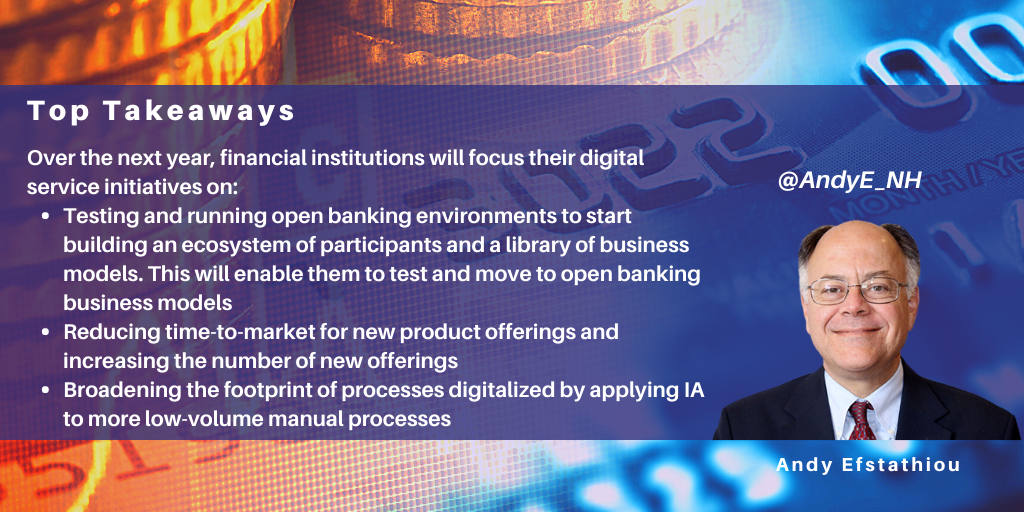
In NelsonHall’s newly published market assessment, Digital Banking Services: Transforming the Financial Services Industry, we found that financial institutions are changing their approach to digital services: from a focus on digital channels and CX to a focus on rapid solution development, cloud migration, data management, and STP.
The goal for financial institutions today is to be able to rapidly iterate new business models in an open banking environment. The pace of industry change is increasing, while labor-based operations are slowing financial institutions’ abilities to respond. The pandemic has accelerated the pace and scope of change as all business functions have had to move to remote delivery.
The state of digital services in banking
For the past year, financial institutions have been:
- Expanding the use of automated software development tools, low-code/no-code techniques, and APIs to enable platform modularization, new functionality, and the move to the cloud
- Standardizing data management and orchestration across silos
- Accelerating the use of cloud delivery and BPaaS.
Over the next year, financial institutions will focus on:
- Testing and running open banking environments to start building an ecosystem of participants and a library of business models
- Increasing their focus on human/bot teams and their effectiveness
- Reducing time-to-market for new product offerings and increasing the number of new offerings
- Applying intelligent automation to more low-volume manual processes.
However, the external environment has put up barriers to transformation. The key barriers impeding the efforts of financial institutions include:
- Opening the core platform to external parties: open banking and new stakeholders requires development of APIs and plugins for legacy platforms to increase interoperability
- Enabling new digital business models: increasing platform agility and new functionality to support new businesses
- Building and enabling partnerships: sourcing IP from open source, acquisition, or shared products
- Working with new markets and products: different markets and products have different cost structures. Banks are shifting to high-volume/low-margin products (e.g., customers: mass affluent and unbanked; products: self-service and robot-advised). These offerings require high automation, embedded AI, multi-channel access, and high compliance capabilities, each adapted to multiple, unique markets.
Rising to the challenge
To address these challenges successfully, financial institutions need to focus on two activities: strategy and execution.
Key factors in strategy include:
- Changing the business model: banks need to reduce fixed costs and be able to scale volumes at a constant margin to be able to rapidly change business models across time and markets
- Developing a roadmap to achieve agile/flexible operations delivery using cloud/BPS/heterogenous delivery
- Building an ecosystem of operations vendors with domain knowledge and experience with clients’ operations environment, vendors with complementary digital skills to deliver services, and the ability to work within client operational practices and transfer knowledge.
Key factors in execution include:
- Working with hyperscalers: migrating internal operations by standardization, consolidation, and modularization of platforms
- Redefining the external/internal operations split (with the rollout based on tested use cases):
- External processes: high value, non-repetitive, cyclical processes
- Internal processes: lower value/less differentiation/less volatile
- Selecting emerging product vendors for functionality, roadmap, financial strength, and the product vendor ecosystem. Preferred vendors should have the widest pool of IT services providers supporting them
- Orchestration: selection and implementation of orchestration tools to manage a heterogeneous system of vendors and products.
In summary, financial institutions are changing their goals from improving process efficiency for static businesses to increasing operational agility to continuously changing business models and operations. The operational changes being made will drive business model change. And these operational changes will drive accelerating change in banks’ product offerings, customer base, and market presence.
Find out more about NelsonHall’s “Digital Banking Services: Transforming the Financial Services Industry” market assessment and forecast report here or contact Guy Saunders.
]]>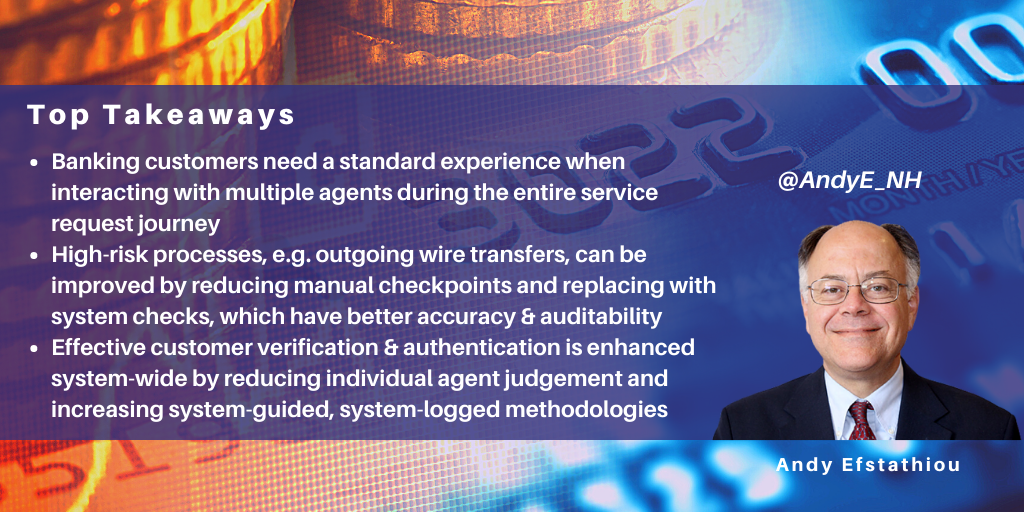
Digital transformation has accelerated in the banking industry since the start of the pandemic. This blog describes some recent digitalization activities a bank undertook with Xebia to improve its customer contact processes and provide differentiated service with increased efficiency.
The challenge
A U.S.-based neo bank began experiencing ongoing high call volumes in its call center. The result was lower customer satisfaction, lower staff productivity, and increased processing costs. To address the challenge, Xebia delivered a 5-week process discovery and consulting project to:
- Identify issues
- Propose process and application redesign
- Propose a business process reengineering blueprint for the entire contact center.
The implementation phase of the project was estimated to take 9 to 10 months. I asked the Xebia executive team to describe the changes they made to some of the processes and platforms that have enabled their client to deliver a differentiated experience for their customers. The questions cover three key areas: call center operation, outgoing wire transfer, and customer verification and authentication.
Call center operation
Q: A key component of your customer experience transformation was standardizing call center processes. Why is it critical to standardize CX processing?
A: For a call center, or any service organization, most activities performed by the staff/agents are repetitive tasks executed as part of facilitating customer requests and inquiries. Hence, it’s important to follow a standardized process so that the training time and effort are reduced and newly onboarded staff can come up the curve very quickly so they can handle customer calls ASAP. From a customer’s standpoint, they must receive a standard experience while interacting with multiple call center agents during a particular service request journey or their entire life cycle with the bank in general.
Q: What were the key components you proposed and implemented for CX process transformation?
A: From a functional point of view, multiple features and capabilities were proposed as part of the overall solution. Primarily these were in two major categories:
- Inquiry: A unified Customer Servicing Platform that allows agents to have a comprehensive and organized view of the customer profile, product holding, and multiple other criteria that are crucial to handling customer calls. This not only includes system-curated information but also analytically driven variables and personalized recommendations that empower agents to drive more informed conversations and decisions while on a call with the customer
- Action: The same Customer Servicing Platform consists of mechanisms to perform multiple actions and serve customer requests from the same channel, allowing end-to-end fulfillment and enablement of any customer request. The platform is integrated through the bank’s core systems, which will allow STP loops through a single portal and help the bank improve staff efficiency and overall service experience for the customer.
Q: How did these changes improve CX? What were the benefits achieved?
A: The program is not just a system implementation project. It also includes a revamp of some of the organizational processes and is envisaged to have both tactical and strategic benefits. Some of the expected outcomes are as follows:
- TAT and call waiting time reduction for the customer through standardized processes: 35% to 75% reduction in TAT depending on sub-process
- Improved staff efficiency through simplified processes with a reduced number of steps. (16 steps reduced to 4 steps and 17 steps reduced to 11 steps in two key processes)
- All-round audited actions and service closures for improved governance and security
- Enabling service staff to drive revenue for the bank through targeted cross-sell recommendations over the portal
- Reduction in overall staff training time resulting in a reduced overall cost of operations for the department
- Improved visibility of service ticket journey and overall success KPI matrices for the department.
Outgoing wire transfer
Q: Outgoing wire transfers is a high volume, complex process. Describe for us the ‘As-Is’ process and the ‘To-Be’ process you designed.
A: Indeed, wire transfer is complex and was one of the primary focus areas of improvement for us during the discovery exercise. Because it was one of the very few processes where the outflow of funds was involved, it became even more important to have the right level of checks and authorizations at each relevant process node even after simplification.
The As-Is Process involved the customer calling up the call center and requesting a wire transfer. After the standard customer verification, the call center agent would send the ‘wire request form’ for the customer to complete, an editable PDF file, which the customer would fill in manually and return to the bank. The customer would then call the contact center again and the form would be cross-verified manually by the agent against information available across various systems within the bank. Once verified, the agent would send the form to the Ops team who would once again verify the information and then post the transaction into the partner bank portal, where a standard maker/checker setup would be followed. After the transaction was posted, the Ops team would also maintain an entry, manually recording the wire transaction and customer details in a centrally-shared file, which would be utilized by the risk teams and other departments of the bank for any reporting or post-facto anomaly identification.
The To-Be Process we designed reduced the manual checkpoints and enhanced them with system checks. This reduced the overhead from call center agents and improved the accuracy of these checks. Further, the information on the customer wire request form was converted to a web form with pre-filled customer profile information. The customer simply verifies the pre-populated information and fills in the specifics about the wire transaction to be executed. The capture of information at each step happens digitally with the help of web forms, making the generation of any logs for post facto transaction reviews simpler and extremely efficient.
Q: What are the key differences in your approach to transforming this process versus alternative possibilities the client was considering?
A: The fundamental approach towards transforming this process was based on the following guiding principles:
- Consolidating system touchpoints: As part of serving a request, the call center agent toggles between multiple systems to gather information and act upon it. In the proposed processes, various channels were integrated into one central platform which was used for both inquiry and action purposes
- Automating decision checks: Wires require checks to be performed during the entire process to ascertain the accuracy of customer-filled information and funds applicability for wire transfer, and these checks were being done through multiple systems. These checks were automated, providing huge benefits both in terms of freeing up bandwidth for call center agents and reducing errors that happen with manual checks
- Improving auditability of every action performed by agents over the platform and providing better visibility at retrievals and on customer inquiries.
Q: How did these changes improve outgoing wire transfers? What were the benefits achieved?
A: TAT will be reduced for the overall process by 77%, which will result in an improved overall customer experience. The number of steps in the process has been reduced from 32 to 7. The process was also proposed for customer-facing channels in self-service mode, which will further release bandwidth for call center agents at the bank.
Customer verification and authentication
Q: Customer verification and authentication is a real-time, complex, regulated process. Describe for us the ‘As-Is’ process and the ‘To-Be’ process you designed.
A: Verification and authorization are regulated and part of every call received at the call center. The As-Is Process involved the contact center agent asking for customer details from the customer and then matching them manually onscreen. Once it was determined that the customer details are accurate, the aAgent would send a multi-factor authentication (MFA) code to the customer’s registered mobile or email. The customer would then be asked to call out the received code which is again verified manually against the code present in front of the agent on-screen.
The To-Be Process we proposed involved a customer calling out his details, which are then input by the agent on the screen present. The verification of this information is carried out by the system and only if it matches with the details in the customer profile will the agent be able to send out the MFA link to the customer on his registered mobile and email. The customer will be able to authenticate by clicking on this link instead of verbally calling out a secure MFA code.
Q: What are the key differences in your approach to transforming this process versus alternative possibilities the client was considering?
A: The approach we proposed makes the customer verification and authentication process more secure and robust. The previous process relied more upon the judgment of an individual sitting at the terminal to verify the customer. In addition, this required the customer to verbally relay sensitive information like an MFA code over a call.
Q: How did these changes improve customer verification and authentication? What were the benefits achieved?
A: Customer verification and authentication previously included a great amount of manual checking to ensure the veracity of the credentials being called out by the customer. The revised process is much more governed and secure. Additionally, it also helps the bank to maintain the suitability of the verification through a system-logged mechanism. The multi-factor authentication approach has also been improved and made more system-guided, resulting in overall improved efficiency and governance around call center operations. Overall, TAT has been reduced by 56%, and the number of process steps has been reduced from 17 to 6.
]]>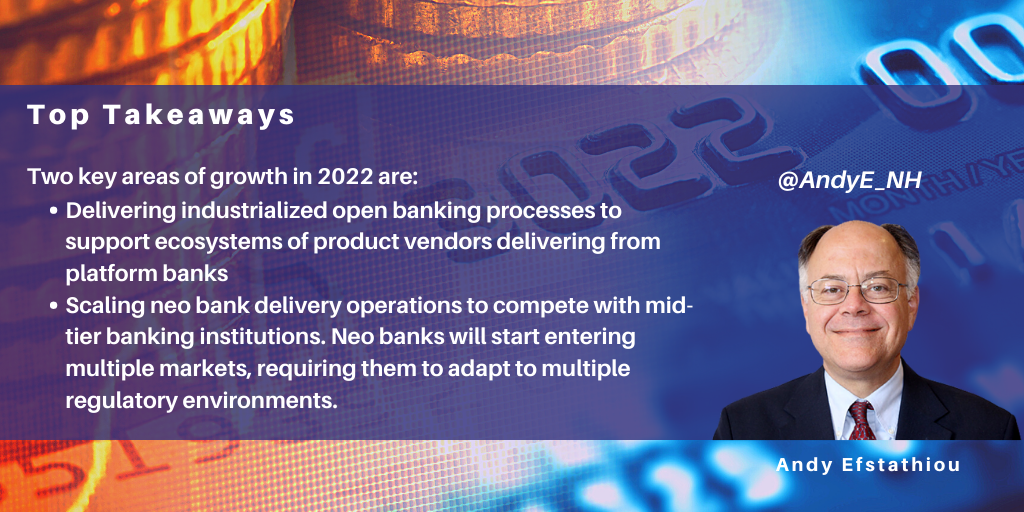
In 2022, the financial industry will continue to focus on building out its cloud and digital services infrastructure. This will be a deepening of capabilities for banks that have started their transformation, and the start of the journey for institutions that have not yet initiated their transformation. The growth rate of digital transformation is very high at ~20%.
Since most technology services vendors now derive 40% to 60% of their revenues from digital transformation services, this high growth rate will build on a large revenue base. However, there are two areas that have small revenues but much higher anticipated growth rates. We predict that these areas will start to make an impact in 2022, and be the growth engine for IT services in the financial industry in three to five years. They are:
- Delivering open banking processes in an industrialized environment
- Scaling neo bank delivery.
Our discussions with bank executives indicate that these are high priorities, though they also highlight a lack of consensus, with a wide range of perceptions. However, it is clear that execution will need third-party vendors to support and provide rapid, effective, and scaled services.
Industrializing Open Banking Delivery
Open banking has been a regulatory initiative for five years, but is only now moving to the execution stage in a few markets. Advanced markets moving ahead today include the Nordics and Benelux. These smaller markets make experimentation more feasible for a bank to launch a full-scale open banking initiative, and it is also easier to reengineer operations on the fly based on customer feedback. And, in smaller markets, it is easier for the financial institution to design an offering for a new customer demographic and vet partners to deliver a quality customer experience.
Delivering successful customer experiences in the initial open banking initiatives will drive customer awareness and willingness to adopt new offerings. Currently some Nordic banks are pursuing initiatives (e.g. in small business markets) which, if successful, will enable them to capture very large market shares of new customer demographics. The key is these markets are all domestic. It is rare that a bank in a mature market can pursue a domestic market opportunity as large as its existing markets.
Scaling Neo Bank Operations
Startup digital banks (neo banks) focus on their business model and the design and creation of new banking products. Ongoing operational delivery is not considered to be a core competency. Neo banks have been around for five plus years, but many have failed and just a few, such as Marcus, have grown to considerable size. None to date have become a tier one bank or financial services provider. Each market has seen different types of startup financial institutions opened. In the U.S., payments vendors have predominated; in Europe, digital banks have been the predominant form of startup.
The financial institutions (i.e. banks, payments processors, lenders such as Marcus, Revolut, Stripe, or Square) that have grown since founding must now scale up operationally to drive home their digital advantage before competitors match their digital value proposition. Scaling their business does not just mean scaling transaction processing, it requires scaling control, compliance, and security. Third-party BPS vendors are required to support this transition to large-scale, multi-product, multi-market operational delivery. Vendors that can provide combined domain-specific ITS and BPS services are rare. In 2021, BPS services grew slowly as clients focused on ITS for digital transformation. In 2022, BPS services focused on supporting neo bank growth will provide most of the growth in banking BPS revenues.
Summary
Financial institutions have been experimenting with new business models and customer methods. In 2022, these initiatives will need to scale the business, not just the transactions (which hyperscalers have been doing). Delivering domain-relevant operations at high scale will become an emerging focus of the digital financial industry for the next five years and drive large revenues for vendors who can deliver these comprehensive services.
]]>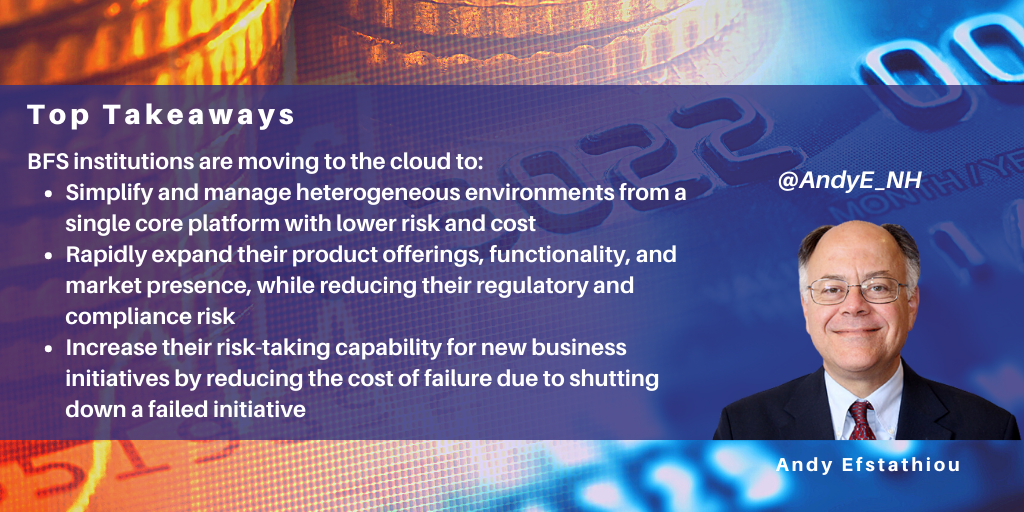
On December 15, 2021, Kyndryl and Viewpointe announced a cloud migration, modernization and management contract. The engagement provides insight for BFS executives into how banking services operations vendors are moving to the cloud to simplify operational delivery and enable business model change to expand and improve their business.
Current state
Viewpointe provides content management services for its owners, leading U.S. banks that include Bank of America, Truist, U.S. Bank, and Wells Fargo.
Viewpointe also delivers services for banks that are not part of its ownership structure. It delivers its services from two data centers (operating as primary and backup) in the U.S. It employs a proprietary platform to deliver services, which are heavily customized for each client. The primary content stored and managed by Viewpointe is mortgage/loan and checks/payment documents. Banks and their customers can search, access, and exchange content. Viewpointe develops and maintains the software platform. Kyndryl has been providing infrastructure orchestration and management services to Viewpointe since its inception in 2000.
Each client requires customization of the content management software to deliver a differentiated customer experience for each bank client. This has meant that each solution instance and sub-environment is unique and monolithic, on top of fixed infrastructure.
The engagement
Viewpointe wants to transform its application portfolio into a microservices delivered platform where:
- Clients can customize their platform, but platform management can be applied in a standardized fashion (e.g., patches, updates, management, and security will be rolled out rapidly with standardized solutions)
- Environment management will be handled by third parties (i.e., cloud delivery and environment orchestration)
- Viewpointe can develop new functionality and easily roll it out across heterogeneous client instances
- The entire environment can scale rapidly for new clients, markets, and product lines.
To achieve these goals, Viewpointe and Kyndryl have agreed to an engagement with steps including:
- Lift and shift to Azure cloud:
- Kyndryl and Azure design a landing zone to take the Viewpointe platform from its on-premise centers to the Azure cloud
- Kyndryl moves the platform to the Azure cloud, setting up orchestration and management services to manage the infrastructure environment
- Kyndryl and Azure partner to adapt to the changing cloud environment daily using best practices
- Transform the platform: Viewpointe implements solution changes to introduce new product lines and/or client feature customizations
- Scale the engagement: currently, client operations supported are all based in the U.S. In the future, Viewpointe expects to adapt its platform and delivery to support clients in additional markets with additional product lines and functionalities.
The journey will take three years, including:
- Year 1: migration to Azure cloud with new cloud-based orchestration and management capabilities implemented by Kyndryl
- Years 2-3: Viewpointe rebuilds the content management platform to fully adopt a microservices approach.
The engagement is expected to result in cost savings of 20% to 30%.
Conclusions and benefits
Cloud migration has been effective for highly seasonal or cyclical businesses, where volumes spike and the client only pays for capacity as it is used. Static workloads typically cost more in a cloud environment. This engagement highlights a use case where cloud delivery is more cost-effective than internal delivery. Features that must be present to make the case for cloud include:
- Heterogeneous environment by client: each member of the client base has high levels of platform customization resulting in each instance being materially different from all other instances
- Expanding the set of product offerings: rapidly expanding product offerings requires the client to deploy new solutions into the environment frequently. These solutions must rely on core functionality in the existing platform to deliver service
- Expanding markets: rolling out support for clients in additional markets that can be more easily supported from a Hyperscaler’s data center network
- Highly regulated industry: security and compliance requirements in highly regulated industries are frequently updated. A standardized microservices environment allows clients to rollout standardized updates across the entire environment faster, with greater accuracy.
Ultimately, the case for the cloud is that it allows Viewpointe to accelerate new product launches and standardize its operational delivery, while still enabling its customers to customize their platform instance.
]]>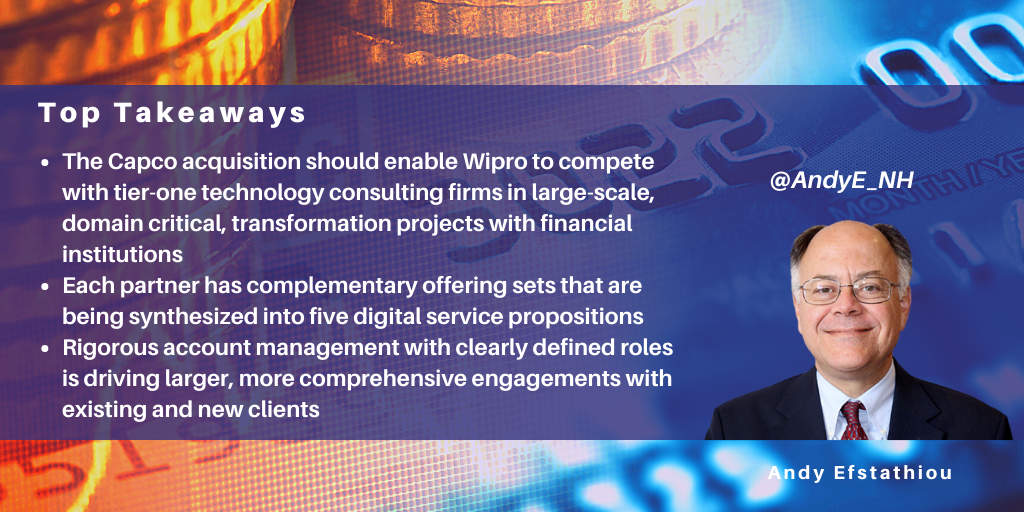
Wipro acquired Capco six months ago, and is Wipro’s largest ever acquisition which, if successful, should enable it to compete with tier-one technology and management consulting firms in large-scale, domain critical, transformation projects with financial institutions.
However, successful unions are not created at the strategic level, but with disciplined execution that drives client and employee retention and growth. This blog examines early activities and results from this union.
Background
In Q1 2021, Wipro acquired Capco for $1.45 Bn to extend its capabilities in technology and management consulting for the banking and financial services industry. Wipro already had a large presence in BFSI, which currently represents 36% of its revenues, with offerings centered on designing, building, integrating, implementing, and supporting services. Capco’s services are centered on business and technology consulting and digital transformation services customized for the financial services industry.
Capco’s geographic footprint differs from Wipro’s, with key accounts in Europe and North America. In addition, Capco has a network of onshore and nearshore shared consulting capability centers in Europe and North America which support Wipro moving closer to the client.
Complementary business models
The partners have complementary business models. Capco is a global consultancy focused on financial services, with 96% of its revenues from Europe and North America and a smaller presence in APAC. When comparing Capco’s top 30 strategic accounts with Wipro’s Top 45 strategic accounts, only five of the accounts overlap. One year before this union, Capco formally launched its insurance practice, which today is accelerating its growth based on its frameworks and accelerators and the ability to bring Wipro resources to bear.
Wipro has a broader geographic presence (including a strong presence in APAC, LATAM, and the Middle East), greater scale, and unique domain offerings (U.S.-based mortgage lending IP and delivery, and Canadian custody services). Together the two firms bring an end-to-end set of services offerings to the market, comparable in scope to the largest IT and consulting services vendors.
The combined Wipro/Capco consultancy is bringing five digital service propositions to market focused on:
- Data
- Cybersecurity
- Customer experience transformation
- Cloud transformation
- Digitization.
The go-to-market strategy is for Wipro and Capco to maintain and manage their individual client relationships and collaborate to identify specific opportunities, through joint planning, to cross-sell services.
During the past six months, the combined entity has booked 20 new joint deals as a result of their new GTM strategy and there are currently more than 65 deals in their joint pipeline. The combined firm is looking for, and so far winning, larger, more comprehensive deals than either had before this union. Key examples of new deals won include:
- Setting up a new digital-only bank: two deals, one in North America and one in Europe
- Customer onboarding application rationalization for a provider of financial products to banks
- Migrating a treasury product application suite to the cloud
- Custody engagements in Canada: multiple deal wins engaging both Wipro and Capco offerings.
To power the new strategy, Capco needs to retain its staff and Wipro needs to grow its delivery capabilities in relevant technology areas. Key activities to date include:
- Capco has always attracted staff through a strong employee value proposition, supported by a differentiating culture and by offering highly competitive compensation coupled with strict non-competes. These contracts have built a stable, growing workforce
- Capco has added >1k employees to its existing 5k employee base over the last six months
- Wipro has integrated project delivery into its existing global delivery network.
Go-to-market plans for next 12 months
Over the next twelve months, Wipro and Capco will develop joint account plans for their joint strategic accounts. The primary focus will be on deepening strategic account engagements, with a secondary focus on winning new account logos with engagements that draw on the combined offerings of both Capco and Wipro. Wipro’s strategy has been to focus on strong growth from strategic accounts paired with a healthy addition of new clients each year.
Capco has hired four senior leaders to help drive an expansion of its offerings into the APAC marketplace, which will leverage Wipro’s existing infrastructure and account relationships.
Conclusions
The partners’ highly complementary offerings are being synthesized into five digital service propositions for the marketplace. Rigorous account management with clearly defined roles is driving larger, more comprehensive engagements with existing and new clients. Wipro will be able to enhance engagements with existing clients. It is now beginning to compete with vendors on projects requiring end-to-end services. Success over the long term will require continued operational discipline, evolving offerings to include a greater custom domain component, and retention of key skillsets. The union is off to a good start.
]]>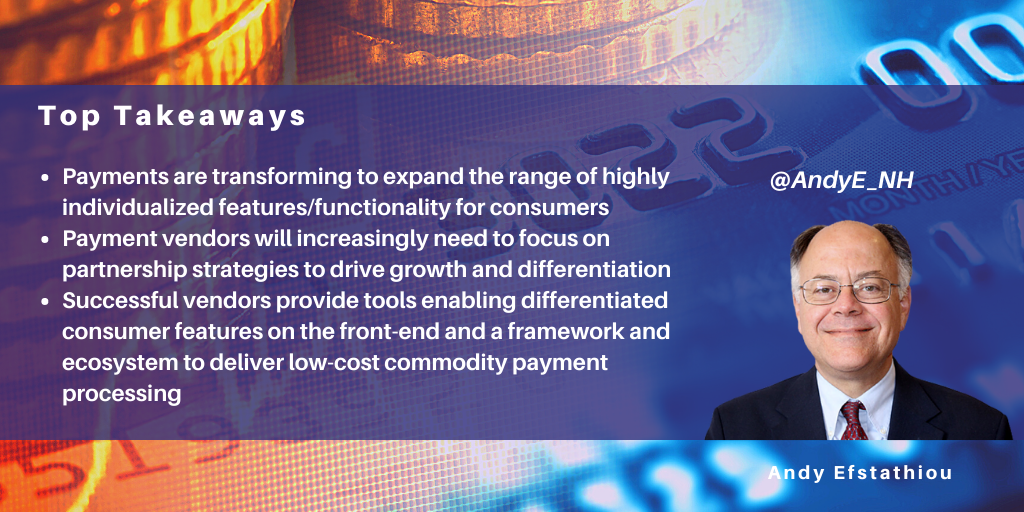
The payments industry has been transforming away from physical payments and electronic closed networks into an open network, all-digital payment ecosystem, and the pandemic has accelerated this shift. From the consumer’s perspective, this has been characterized by:
- A move to e-commerce and m-commerce, away from brick-and-mortar commerce
- Aggressively reduced use of traditional payment types (e.g., cash and checks) and increased use of digital payments (e.g., digital wallets, phone payments)
- Hyper-personalized payment experiences (e.g., enabled by multiple channel access and AI).
In this environment, payments vendors are expanding their:
- Customer bases to cover all consumer demographics
- Modes of payment, providing access from one interface
- Use of AI and biometrics
- Payment functionality to include real-time, cloud delivery, APIs, and platform-based solutions.
The payments industry is adopting key emerging functionality including:
- Buy now, pay later (BNPL) which combines credit and payment functions into one financial product
- Biometric payments, increasing security effectiveness and reducing friction from password usage
- Cryptocurrency payment options which expand the range of currency options
- Invisible payments: payments via a virtual wallet, increasing the ease and security of payments.
The Challenge
New competitors and new functionality are disrupting the traditional payments business, driving down margins. A recent Capgemini survey found that 70% of bank executives stated their payments business was either unprofitable or at break-even. Banks need to adapt their payments business to compete with emerging payments vendors.
Banks have three levers available to them to improve payment profitability:
- Change their business model, where there are two options available:
- Exit unprofitable offerings, reducing the overall offering set
- Partner with third parties to expand the offering set by geography and functionality
- Change their operating model, with two models available:
- Creating partnerships to invest in creating new offerings for the market
- Building ecosystems and API sets to let customers select new offerings from the bank’s platform
- Change their technology used in operations delivery, where the three models available are:
- Invest in cost-reducing technology: used by global tier one banks to create differentiation and reduce cost
- Buy operations delivery on an as-a-service basis: used by banks to support short-cycle products, seasonal/cyclical products, and untested products
- Collaborate with technology product vendors to build offerings and improve the distribution of the products with joint customer propositions.
The focus of these initiatives is reduced cost of delivery, but customers do not buy payments to improve banking profitability. They buy to improve their own experience. The key parts of the payments value chain delivering differentiation are the front end (i.e., signup, underwriting, acceptance, ease of use, speed of execution, and customization) and reporting (i.e., receipts, integration to tax reporting, analytics, budgeting, and customization).
Capgemini’s Approach
Delivering this level of change, while standardizing operations to control and reduce cost requires a move to standardized core platforms with a high degree of configurability to adapt to specific markets, customers, and a constantly changing environment. Capgemini’s approach demonstrates how this strategy can be implemented. Key components of its payments offerings include:
- Clearing Connect: a consolidated payment hub solution that can be customized for each clearing house the bank operates in. The payment hub allows centralized processing of payments but enables rapid customization and enablement of additional clearing houses as the client requires
- Payments Realization COE Hub: a COE that supports banks' modernization of their payments infrastructure and operations. There are three key offerings:
- Focused engines as payment hubs: Capgemini partners with solution vendors to provide products and services to modernize the operation of a payment. This represents 55% of client demand
- Frameworks: provides insights and a structured approach to payment transformation (35% of client demand)
- As-a-service: provides an emerging payments wallet in Europe, in partnership with AWS (10% of client demand).
These offerings enable banks to build a core payments platform that can be rapidly adapted to changing markets, technologies, and regulations.
Conclusions
The payments market is facing compressing margins and expanding functionality. Payment providers need to be able to expand their differentiated services with highly individualized features/functionality for consumers. At the same time, undifferentiated processing services must reduce costs to remain viable. The solution is for payments vendors to build standardized core payment hubs which can rapidly be adapted to new clearing houses and financial product introductions.
Capgemini has built services that provide a framework and ecosystem for transformation and a core processing hub that can deliver low-cost commodity payment processing. As the market evolves, payment vendors will increasingly need to focus on partnership strategies to drive growth and differentiation.
]]>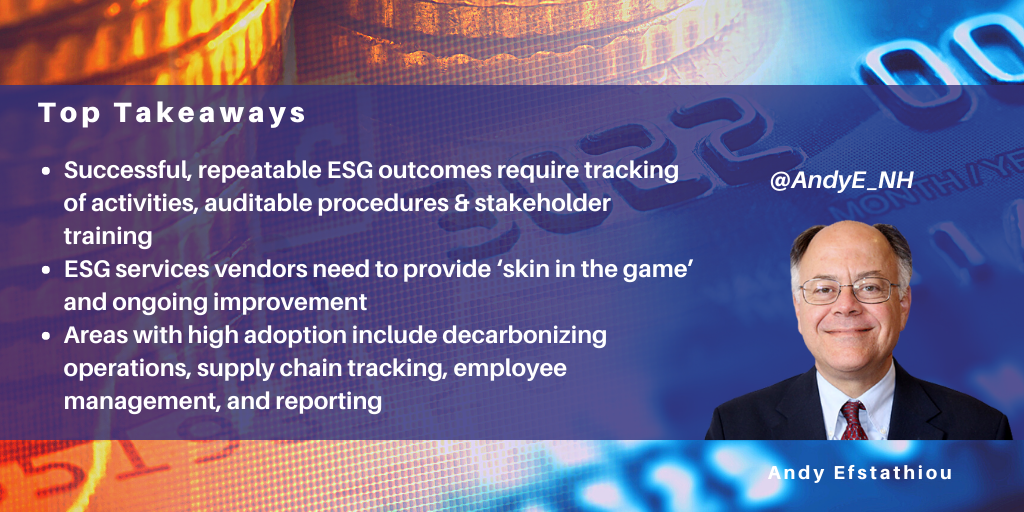
Environmental, Social, and Corporate Governance (ESG) is a popular topic of conversation and one that most corporations claim to be actively pursuing. The financial industry is particularly active in ESG, and here I look briefly at what is being done to support ESG initiatives by IT services and BPS vendors who support financial institutions’ operations.
How vendors help banks set up & run ESG activities
Vendors are supporting banks with services including:
- Advisory: engagements to develop a strategy, roadmap, and framework for implementing effective ESG programs
- Solutions: implementing tools, software, and ecosystems to achieve goals
- Integration of ESG/business activities: coordinating and embedding ESG programs into ongoing business activities.
These services are applied to:
- Data: managing, analyzing, and reporting current state and the impacts programs have made
- Technology: identifying and implementing technology to achieve ESG goals (e.g., technology to reduce energy consumption)
- Culture: working with stakeholders to educate and impact behaviors
- Portfolio management: orchestrating and managing ESG programs and assets across the enterprise to reuse and pursue improved outcomes.
Key activities covered include:
- Literature review and best practices
- Analysis: analysis of activities to prioritize for change, plus analysis of outcomes achieved
- Reporting to stakeholders, including employees, customers, management, and regulators
- Tracking the chain of custody and activities for assets and processes to confirm that actual behaviors are as reported
- Employee training: educating employees about strategies, value, and methodologies of ESG activities.
Most vendors offer a wide range of services, but specialize in implementing a few processes (e.g., decarbonization or HR). Activities with a high level of adoption include:
- Decarbonizing operations
- Supply chain tracking for carbon and ethicality
- Reporting (especially for regulations)
- Employee management, ethicality, and diversity.
In terms of challenges, ESG programs have faced pushback for ‘greenwashing’ activities where analysis of achievements has indicated actual outcomes have been much lower than reported, or non-existent. The key to achieving successful, repeatable outcomes is rigorous:
- Tracking of activities and assets with robust chain-of-custody controls
- Compliance with auditable procedures to ensure activities are as reported
- Stakeholder training with buy-in from trainees (achieving cooperation).
Example vendor frameworks & solutions for ESG
Decarbonization: Atos
Atos delivers services to help clients decarbonize their operations. Their offering helps clients to identify their current digital emissions status, build a roadmap to reduce the carbon footprint, and engage employees to support these changes. Key components of the offering include:
- One-day ‘hackathon’ to identify issues and build consensus
- Assessment: identify the current state and build a roadmap to a desired future state
- Dashboard: displays information on the current status and supports setting goals and decision making
- SLAs: Atos contractually commits to carbon reduction targets with a roadmap for how those targets will be met
- Green App: a gamified ecosystem to help employees understand key issues and support developing ideas to solve problems.
Employee & stakeholder training: Infosys
Infosys delivers training services to educate employees in adopting ESG practices across the enterprise. The key to enhancing the training programs that the vendor delivers to clients is the use of existing CX platforms to enhance training effectiveness using tools such as design thinking, knowledge management, and digitally delivered learning offerings. Key to success is special-purpose platforms that respond to environmental change and support change in the enterprise, including:
- Wingspan platform: knowledge and change management
- Meridian platform: sustainability events and community.
Responsible supply chain: WNS
WNS supports clients looking to secure and improve the ESG and operational characteristics of their supply chain with a set of agreements, contracts, practices, and due diligence. Key components of its responsible sourcing offering include supplier:
- Code of conduct: mandatory standards for all participants
- Portal: supplier data repository
- Due diligence
- Contracts: standardization of party obligations, including to ESG
- Evaluation: a periodic review of competency and compliance
- Assurance: supplier self-evaluation
- Awareness: mandatory anti-bribery training
- Diversity: profiling of suppliers
- Governance: audit and management reporting
- Ongoing improvement: benchmarking and ongoing enhancements.
In summary
Vendors are launching tools and offerings to address ESG challenges rigorously for banking clients and others. The programs are effective where there is accountability, consensus, ongoing improvement, and vendor skin in the game. Effective ESG programs will become increasingly important to the heavily regulated banking industry over time.
In my next blog I will look at how the market for these services, including client demand, is evolving.
]]>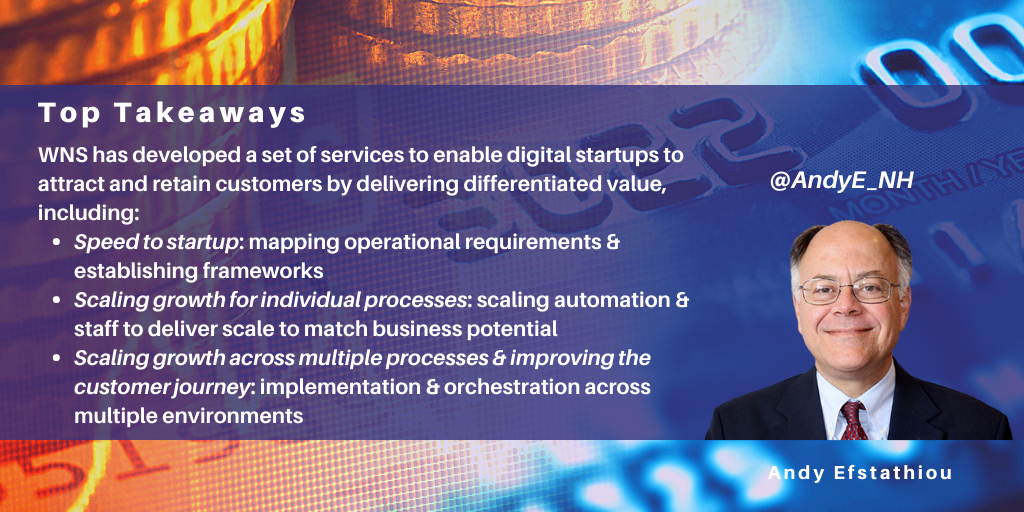
Digital startup banks are built on FinTech functionality to deliver financial services in an omnichannel environment. There are two types of FinTechs: B2B businesses that have a proprietary platform to deliver service to clients, and B2C businesses that provide clients with an all-digital banking experience.
WNS: expanded focus on B2C FinTechs
While WNS supports B2B and B2C, it has seen more traction in the latter, and has expanded its services to support the B2C FinTechs. The key market segments include:
- Digital banks
- Personal finance
- Wealth managers
- Business finance (small businesses)
- Payment providers/digital wallets/crypto firms.
Because the B2C FinTechs work with consumers, they require support for compliance and customer support, and these processes require human interaction to succeed and grow. Only 10% of FinTechs survive, but successful firms require massive scaling to meet customer service requirements. The good news is digital banks have lower exception rates (typically a 3% exception rate, versus 10% from a typical tier one bank) because their core processes are all digital.
However, many of these startup digital banks have faced operational challenges. Traditional banks are retaining customers because they offer the entire range of banking services, at scale, which encourages customers to maintain their business with them. FinTech banks that have faced challenges include Tesco Bank which has sold off its mortgage business and is closing its clients' demand-deposit accounts. Similarly, M&S Bank, a JV of M&S Stores and HSBC, has closed its in-store branches and is also closing its customers’ demand-deposit accounts. The lesson is that full product-line operational delivery at scale economics is critical to success.
WNS services for startup FinTechs
WNS has pursued the startup B2C FinTech market with a three-pronged set of services:
- Speed to startup:
- Map regulatory requirements
- Identify volume and staffing requirements
- Establish controls and SOPs
- Establish risk management, compliance, and control frameworks
- Scaling growth for individual processes:
- Institutionalize best practices
- Scale staffing to match business potential
- Performance management
- Automate repetitive manual processes (e.g., exception management)
- Scaling growth across multiple processes and improving the customer journey:
- Scale multi-geography operations
- Incorporate new regulatory and process requirements into frameworks
- Implement IA, AI, and omnichannel CX.
WNS engagements with FinTechs add processes over time, and the typical progression of services includes:
- KYC/AML/Fraud and compliance: most engagements start with this set of processes
- CX and onboarding: engagements next add in compliant onboarding services to achieve higher conversion rates, faster overall growth rates, and improved CSAT
- Back office services: reporting, accounting, fulfillment.
WNS can enhance its clients’ capabilities with functionality from its own set of tools or its ecosystem of FinTech solution providers which delivers emerging functionality in four key areas:
- Customer service
- Origination and servicing
- Analytics
- Compliance.
By using this rollout strategy and set of offerings, WNS has been able to scale individual engagements by 2X to 10X in one year. Overall, WNS has been able to grow its digital startup bank business this past twelve months by 40% y/y. Clients using these services have experienced a 30% reduction in TAT, 95% improvement in CX, and 30% reduction in application processing times.
Conclusions
Digital startup financial institutions are looking to bring new business models to market quickly. Third-party services vendors need to provide STP and a comprehensive set of services to support these emerging BFS services providers. WNS has built a set of operational services which enable startup banks to scale fast and continuously deliver new functionality to customers. This enables digital startups to attract and retain customers by delivering differentiated value. In contrast, tier one banks look for vendors to deliver siloed functionality.
Startup banks need a vendor that can deliver broad operational support. Sourcing, organizing, and managing resources is a complex challenge for a bank. WNS has pulled together the relevant components and frameworks necessary to deliver a full-service operations environment. As startup banks and local banks look to grow their businesses, they will increasingly rely on third-party vendors for this type of support.
]]>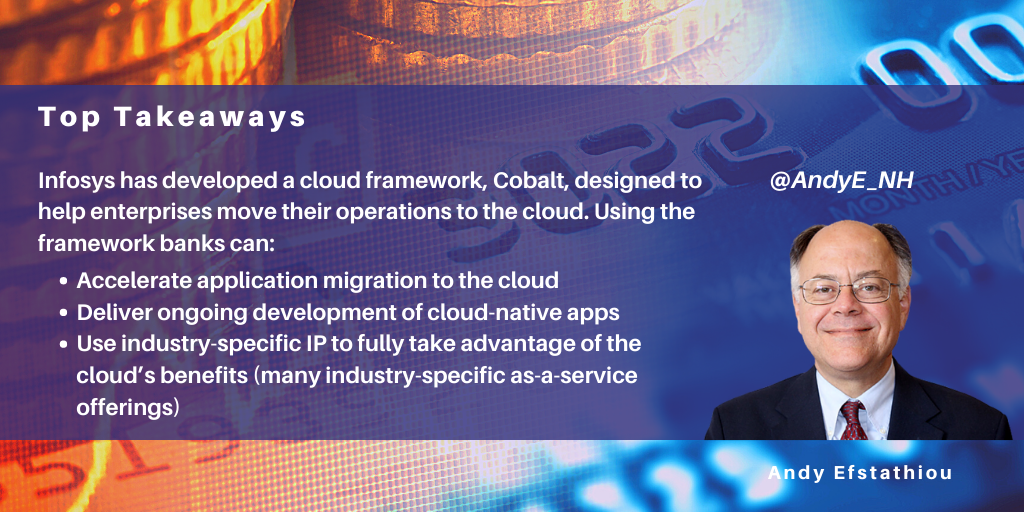
Banks are accelerating their move to the cloud to respond to the pandemic, enable greater operational agility to reduce time to market, and develop open banking capabilities. At the same time, performance dispersion (the operational variance across institutions within the industry) has increased significantly.
Cloud delivery can change operational performance and hyperscale businesses. So, how can banks move their operations to the cloud most effectively, and what tools and frameworks are needed to best adapt cloud operations over time? Infosys has developed a set of tools and frameworks, Cobalt, to address these challenges.
Infosys’ Cobalt Offering
Cobalt, Infosys’ cloud framework offering, is designed to address the key challenges enterprises face when trying to move their operations to the cloud. These challenges include:
- Security: the ubiquitous challenge of the cloud is providing satisfactory cybersecurity
- Modernizing and innovating their platforms: enterprises are moving to the cloud to modernize their platforms, but access to a broad range of tools and applications in this rapidly emerging market remains a challenge. Maintaining flexibility requires enterprises to avoid vendor lock-in
- Improving speed to market: implementing new solutions quickly and effectively in a multi-cloud environment is subject to wide variation across domains and companies. Access to talent continues to be a gating factor.
The Cobalt offering provides a solution across these five key areas of accelerated cloud adoption by any enterprise:
- Mainframe modernization: tools for assessment, rules extraction, and component migration
- Cloud-native development: tools for the development of cloud-native apps
- Database migration: database migration frameworks and tools
- Migration: frameworks and tools for migrating apps to the cloud
- DevOps: tools and frameworks to accelerate the adoption of DevOps across the bank.
Infosys believes cloud migration requires industry-specific IP to fully take advantage of the cloud’s benefits. Infosys has created a financial services-specific Cobalt offering, FS.Live.Cloud, that includes, but is not limited to:
- Open Banking solution: an open banking API platform
- Recon-in-a-box: recon platform to manage operational risk and provide controls
- Mortgage-as-a-service
- Business banking: Virtual CFO
- AML/KYC
- Media platform: digital asset and content management
- Voice-based solution: voice-based solutions integrated into Alexa
- Location-based solution: enhanced CX with value-added services based on location.
This packaged version of FS.Cloud.Live helps mid-size financial institutions with a cloud solution at an overall cost of 15% to 18% lower than buying public cloud services direct. In addition to the services described above, this offering will:
- Host applications from Infosys and third parties (e.g., Actimize, Calypso, Avaloq, and Fiserv)
- Provide clients with the ability to build new cloud-native platforms using accelerators for cloud-native development.
Large financial institutions in most cases have either developed or are developing a comprehensive cloud strategy and they can benefit from leveraging components of FS.Cloud.Live to optimize migration times by 30-40% and deliver a much lower overall TCO.
Conclusions
Financial institutions of all types are looking to migrate to the cloud with the help of third-party services and technology vendors. Sourcing, organizing, and managing resources is a complex challenge for any financial institution. Infosys has pulled together the relevant components and frameworks necessary to deliver a cloud migration project, with ongoing environment management updates, to enable regional and local banks to capitalize on the cloud opportunity. These services are useable by line-of-business executives, not just technologists, which allows the LOB to directly adapt the capabilities to align with their business objectives.
As banks migrate more of their operational footprint to a multi-cloud environment, the technology will become more robust. However, the business advantage comes from being an early mover. All financial institutions are looking for the broadest, most robust set of tools, technological and human, to enable them to transform their business models for a more agile, open banking industry. The FS.Cloud.Live platform is a good example of the type of tools banks need to start their cloud journey.
]]>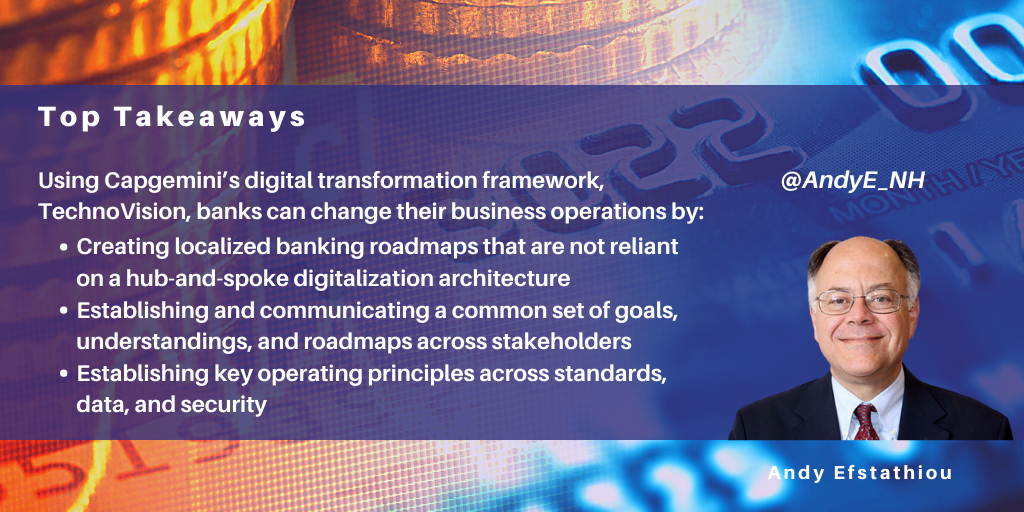
The pandemic has accelerated the adoption of digital transformation across all industries, and in the financial sector, operational transformation has grabbed the top spot in the priority list for investment and spending. At the same time, performance dispersion (the variance across institutions within the industry) has significantly increased.
So, how can banks make their transformation initiatives effective, and what drives performance? Multiple firms, banks, and IT/operations services vendors, are now creating digital transformation frameworks to help improve the effectiveness of these efforts.
Capgemini’s TechnoVision framework
Capgemini has created its own transformation framework, TechnoVision, which identifies key business/technology levers, evaluates technologies, enables initiative prioritization, and supports disciplined creation and execution of a transformation strategy.
Strategic considerations are based on three core principles, backed by technology domains, which are:
- Standards: each technology, and the domain it is applied in, requires customized standards which are set by the ecosystem it operates in
- Data: sourcing, scrubbing, analyzing, and using data in businesses
- Security: security practices relevant to the specific operational environment.
Technology domains under consideration are Cloud, AI, Immersive, Connected, High Performance & Decentralized Technologies. The operational framework is adapted to each industry where it is employed. TechnoVision has the following key components:
- Infrastructure areas for transformation:
- Invisible infostructure: coordination of the technology infrastructure
- Applications unleashed: the application and API domain
- Thriving on data: the data and AI domain
- Process on the fly: the process automation domain
- People-focused areas:
- You experience: stakeholder experience domain
- We collaborate: workforce and partner coordination
- The design principles for transforming delivery technology. Here, the principle of balance by design aims to balance and coordinate people and systems to create sustainable delivery.
The framework allows banks to move from a centrally controlled organization (hub and spoke model) to a decentralized model, coordinated by a set of operational/business standards and a single golden-source set of data. The value of the framework is that it can deliver:
- Growth: driven by hyper scaling in two directions: matching costs/revenues, and the ability to harvest smaller economic opportunities more efficiently
- Efficiency: driven by lower error rates, reduced reconciliation/fixes, improved STP/fulfillment, and lower cost
- Stakeholder engagement: driven by higher CSAT, improved CX, higher up/cross-sell
- Resiliency (losses previously to generational change, silos, and latency responses to societal changes)
Conclusions
Financial institutions of a wide variety of backgrounds and characteristics are looking to undertake digital transformation with third-party services and technology vendors. There needs to be a meeting of the minds among all stakeholders to ensure the transformation process is effective. A transformation framework helps to establish and communicate a common set of goals, understandings, and roadmaps across stakeholders.
Capgemini’s TechnoVision framework for financial services helps banks address transformation issues across the enterprise, including standards, data, and security. The framework has been used in many global and regional banks to define and accelerate the transformation journey. Other services vendors have similar frameworks, though TechnoVision is distinctive in its use of sessions with local banking executives to create localized banking roadmaps which are not reliant on a hub and spoke digitalization architecture. We expect to see Capgemini build more real-time transaction capabilities with its clients to address banking’s move away from wide settlement windows and batch processing.
]]>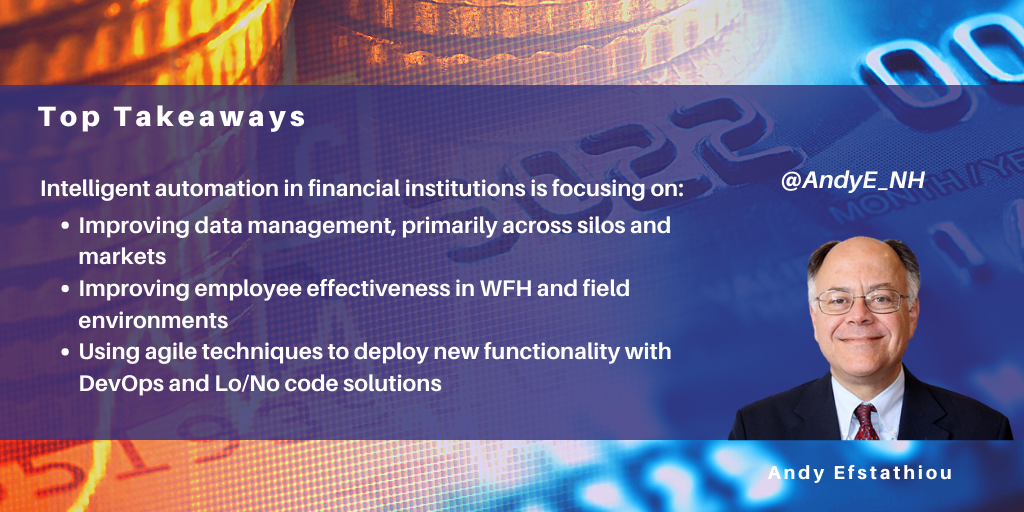
NelsonHall recently published a market assessment and forecast report on Intelligent Automation in Banking: Transforming Operations. We found that financial institutions must automate their operations if they are to compete successfully in a rapidly evolving marketplace. Currently, they operate with manual processes using a heterogeneous set of platforms, acquired over many years of M&A. However, the pace of industry change is increasing, while labor-based operations are slowing financial institutions’ abilities to respond. Cognitive, AI and RPA technologies are allowing these institutions to become more agile, cutting the cord from labor-based value-add, without having to do a rip-and-replace of their existing platforms.
The state of IA in financial services
For the past year, financial institutions have been:
- Expanding the use of process discovery to identify new targets
- Standardizing processes across silos
- Focusing on the use of IA for employees for WFH and fieldwork (especially in response to COVID-19)
- Accelerating their delivery from the cloud
- Adopting the use of hybrid AI/RPA to support agents and advisors.
Over the next year, financial institutions will focus on:
- Managing data across silos and markets
- Using agile techniques to deploy new functionality with DevOps and Lo/No code solutions
- Increasing their focus on human/bot teams and their effectiveness
- Applying IA to low-volume manual processes.
However, the external environment has put up barriers to transformation. The key barriers impeding the efforts of financial institutions include:
- Access to emerging technology: all IA services vendors are building ecosystems for emerging technologies and acquiring staff skilled in relevant technologies. Finding the best new technologies and embedding them in effective platforms remains difficult
- Access to qualified staff: changing technologies changes the required mix of staff skills, and emerging tech is driving a skills shortage. Currently, AI is the most constrained capability
- Changing regulations requiring resources to adapt to them
- The COVID-19 induced move to more distributed operations:
- The need to reduce supply chain risk by increasing the distribution of operations
- Increased use of joint human/bot work teams, and how to make them effective
- Shifting delivery to the omnichannel environment and rearchitecting processes
- Changing business models: the advent of digital banks (e.g., Marcus) and the need to create new competitive business models to address this challenge.
Rising to the challenge
To address these challenges successfully, financial institutions need to focus on two activities: vendor selection and execution.
Key factors in vendor selection include:
- Preferred product vendors should have the widest pool of IT services providers supporting them
- Focus on services vendors with skills in process discovery, breadth of solution partnerships, willingness to invest in operations, AI, domain knowledge, and data management capabilities
- Building an ecosystem of vendors with knowledge of client’s business issues; complementary skills to build and deliver IA services;, and the ability to work within client operational practices
- Changing the operational model: banks need to shift from operational leverage (scale economies) to leveraging flexibility (ability to cost-effectively switch out workloads).
Key factors in execution include:
- Preferred vendors should have the widest pool of solution providers supporting them
- Redefining what is delivered by third parties, internal, and cloud to maximize flexibility and speed new intelligence and automation
- Focusing on increasing the yield of use cases by focusing on KPIs for successful use cases
- Transforming application development to a DevOps model to speed the innovation cycle.
In summary, financial institutions are changing their goals in two important ways:
- From improving process efficiency to improving data management
- From improving cost efficiency for static businesses to agility for continuously changing businesses.
The operational changes being made will drive business model change. And these operational changes will drive accelerating change in banks’ product offerings, customer base, and market presence.
Find out more about NelsonHall’s Intelligent Automation in Banking: Transforming Operations market assessment and forecast report here or contact Guy Saunders.
]]>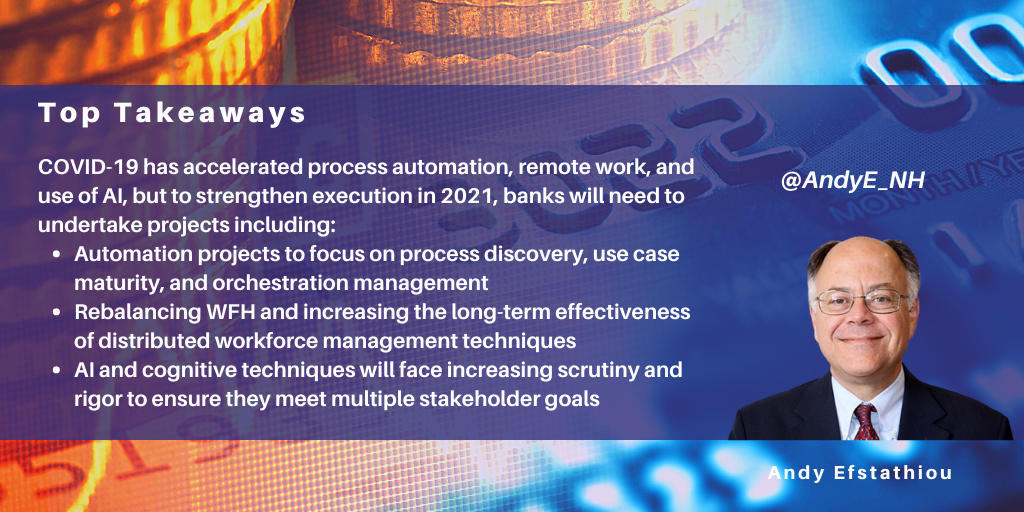
Banks will spend 2021 pursuing different aspects of three key initiatives that have become more important since the advent of COVID-19. The first is process automation, which has become more important but needs to increase its delivery effectiveness. The second, work-from-home (WFH) has also accelerated under COVID-19 but will need to change in 2021 to continue to be effective. The third is the application of cognitive to processing. Cognitive is an immature technology and has had teething pains with bias and ethics. Users of cognitive technologies will need to include controls to meet ethics requirements that society requires of its business community.
Process Automation
Process automation has been an accelerating trend for the past four years. Since COVID-19 struck earlier this year, the adoption rate of automation has pulled three years of anticipated adoption work into the second half of 2020. However, this acceleration has highlighted key challenges to effectiveness. They are:
- Process discovery: the acceleration in the pace of adoption has highlighted that banks do not fully understand the processes and process bottlenecks that need automation. Multiple vendors have been developing enhanced process discovery tools to increase the speed at which banks can identify processes
- Use case yield: most banks have been toying with many POCs to try to improve process effectiveness. However, the majority of cases (sometimes as high as 90%) fail to meet their required rate of return to justify their deployment. Third-party vendors are well-positioned to improve the yield on POCs due to their work with multiple clients in many industries. Increased rigor of use case development, based on experiences to date, will enable higher throughput from conception to operations
- Orchestration: once the bots are deployed, especially in a highly distributed environment such as cloud or multi-country, effectiveness declines rapidly. Orchestration tools are being built and improved to improve effectiveness.
These issues have become a priority for banks. Our conversations with bank executives indicate their highest priorities for RPA engagements are:
- Increasing the yield to operational deployment from POCs and use cases
- Maintaining the effectiveness of bot deployments while adapting the operational environment to changing business conditions.
In 2021, they will focus their automation initiatives on compliance (especially the conversion of loan contracts to a post-LIBOR world), customer service, improving agent effectiveness, and KYC/AML reviews.
Work from Home
The COVID-19 world has seen a mass migration to WFH. However, CEOs and other leaders are concerned about workforce morale and training issues over the long term. Bankers we have spoken to expect WFH will remain a larger part of the financial services environment, but much smaller than it is today. Specifically, interviews we have conducted indicate banks expect 70% of workers to move back to offices and ~30% to remain in a WFH environment. Over the next year, institutions will have to work out what the shape of the new workforce deployment will be. Key issues will include:
- Which workers will be on-premise and which in a WFH environment?
- What are the criteria for working in each environment?
- What are the conditions and frequency of being on-campus or off-campus?
- How will this impact the shape of teams?
- What automation and security will be required to support workers over the long term in this new environment?
Until the lockdowns end there will not be much movement on this issue. However, the second half of the year should see the economy open up and these issues will take center stage.
Cognitive Processing Support
Banks and technology vendors have been developing and trialing cognitive support tools for many years now. The aggressive move to digital channel environments caused by COVID-19 has both enabled the application of cognitive tools to business processes and necessitated the use of cognitive tools to deliver services. However, accelerated deployment of cognitive tools has highlighted challenges including:
- Bias: ML and AI tools are inherently backward-looking. Improving society or reducing inequities will not happen from a backward-looking analysis. The algorithms, use cases, and human oversight of these tools will be overhauled in the upcoming year
- Compliance: to date, the primary use of cognitive has been within an individual market and silo at a bank. Moving into 2021, banks are looking to deploy cognitive across silos and markets. Understanding data from across heterogeneous environments is a big challenge, but regulators are requiring banks to deliver on this.
The above growth areas of technology services for banks in 2021 are the result of 2020’s rapid deployment of immature technologies. Each of the three growth segments of services will, as usage matures, provide banks with increased agility to adapt to a rapidly changing business environment.
]]>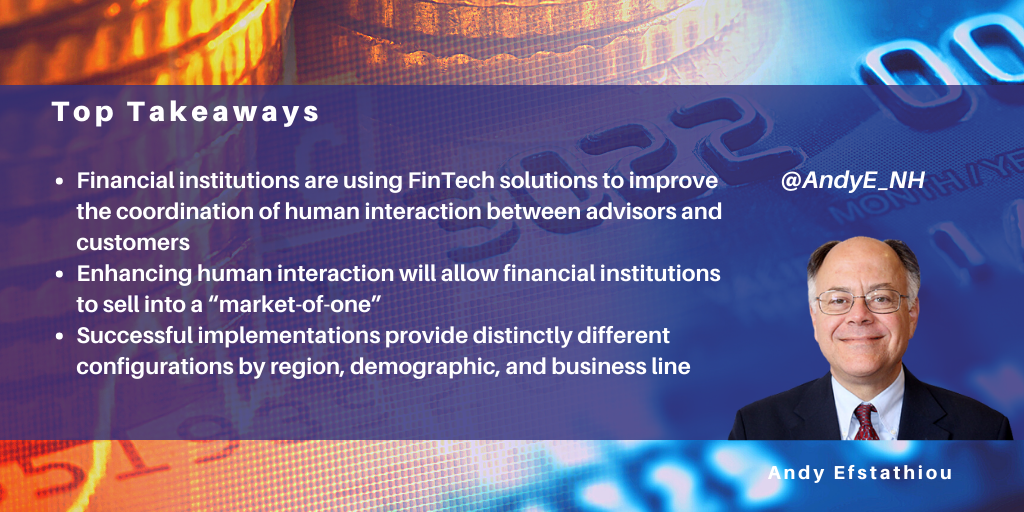
It has been extensively reported that industries requiring in-person interaction, such as travel and entertainment, have been adversely impacted by the COVID-19 pandemic. Less obvious has been the impact on industries that are often typified by remote delivery. For example, the wealth and asset management industry is primarily driven by the long-term buildup of wealth and involves infrequent face-to-face meetings.
During 2020, global stock markets have recovered from the March stock market decline (but maybe relapsing in late 2020) when COVID-19 became a household word and businesses were forced to respond. However, despite its advantages, the wealth management industry is still facing strong headwinds from COVID-19 impacts. Overall, industry Q3 results for wealth management businesses have shown strong revenue performance based on strong market appreciation, but not from new business. To maintain operational strength, wealth managers will need to attract new customers and assets to perform well when future market breaks occur.
Three emerging trends can help wealth managers to grow their revenues and control their costs. These trends include:
- An emerging younger customer demographic which prefers very different methods of interaction (primarily digital and mobile interactions)
- Open banking ecosystem of vendors providing products for improved CX and a broader product mix
- Mass affluent offerings of existing product types and, in the future, increased customization of offerings for each customer (hyper-personalization).
Many financial institutions and services vendors are grappling with ways to enhance the customer experience in partnership with human advisors. Improving the coordination of interaction between advisors and customers is a complex, highly human, challenge that firms are beginning to address. For example, Capgemini has developed its Augmented Advisor Intelligence solution to support matching the right investment advisors to individual customers by analyzing and then leverage the advisors’ traits including:
- Prospecting and compatibility scoring
- Propensity modeling
- Next-best action decisions
- Value-based segmentation
- Model financial advisor
- Best practice behavior.
By drawing on internal data (advisor past customer interactions and portfolio) and external data (customer demographics, sentiment, portfolio, and behaviors) the platform uses ML and AI to provide advisor matching recommendations, investment and portfolio recommendations, and best practice recommendations.
The benefits for the wealth management firm include:
- Ability to assign advisors to customers based on fact-based analysis of personality, behavior, and lifestyle matching
- Ability to track and monitor advisor performance, including prescriptive analysis of problems that may be developing
- Improved targeting of outreach and customized offerings to customers, which can increase marketing campaign ROI
- Improved ongoing advisor/customer interaction by use of sentiment analysis of digital communications and improved routing allocation and recommendation options.
The application of this platform across markets has resulted in distinctly different regional requirements, including:
- Mature markets: young people are the primary growing demographic. The focus is on developing omnichannel access to digital-based investment services for customers familiar with wealth management activities but dissatisfied with traditional delivery methods
- Emerging markets: small business owners, often middle-aged are the primary demographic. The focus is on supporting investment into growing their businesses
- Mature Asian markets: rising young professionals are the primary demographic. The focus is on developing a set of mass affluent products that can grow in value to service the lifetime financial needs of individuals with limited or no family experience with financial products.
In short, vendors are trying to move beyond tracking and analyzing customer traits and propensities, to analyzing and changing advisor/customer interactions to optimize CSAT and business effectiveness. Enhancing human interaction will allow financial institutions to sell into a “market-of-one” effectively. These tools will enable consistent success in matching advisors to customers and reduce the cost of delivery to enable greater adoption of mass affluent wealth management offerings in all marketplaces.
Capgemini’s approach to enhancing advisor/customer interactions and relationship management provides a comprehensive approach to this challenge. It identifies stakeholder attributes, predicts behaviors, manages ongoing interactions, and evaluates ongoing relationship health. Most intelligent solutions focus on improving transactions. This type of platform enhances customer lifecycle management performance by improving communication and understanding between human beings.
]]>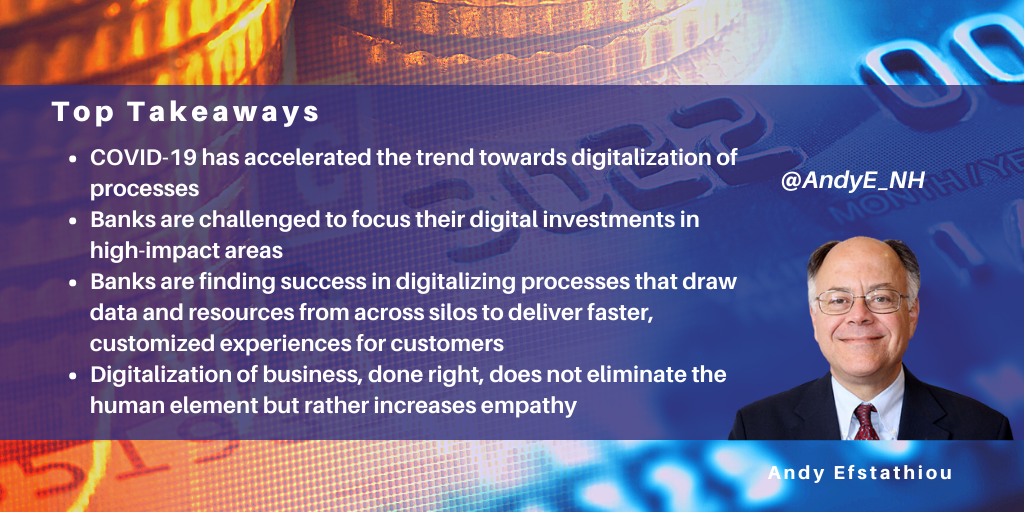
I recently participated in a webinar panel during the Consumer Banking Association conference with Genpact and TD Bank. The panel topic was Genpact: Turning Crisis into Opportunity for Consumer Banking, and it addressed three core topics:
- The global health and economic crises have reshaped consumer banking
- Banks are adjusting to serve customers digitally while trying to maintain empathy and human connection
- Banks can accelerate and prioritize their digital investments to drive real change.
The COVID-19 crisis has accelerated previous trends towards digital adoption, including:
- Cloud migration, as banks have moved from a single cloud strategy to a hybrid, multi-cloud strategy
- Omnichannel migration, as banks close branches and expand online alternatives
- Cybersecurity adoption, as banks seek to secure their data and operations in the cloud.
TD Bank has found that banks have moved at light speed to implement the PPP Act and financial relief offers for customers. TD Bank’s relief offer, TD Cares, was built with three concepts in mind:
- What benefits do stressed customers need?
- What products can best deliver these benefits?
- Outreach to customers the bank anticipated might need support. The guiding principle is meeting the customer where they are (online, in-person, etc.).
The delivery of these services was developed with a “digital-first” approach, followed immediately with human interaction to support robust interaction and CSAT.
Overall, banks are trying to prioritize where they will be spending their money. When a bank looks at digitizing a process, such as onboarding or payments, where in the value chain should it start and focus their investment dollars to make the largest operational impact? The key to succeeding in delivering value is to optimize the customer experience. To date, banks have looked at improving their processes. However, customers are comparing their online experiences against their experiences form other industries, such as the consumer products or entertainment industries.
COVID-19 has forced banks to rethink how and when they engage customers. Key examples of changes made include:
- Much faster decision-making process (e.g., for lending). Digitalizing applications and providing STP to decisioning algorithms has enabled closer to real-time approvals for standard borrowing requests
- Real-time digital channels: by deploying armies of chatbots, AI, and decision trees; banks have been enabling employees to engage across all channels with customers while knowing who the customer is in real-time.
The banks are not just trying to improve efficiency, they are trying to create empathetic, differentiated experiences in their customer interactions. Creating a value chain that delivers digital, empathetic, differentiated customer experiences will require a synthesis of bank operations, data management, and FinTech partner ecosystems. By integrating digital processing, bank/customer data, and new functionality from an ecosystem of vendors, banks should be able to know each customer and create a custom experience for that customer. The industry is in the early stages of creating such customized experiences, but the journey has begun. For example, a bank has been able to deliver empathetic, customized experiences by digitalizing customer contact apps across silos. This requires all stakeholders to participate to move a project ahead both thoughtfully and at speed.
Banks are not just building customer contact experiences with digital technologies. The panel identified payments as an area of rapid transformation, where customers experience the use of the product itself as a consumer experience. There are two areas within payments that are a focus for innovation today:
- Payment initiation: identifying the payor at the POS to provide a seamless, real-time payment experience
- Post-payment services: delivery of services such as credit extension and loyalty program assignment.
Again, modularizing the process with support from an ecosystem of specialized vendors is enabling payment companies to restructure the industry and improve customer experience.
The key takeaways from the webinar panel are that, because of COVID-19, banks are moving faster than ever to digitalize their businesses. The digitalization of business does not eliminate the human element but rather increases empathy and human engagement to drive a differentiated experience. Because the canvas is large, banks are challenged to focus their investments in high-impact areas. The areas where banks are finding success are in digitalizing processes that draw data and resources from across silos to deliver faster, customized experiences for customers.
]]>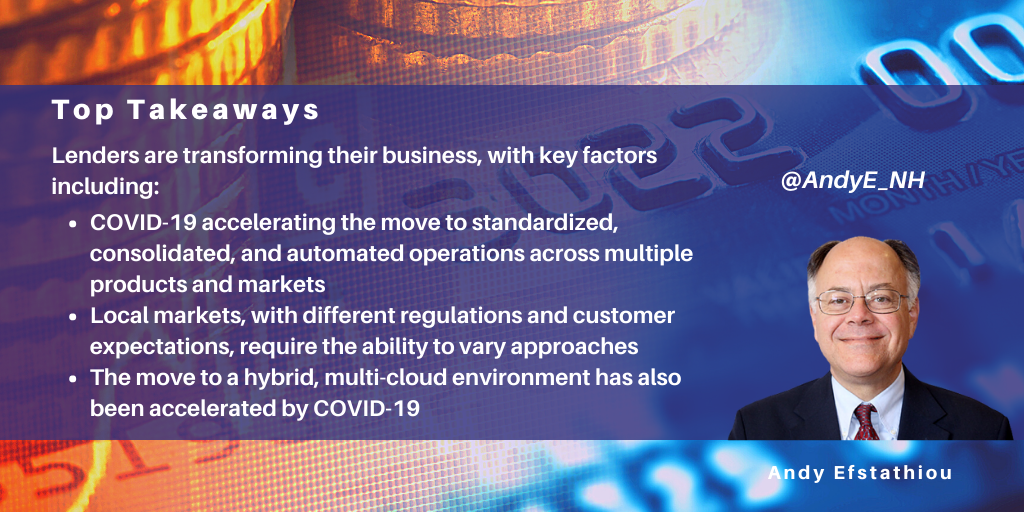
NelsonHall recently completed a market assessment and forecast report on Transforming Mortgage and Loan Services. We found that the lending industry is undergoing profound operational change as it adapts to slowing loan growth and emerging customer populations that are younger and more technology savvy. For the past two years, lenders have been:
- Variablizing and reducing the cost of operational delivery using automation, AI, and third-party operations delivery
- Moving to hybrid cloud delivery. This trend is still in the early stages and has been accelerating with the advent of the COVID-19 pandemic
- Standardizing, consolidating, and automating operations across multiple products and markets. Most lenders have been built via M&A and they have tried to differentiate themselves with new loan product features. Standardizing their heterogeneous platforms to reduce cost of delivery and unify customer experience is a high priority
- Focusing on cost reduction for high-cost processes. Origination, due to its high cost ($3k to $7k per closed retail mortgage in the U.S.) has been the highest priority target for cost reduction.
COVID-19 & other challenges
The COVID-19 pandemic has accelerated these trends and initiated an aggressive move to remote work. Remote work has increased the need for strong cybersecurity and for robust national infrastructure in some emerging markets to support remote delivery.
The external environment has put up barriers to transformation. The key barriers impeding their efforts include:
- COVID-19: lenders have been focusing on maintaining operations, while shifting to a work-from-home (WFH) environment. The impact has been to put transformational projects on hold for the short term
- Competitive landscape: the introduction of all-digital lenders, with unproven business models, has led many incumbent lenders to take a wait-and-see approach to business model change
- Changing technologies making long-term investments risky.
For lenders operating in multiple markets, local requirements make transformation difficult. Market-specific requirements that make a standard global delivery methodology impossible to achieve are:
- Local markets require different licenses and procedures, and feature different customer expectations and competitive landscapes
- Evolving loan product types are based on new data fields and product attributes, making existing taxonomies obsolete.
Lenders adapt transformation strategies
Transformation strategies have had to take these barriers into account. While they have postponed many initiatives, lenders have not abandoned those projects. Currently, lenders intend to restart projects when the impact of the pandemic is clearer, and prior to full resolution of the pandemic. At this point, it looks like these projects will restart by late 2020.
Digital transformation goals for lenders are changing from cost-focused to agility-focused goals. Key changes in goals for transformation projects include:
- Strategic goals are moving from reducing costs to changing business models:
- Moving from enable remote customers to enable remote employees (due to COVID-19)
- Transforming to an open banking environment with large ecosystems of partners
- Financial goals are moving from optimizing at fixed volumes to optimizing at constantly changing volumes:
- Increasing flexibility by reducing breakeven volumes and ability to react to change
- Improving STP by tying front-end to back-end for faster TAT
- Increasing sales by taking on new customer types facilitated by better analytics
- Engagement goals are moving from “same mess for less” to “transform”:
- Standardizing and consolidating platforms and methods across silos
- Automating to reduce the labor component and manual errors
- Changing DevOps to facilitate faster, modularized platform renewal
Summary
In summary, vendors are changing their goals from cost efficiency for fundamentally static businesses to agility for continuously changing businesses. The operational changes being made will enable and drive further change in the business. These operational changes will drive accelerating change in lenders’ product offerings, customer base, and market presence. The mortgage industry is at the start of a decade-long transformation of its business model.
Find out more about NelsonHall’s Transforming Mortgage and Loan Services market assessment and forecast report here.
]]>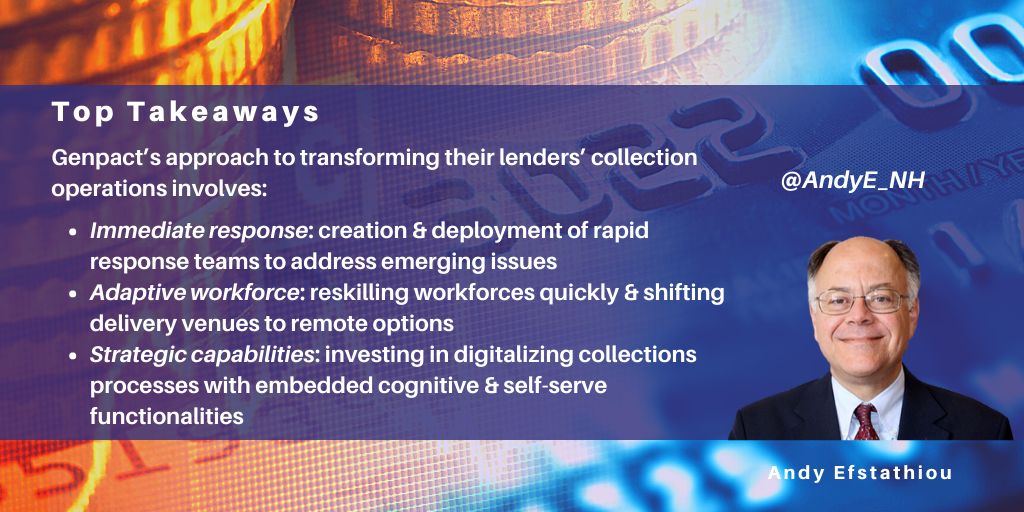
The past decade since the global financial crisis (GFC) has been good for the lending industry. Loan delinquencies in the U.S. reached their highest level after the GFC in the first quarter of 2010 at 7.4% of commercial bank loan portfolios. Since then, loan delinquencies have fallen to 1.44% of loan portfolios as of the fourth quarter of 2019. At the same time, loan portfolios have grown 26.8% larger than they were in the second quarter of 2013. During this period, banks and lenders have reduced collections staff as delinquencies have declined. Banks can support delinquency collections if portfolios maintain low default rates.
However, COVID-19 has had a major adverse impact on the economy. During this time unemployment rates have surged and GDP forecasts have plummeted.
This type of economic contraction will aggressively drive up collection activities at banks. But scaling collections activities will be challenging when all lenders will be trying to scale-up their activities at the same time, and as new regulations constraining collection methodologies are being issued.
The automation and operating framework will be critical to successfully navigating the collection environment. I recently participated in a Consumer Bankers Association hosted webinar with Genpact where they outlined their approach to improving collections services. Genpact has developed a three-part methodology for transforming their clients’ collection operations:
- Immediate response: creation and deployment of rapid response teams with simplified decision-making structures to address emerging issues and deteriorating portfolios
- Adaptive workforce: reskilling workforces quickly and shifting delivery venues to work-from-home (WFH) or other remote options
- Strategic capabilities: investing in digitalizing collections processes and embedding cognitive and self-serve functionalities
The challenge is large, so success requires a set of prioritized actions to make early gains possible. Examples from Genpact include:
- Immediate response measures taken to date include efforts to proactively identify and remediate high-risk customers before they hit delinquency. Clients can reduce exposure related to high-risk customers by leveraging machine learning to develop and deploy a combination of credit limit decrease and blocking, or proactively offering customers hardship plans. Using text-mining of agent notes from customer service interactions has allowed early identification and treatment of high-risk customers
- Adaptive workforce measures have had the highest activity to date, and include:
- Rapid, remotely delivered workforce training. For example, Genpact is helping a top 5 global bank is ramping up their operations from 600 to 1600 skilled collections resources
- Workforce multiplier support such as a group of rapid response teams (cross-functional teams that can address the rapidly evolving customer dynamics through agile pods). These teams deliver services such as surge-capacity hiring, training, and deployment all with WFH solutions
- New models of data usage, both new data forms, and alternative data streams. COVID-19 has changed customer behavior, and ML needs to be used to identify new customer segmentation patterns and the appropriate response. This is not a one-time activity; it requires weekly refreshes as the data/behavior changes
- Regulatory changes such as the Consumer Financial Protection Bureau’s recently published new contact policies. Straddling compliance and good practice is the need to define and test what empathetic response should be. There are no clear metrics, particularly when it comes to a customer situation where they may be impacted economically, socially, and health-wise
- Strategic measures taken to date include investments in:
- Channels of customer contact and payment beyond the voice channel, including chatbots and self-service
- Automation of manual back-office processes in collections using RPA or workflow solutions, so that agents can focus on customer management. This has been especially useful for implementing the CARES Act program
- Use of AI, ML to develop and offer unique hyper-personalized treatment strategies suited to specific situations and requirements of individual customers. These customized solutions can reduce customer hardship as it considers the individual realities to make the debt more manageable for customers
- Building empathy into conversational tools: for example, real-time speech analytics and conversational AI to prompt effective payment plan matching to customer needs using the appropriate verbiage usage based on customer talk
In short, scaling the same processes, under conditions of reduced resources, increased costs, and growing transaction numbers will not work. Already vendors are addressing these challenges by employing combinations of proactive outreach, workforce training, and technology. Lenders will then be able to increase their effectiveness and scale in collections to meet the rapidly increasing scale of operational delivery required.
To find out more on this topic, view the Consumer Bankers Association hosted webinar with Genpact and NelsonHall here.
]]>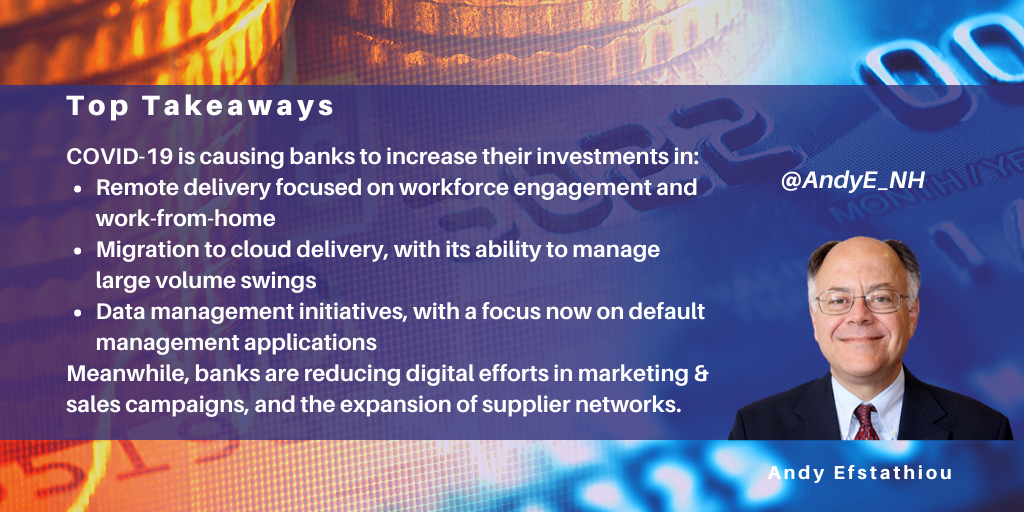
This is an update on my last blog on the impact of COVID-19 on the financial services industry. Since then, I have interviewed many more industry executives both at banks and at operations services vendors. Industry responses are still muted, but clear signs are emerging that banks will be focused on prioritizing those activities which maintain continuity and support adaptation in an operating environment with larger volume swings.
Key transformation initiatives where banks are accelerating investments include:
- Remote delivery focused on workforce engagement and a relatively reduced effort in remote customer engagement
- Migration to cloud delivery, with its ability to manage large volume swings
- Data management initiatives, with a focus now on default management applications
- Consolidation of operation solutions and methodologies. These are longer-term initiatives, but much higher ranking for global institutions than before COVID. At the same time, banks are increasing their search for multiple supply sources.
Banks have reduced their activities focused on support for:
- Marketing and sales campaigns: business growth which requires capital has been sidelined
- Expansion of suppliers: banks are now focused on vendors with the strongest financial positions.
Impact on banks to date
To date, the impact on retail banks and capital markets firms has been to move workforces to a work-from-home (WFH) environment. This has not been a hard initial transition for banks in markets with mature internet infrastructure; however, banks in markets with weak public internet infrastructures, such as some Asian markets and most of Africa, have faced significant challenges moving employees to a home environment.
Even within markets, the success of moving to WFH has varied as government policies have changed. In India, the nation went into lockdown on March 24 for 21 days. This was extended to May 3 on April 14. Initially, many delivery centers struggled to move workers to a WFH environment, given a limited number of laptops per worker and poor connectivity in some regions. Over time, bank operations have been able to obtain permission for critical processes to be delivered from centers, with dormitory and hotel housing provided for workers. Non-essential processes have continued to be delivered from home. This has led to worker utilization rates at the largest delivery centers moving from an initial capacity utilization rate of 20% in late March to 60% utilization in early April, to 90% utilization rate with essential work done in centers and large numbers of WFH workers.
While operations delivery has rebounded, bank executives we have interviewed expect their businesses to aggressively deteriorate in Q2 2020. Specifically, they expect sales to decline ~25%, costs to increase ~7%, and profits to decline ~45% in Q2 2020. Fortunately, their operations supplier contracts are adequate to support a 20% decline in volumes (and a 25% increase in volumes). No one is sure how long the impact on business will continue. Based on announcements by governments and universities in the past few days, this analyst expects the COVID-19 lockdowns to continue, at some level, for at least six months. The saving grace may be that the continuing shutdowns will be at progressively lower levels of restriction.
Banks have been asked by regulators to provide BCDR plans for themselves and their suppliers. These have been supplied. Of note is that private conversations indicate banks and suppliers are setting triage plans for who and what to focus resources on if the impact of COVID-19 worsens. If that happens, expect to see suppliers retaining service to their most important clients and banks cutting back on product lines (i.e. low margin and risk products) and reducing suppliers to financially stronger vendors.
Transformation projects in production have continued as planned. However, new projects have been stopped in anticipation of restarting the process when lockdowns are lifted. However, as profit levels fall, the focus on cost-cutting will increase. Banks will have to prioritize which projects to restart as they face reduced capital to invest in transformation. Currently, many banks are looking to restart RPA projects when they resume projects. Successful RPA projects can scale processing volumes with a smaller workforce. Because scalability has become so important, banks are looking to restart initiatives that enable scaling, such as RPA and cloud migration.
Finally, bank product lines have been aggressively impacted. Lending, except for government support loan programs, has all but stopped in all countries. Payment volumes, especially cross-border payments, have plummeted by over 20%. Physical branches have been shut down for business. The fall in activities has reduced operational requirements, but at the cost of profits for banks and revenues for their services providers. While bank executives have not projected volumes beyond Q2 2020, the outlook is very weak for a turnaround during the remainder of this year. ITS and BPO vendors will have stable revenues from long-term contracts. However, these vendors will find that new contracts are few and far between. Some BPO vendors are expecting to grow their business at +20% (annual rate) by buying bank or service vendor captive operations. As bank and vendor liquidity becomes a concern to regulators and investors, there are now captive operations actively for sale. For the next year, successful BPO vendors will have an active M&A strategy in place.
Conclusions
To summarize, banks have not yet changed their operational delivery activities with third-party vendors. They have reassessed their BCDR plans. Financial institutions have begun to see very substantial drop-offs in transactional activity, and they expect this to impact their revenues and profits starting in Q2 2020. The largely anticipated drop-off in revenues and profits will drive a reassessment of their services contracts to drive lower pricing and sale of operations. There will be a consolidation of vendors and pressure on pricing. The scale and scope of the transformation in sourcing arrangements will be driven by the length of the COVID lockdown. When the lockdown abates, banks will redouble their efforts in digital transformation to prepare for any future pandemics.
My next blog post will address the impact to date of COVID-19 on services vendors to the banking industry.
]]>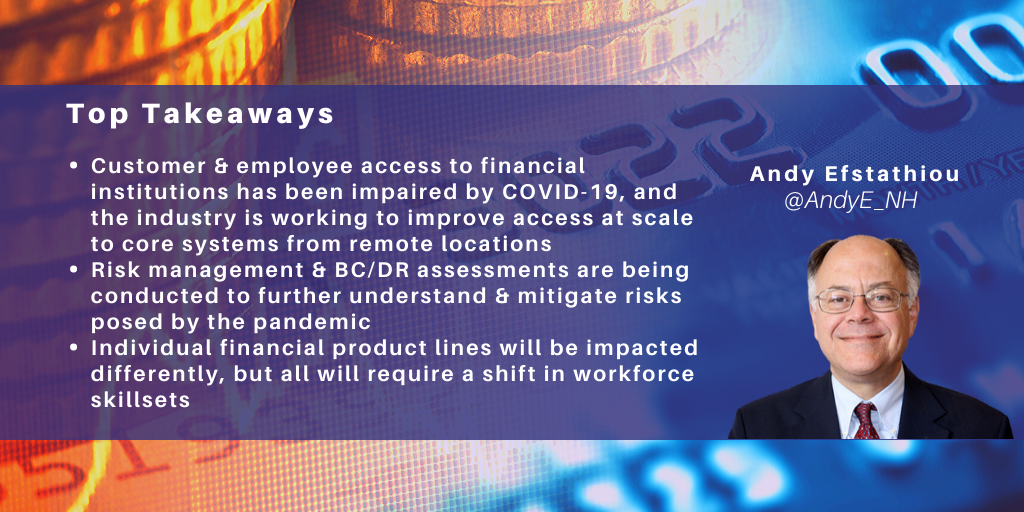
COVID-19 is impacting banking operations and, as a consequence, related business process services (BPS). Banks are already restructuring operations to address the emerging challenges from COVID-19 (see below for those challenges). The changes are just beginning and will continue to evolve over at least the next four months. While the global adaptation to COVID-19 will take much longer, perhaps several years, each country’s banking industry will need to make sizable adaptations to their operations in a four-month timeframe in order to survive without permanent impairment to their business. The four-month timeframe for adaptation within each country assumes two months for COVID-19 to stabilize in each market and two additional months to implement measures to mitigate any future pandemic risks. Across all markets, operational adaptation will take one to two years to fully implement.
Operational impacts to date
So far, the operational impacts have manifested across customer access and employee access.
Access for both customers and employees has been impaired due to:
- The inability of customers to enter brick-and-mortar locations, often due to the imposition of lock-downs by governments
- Volume spikes in transactions creating online access and processing delays, often due to market reactions (e.g. stock market declines and liquidity demands)
- Alternative demands on time (e.g. from children at home)
- Inability to conduct standard sales and customer in-person interaction.
Actions being taken to mitigate these impacts have included:
- Increasing remote access options by:
- Increasing capacity for online access, typically via increasing cloud access to core systems
- Sending omnichannel access apps to customers for their use
- Outbound messaging on what options are available for remote access
- Scaling processing capacity by increasing:
- Access to remote temporary labor
- Use of RPA
- Cloud capacity of core systems (especially transaction systems)
- Processing capacity to match diurnal demand spikes
- Operational hygiene reviews, including:
- BC/DR plan updates
- Liquidity planning (including drawdowns of credit by BFS clients)
- Reviews of in-branch operations changes, including increased availability of cash in branches and customer interaction SOPs
Bank product line impacts
The impact of COVID-19 within the banking industry has varied by product line, as follows:
- Commercial loans: increased drawdowns of committed loan lines by customers to assure liquidity. Also, certain consumer-focused industries such as restaurants have shut down operations, cutting off revenue-generating capabilities. These activities have increased risk exposure, tracking efforts, and funding requirements. Operational impacts include increased data gathering and reporting requirements
- Payments: retail customers withdrawing physical cash from branches to assure liquidity if banks are shut for a period. This temporarily increases operational loads on the branch system. Operational impacts include increased staffing and a shifting product mix for daily operations at branches
- Mortgages: anticipated loss of income will reduce loan origination demand while increasing the need for default management. Operational impacts include changing skill sets required for bank workforces and increased loan loss reserves. Increased loan loss reserves directly require reductions in the balance sheet. Shrinking the balance sheet requires significant senior executive effort.
- Student loans: temporary closure of colleges seems likely to reduce demand for new student loans but is likely to lengthen the repayment period for existing loans. Reduced job prospects increase default management requirements. Operational impacts include changing skillsets from loan origination to default management.
Additional impacts by product line will emerge over time. Trade finance will likely be very heavily impacted by the pandemic.
Conclusions
To summarize, operational impacts to date have been focused on reduced in-person access to financial services purchase and delivery. Business impacts to date have been focused on increased credit risk and the shift in resources from revenue generation to risk mitigation.
We expect that over time the impacts will cause banks to shift product mix, employee skillsets, and channel delivery. The costs of changing products, workforces, and delivery will be very large.
We will be monitoring this space to develop a much more granular understanding of how these impacts will reshape financial services operations. We are conducting multiple banking executive interviews (>100) across all geographies to ascertain:
- Emerging priorities
- Lessons learned
- Best practices
- Impact on business
- Decisions made.
We are also conducting interviews with leading BPS suppliers to ascertain the impacts on their business and how they are responding to the impact of the COVID-19 pandemic. We will be reporting on this rapidly evolving dynamic over the next several weeks.
In the meantime, we would like to hear your feedback.
]]>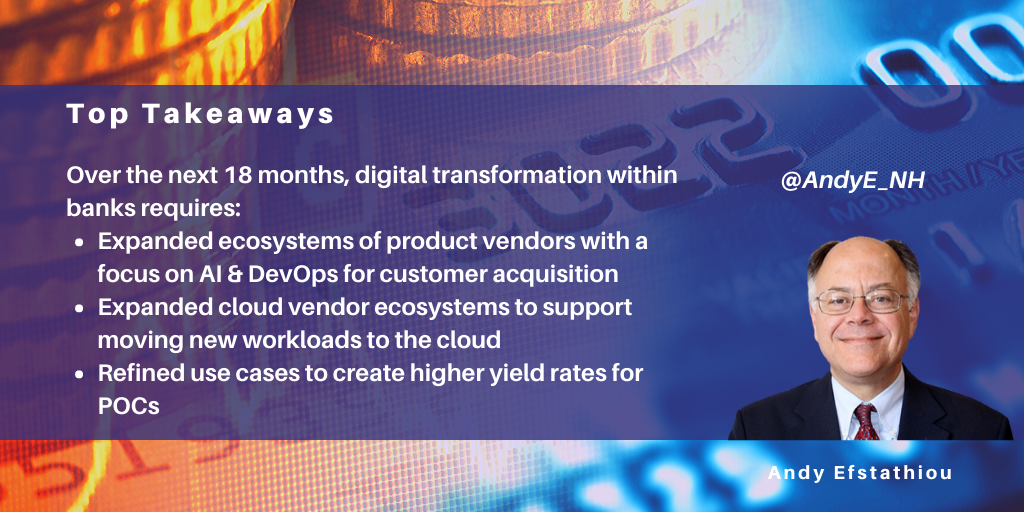
Banks have been aggressively transforming their operations to a digital delivery model. It is well known that a key driver, across all industries, is the need to attract new, primarily young, customers who prefer omnichannel interaction with vendors and demand high-quality CX in their business interactions. Less well known are two key drivers that make speedy transformation imperative. They include:
- Open banking regulations: they are driving changes to the business model. A successful transition requires operational agility, efficiency, and accuracy to enable emerging models and openness to allow external participants
- Price compression: the need to increase revenues to offset price compression requires improved sales/marketing campaigns with analytics, improved coordination across silos, and faster time to market for new banking products.
Regulations and price compression are making transformation an urgent need. However, the back-end structure of banks, monolithic 30+ year-old legacy platforms, present transformation challenges. Key challenges include:
- Digital technologies: emerging vendor landscape requires significant ongoing due diligence efforts
- Accessing emerging technological capabilities requires deciding when to partner, use open source, acquire, or share products
- Cybersecurity: increasing use of cloud, shared, and open environments increase vulnerability to cyber threats
- Open banking requires the ability to adopt new digital business models, both in services delivered and internally delivered ops
- Standardizing process execution: Agility to adapt standardized execution to new processes, ending obsolete processes and standing up new processes. Agility is created from the successful assembly of software modules as required
- Cloud/PaaS/systems integration/consolidation: Banks need to standardize platforms to drive STP. Banks have limited internal staff, requiring third-party support for new platforms and operational delivery.
To address these challenges, services vendors have focused on professional services for on-premises platforms for large banks and cloud-delivered platforms for startup and regional banks. Increasingly large banks are looking for hybrid cloud-delivered platforms and modules. Digital technologies have reduced the effectiveness of labor arbitrage strategies. Vendors are aggressively automating their own delivery to remain relevant. Cloud-delivered DevOps is increasingly in demand by all clients. Banks want support for analyzing transactions and entities (customers and counterparties) to drive greater analytic insight and capability development.
Over the next eighteen months, services vendors will:
- Expand and deepen their ecosystems of FinTech product vendors with a focus on AI and DevOps for customer acquisition
- Expand their cloud vendor ecosystems to support moving new workloads to the cloud
- Expand their API libraries to support new markets and the integration of banks’ vendors into their digital operations
- Enhance their tools’ ability to make predictive analyses, not just descriptive analyses
- Connect front-end customer engagement to back-end processing, enabling STP and rapid fulfillment
- Refine their use cases to create higher yield rates for POCs (an increase from the current rate of <60%).
Banks we have spoken with are accelerating their plans to move to digital operations, both transforming their legacy operations and starting new digital initiatives. Many “all-digital” startups at established banks have shut down as the initial use cases failed to meet their goals. The common underlying reason for failure is that digital banks do not run themselves; they require ongoing investment and attention in order to succeed. Similarly, cloud operations do not reduce the cost of delivery in the long run. Cloud operations increase flexibility, which allows banks to enter and exit markets and products with minimal cost to the business. Banks with a clear roadmap and determination to go all-in on digital will have the best chance at creating a successful digital business.
]]>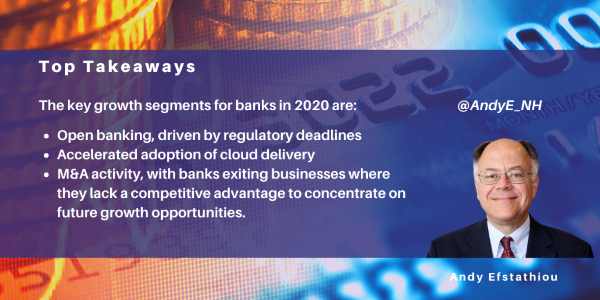
Banks will spend 2020 pursuing three key initiatives that have not been a priority in the past. Two of them, open banking and cloud delivery, are technology environments that have just recently matured to the extent that banks are able to drive business model change with them. The third priority is M&A driving large ITS engagements, and is typical of late-stage economic cycle activity. However, we are in a ten-year long economic expansion, and high levels of M&A have not been seen since the last late cycle stage.
Open Banking
Regulatory deadlines are driving open banking adoption, and Europe is the leader in open banking regulation. The two key regulations PSD2 (European) and The Open Banking Standard (U.K.) had go-live dates in September 2019, and the trend started strongly in the closing months of 2019. In the U.K. from Sept. to Oct. 2019, the number of regulated providers was up 4.4% and the number of regulated entities with a live offering to customers was up 9.4%. Those numbers run at ~200% per year growth when annualized, and the pace will accelerate in 2020.
Our conversations with bank executives indicate their highest business priorities are:
- Increasing average revenue per customer
- Launching new products and services to generate new revenue streams.
In 2020, they will focus their open banking initiatives on customer services, online commerce, and payments to drive customer acquisition and revenue growth.
Cloud Delivery
Banks are moving to the cloud to reduce time-to-market and cost of delivery, and are moving to hybrid multi-cloud environments. Hybrid cloud, the use of private and public clouds, will remain the paradigm of choice. In 2020, the use of public cloud will accelerate aggressively, with tier one banks increasing their allocation to public cloud from the current 3% of overall IT environment to 6% by mid-2021. Multi-cloud, the use of multiple cloud vendors (e.g. AWS, Azure, Google, IBM, etc.) will also increase. AWS was very early to the cloud game and has developed strong functionality. New vendors are rapidly building cloud capabilities (such as consumer data management capabilities at Google) which will target specific workloads. Increasingly, banks will engage with cloud vendors for specific workloads due to proprietary functionality.
IT services vendors will support banks’ initiatives by delivering cloud services with cognitive-enabled operations using proprietary components to support business model change. The new business models will focus on rapidly introducing new low-margin bank products, which have low financial risk. This will allow banks to focus less effort on portfolio risk management and more effort on increasing sales per customer. Expect to see an explosion of deposit products and highly standardized consumer credit products. Many of these products will have much lower sales than were needed in the past. However, low-cost cloud delivery will drop breakeven for each product, allowing for the profitable expansion of low-volume products targeted at consumer life-stage needs.
M&A
M&A by banks grew in 2019 and will accelerate in 2020. Banks are exiting businesses where they lack a competitive advantage and are selling those businesses to concentrate on future growth opportunities. Most sales are to other banks, but in some cases banks are selling their operations centers to third-party services vendors. For example, recently, Cognizant acquired the operations of three Nordic Banks which were joined into one vehicle, Samlink.
M&A deals derive most of their value from a rapid transition to integration into the acquiring organization. The integration process requires ITS to integrate technology systems and business process management services to integrate operations across the two institutions.
Successful, rapid integration requires burst support in order to transition operations rapidly to the final state. Third-party services vendors are the only available source for skilled labor at scale on short notice. Core banking platform expertise will be key to winning deals, but digital technologies will be required to support the agility needed to cost-effectively re-engineer the operations of both the acquiring and acquired banks. We expect M&A deals will drive even faster movement by banks into cloud delivery, especially public cloud environments.
Each of these three growth segments will provide banks with increased agility to adapt to a rapidly changing business environment. The agility developed will be useful to banks after 2020 as they change their business models once again to address Brexit and the changing financial environment in Asia.
]]>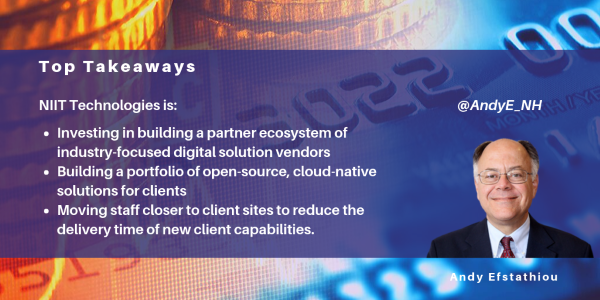
At its 2019 Engage Client Forum last week, NIIT Technologies explained how it is adapting to a continuously changing business and technology environment to deliver digital transformation for its clients.
At its 2019 Engage Client Forum, NIIT Technologies explained how it is adapting to a continuously changing business and technology environment to deliver digital transformation for its clients.
Four key strategies
NIIT Tech identified four key strategies it is pursuing:
- Hyperspecialize in key industries: NIIT Tech has chosen the Insurance, BFS, and Travel industries to focus on. Its teams have adapted their approach from bringing technology to clients to analyzing business problems and bringing in technology to solve a business challenge
- Involute: Tying together cognitive, data, automation/integration, and cloud to accelerate value creation. NIIT Tech believes the next phase of digital transformation in the industry will require stitching together the entire business process with cognitive and digital technology to eliminate bottlenecks which have reduced value creation in past industry reengineering engagements
- Moving the center of gravity closer to the client: by onshoring increasingly, and setting up delivery centers specialized in key industry processes (e.g. the center in Boise, Idaho which specializes in digital integration and Pega services)
- Building a partner ecosystem: clients, including tier ones, have indicated they have difficulty curating an effective technology partner ecosystem. NIIT Tech helps them by scanning the field in a small set of industry domains for solution vendors who offer a product which can be integrated into NIIT Tech client domains in a way that provides agility, lower cost, and digital functionality for the client. The key attribute is solutions that approach problem-solving from a business perspective rather than from a technology perspective. Present at the conference were four FinTech partners:
- Steeleye: compliance technology and data analytics vendor
- Fennech: treasury solution for allocating and reconciling bulk payment allocations
- Appii: employment background check and validation platform which uses blockchain for CV verification
- Duco: data management solution vendor for data normalization, migration, regulation, and reconciliation.
Banking sector focus
NIIT Tech is building proprietary IP to drive forward its digital services initiatives. Key to the banking industry is:
- Open-source software. Key examples include:
- Infrastructure-as-a-code: NIIT Tech uses Terraform, which is an open source infrastructure as code software tool created by HashiCorp. It enables users to define and provision a data center infrastructure, and it works with most cloud provider environments, including AWS, Azure, Google, and IBM
- Core banking platform: NIIT Tech uses BankingEasy, a cloud and web-based, multi-user, multi-currency and real-time, modular, core banking platform. The platform runs on n-tier, service-oriented architecture on Microsoft Azure.
- Application performance management framework: this tool helps clients with heterogeneous legacy environments to manage application lifecycles more efficiently to improve application behavior in a complex operations environment by analyzing the monitored data for the entire relevant operations environment giving real-time performance visibility across the application development lifecycle. It also informs how the application performance is impacting a client’s business and identify areas which require immediate attention. The framework is powered using AI and automation capabilities, thus reducing manual efforts and enabling teams to focus on product innovation.
- Jumpstart analytics: NIIT Tech via its jumpstart analytical offerings, Maestro and Xpresssssss, helps clients modernize their data landscape by setting up data lakes, and migrate their legacy data warehouses to cloud technologies (AWS, Azure, GCP, etc.). Their data science library of pre-set use cases (e.g., credit scoring, fraud detection, customer/advisor churn, etc.) enable clients to realize business objectives via advanced data science techniques.
The client view
During the conference, I spoke with many clients about their activities with NIIT Tech, providing the following feedback:
- NIIT Tech is starting U.S.-based training programs to support reskilling the client’s employees
- It is willing to co-invest with clients in projects by spending 2 to 4 weeks working on use case development without charging for the engagement
- NIIT Tech employees are moving from a labor-based delivery mindset to a business outcome-based mindset, which more closely matches the client’s approach to challenges. Clients want vendors to proactively provide suggestions, which NIIT Tech is increasingly providing. NIIT Tech can provide both labor capacity and capability as required rapidly when they have spike demand for resources
- Cloud data management services can drive major operational improvements. One asset manager stated that their quant investment team was able to reduce the daily computational time required to drive their quant strategies from 19 hours to 1 hour per day
- NIIT Tech is providing support for moving to a poly-cloud environment (i.e. multiple third-party cloud vendors). NIIT Tech’s Infrastructure-as-a-code offering is effective for working in a poly-cloud environment.
Summary
NIIT Tech is transforming itself to capture digital transformation opportunities and is investing heavily in IP and partnerships. It has built IP using open source code, which delivers solution modules that can be deployed with 40% less cost, time, and effort.
The key to NIIT Tech’s success has been its ability to deliver services and outcomes quickly and effectively. Accordingly, NIIT Tech’s employee training and digital tools all focus on delivering functionality and high speed. As one NIIT Tech executive put it, “Data is king, speed is emperor”.
]]>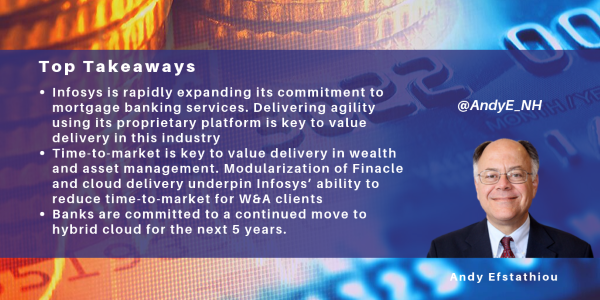
At the 2019 Infosys Confluence North American event last week, we spoke with execs about how Infosys has been driving accelerated growth in the BFSI sector in North America. Most of Infosys’ revenues in BFSI are in Banking and Financial (BFS) services, where the recent growth been based on the following major activities:
- Installations of Finacle: in the past two years, Finacle, which now has 540 installations globally, has seen increasing adoption in North America. Key to this has been a focus on modules that solve immediate client problems, and then radiating to additional modules as required. Key high demand modules in the North American marketplace for Finacle include:
- Digital engagement suite
- Payments platform (electronic payments)
- Commercial banking
- Setting up a new digital bank (Finacle has regulatory approval in 50 states, something only a few legacy ISVs have)
- Reengineering sales engagements: Infosys has restructured its GTM from an offering siloed approach to a client management team approach. This change in approach has helped deliver improved topline growth in North America, from 4.5% (as reported) in FY18 to 8.1% in FY19, outstripping both Accenture and TCS
- Design-led transformation engagements: e.g. creating the branch of the future for a regional bank.
Current areas of focus in BFS segments include:
- Mortgages: this is the largest single LOB revenue generator in the retail banking industry. In Europe, Infosys has recently formed a JV with ABN AMRO’s mortgage operations in the Netherlands, taking a majority stake (see our note here). And in the U.S., Infosys has acquired the entire IT team of a regional Charlotte, NC lender. It has also recently hired an industry veteran to rationalize its North American mortgage go-to-market activities and grow the business. The ability to scale operations up and down in the notoriously volatile lending industry is a key reason some lenders are adopting Infosys’ cloud-delivered mortgage services. Using its regional centers, it expects to grow its local lender business to 20% of its overall U.S. mortgage revenues
- Wealth and Asset Management: W&A managers need to launch new fee-based products to market rapidly to grow their business. The Infosys services team has been able to support new product development based on its work with market infrastructure providers. The Finacle platform allows new modules to be set up quickly (often in a quarter of the time an internal set-up would take). The reduced time to market provides significant sales acceleration to the client. Revenues from this type of engagement, and the pipeline, have grown rapidly over the past two years.
Banking clients we spoke to said that they anticipate continuing to move to the cloud (the reduction in time-to-market making the cloud value proposition compelling even when the cost is higher) and remain committed to moving to a hybrid cloud environment. They anticipate that the next big technology disruption in their sector will be the adoption of ML, which will accelerate over the next 24 months and start to deliver robust value.
Infosys’ banking sector business has regrouped its GTM, with a clear focus on providing agility to banks so they can reduce their time-to-market with new product introductions. Infosys claims typical cost reductions of 40-50% and reduced time to market. Their increased sales growth indicates it is working well.
At the same time, Infosys has continued to invest with technology and operations acquisitions and will continue to increase its footprint in Western Europe and the U.S. One challenge will be handling volume swings when the market turns.
A major focus at Infosys’ client event was its Live Enterprise (LE) approach - we will shortly be publishing a separate blog on this.
]]>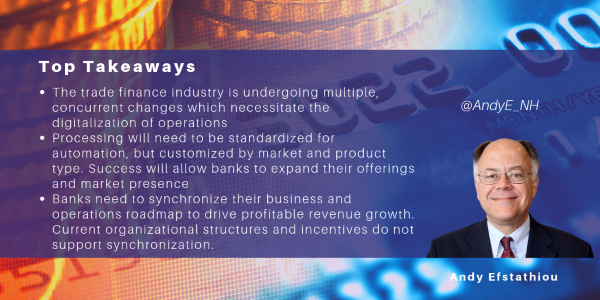
Improving efficiency and reducing manual processing of trade finance services has been a difficult challenge for over a century. However, the industry is on the cusp of a transformation which promises to standardize and automate this highly idiosyncratic, manual ecosystem. This blog identifies some of the key trends in trade finance transformation and how one vendor, Capgemini, is supporting banks in this transformation.
Trade finance industry trends
The trade finance industry is undergoing multiple, concurrent changes, including changes in participants, routes, underlying products, and communications channels. These changes require the underlying processes to become digitalized. However, the increase in stakeholders and process complexity inhibits the implementation of the changes required. Key industry changes include:
- Continued growth in trade finance volumes. Headlines trumpet a trade war which may end up being very temporary. However, even a trade war will drive increased trade finance activities as alternative routes require increased levels of finance to support standing up new supply chains. Current processing is manually delivered by experts who developed their skills on-the-job. Scaling these resources, as industry volumes are expected to grow faster than the world economy, will be impossible without long lead times (more than a decade)
- Shift from product-based to services-based trade. The shift in underlying goods traded will necessitate new skills which cannot be taught on-the-job, at any scale
- Shift to usage-based contracts from ownership-based contracts. These contracts will also require new skills to process. In addition, the change to usage-based contracts will lengthen the amount of time the LOCs will remain outstanding, as well as changing the conditions for a drawdown
- Shift in shipping routes (Atlantic trade to Pacific trade, Northern hemisphere to Southern hemisphere). Trade finance practices vary by trade route. The shift of volumes to emerging routes will shift the skillsets required at scale
- Growth in digital and omni-channels The shift of business processes to digital channels will necessitate a shift in business practices for trade to a digital environment.
These changes necessitate the following digital transformation requirements:
- Standardize and automate processing
- Allow adaptation of processing by route and channel
- Process new underlying product types, primarily services
Below I look at two client cases from Capgemini and how both engagements addressed these three digital transformation requirements.
Top 5 global bank based in the U.S.
- Challenge: automate and enhance the processing of trade finance operations:
- Assess and recommend a trade finance solution which would automate processing and provide “best-in-class” functionality
- Ability to process non-traditional products.
- Scope:
- Assess six solutions and activities at five competitor banks
- Assess ability to process non-traditional products including open accounts, dynamic discounting, early payment, e-invoicing, supply chain finance.
- Benefits:
- Rigorous multi-stage selection process for solution
- Identified and selected optimum solution which automated existing manual tasks and added capability to process new product types.
Large European bank
- Challenge: change the operating model for structured finance of commodities under conditions of changing regulation and business environments
- Scope:
- Review documentation of as-is processes
- Analyze unique characteristics of structured trade finance processes
- Analyze evolving compliance requirements
- Address stakeholder constraints/concerns
- Develop a target operating model to digitalize the processes.
- Benefits:
- Reduced headcount by six FTEs
- Reduced costs by $1.5m across APAC region
- Increased operational efficiency.
Summary
These cases highlight how digitalization of trade finance requires automation, adaptation by channel, and enablement of new product types. The existing state of highly manual processing allows very large efficiency gains for a successful transformation. Challenges to successful implementation include:
- Many solution vendors are developing offerings, which requires expertise to assess relevancy and quality for the banks
- A bank’s business roadmap is becoming increasingly important as operations transformation must mesh with bank product services (e.g. support for open accounts and dynamic discounting). Synchronizing business and operations roadmaps requires two disparate executives teams with differing incentives and drivers to agree to compromise on their internal roadmap for the good of the organization.
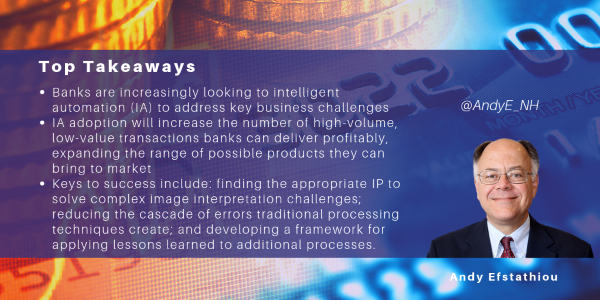
The BFSI industries are increasingly looking to intelligent automation (IA) to address key challenges in their business. A recent NelsonHall survey of 50 BFSI executives found that they perceive that IA is able to replace manual processing and human decision-making, allowing the bank’s operations to decouple processing volumes from headcount. Key benefits respondents expect to receive from IA include:
- Improved handling of low value transactions (100% of respondents)
- Reduced cost (98%)
- Improved service fulfillment times (96%)
- Reduced error rates (92%)
- Improved customer experience (88%).
However, achieving these benefits has frequently been challenging because:
- Use cases are domain intense, allowing at most 50% reuse for similar processes
- Implementation is labor intense, often requiring 4 to 6 months of time and costing up to $1m
- Unmanaged bots can learn the wrong things and “go off the rails” over time, destroying value
- IA is not one technology, but multiple technologies working in concert, which makes effective systems coordination critical to delivering a useable solution.
The complexity of these challenges requires IA vendors to create a roadmap and deliver an offering which targets a narrow range of problems. Typically, there needs to be three types of participant in the development of an IA offering:
- Systems integrator: who will identify client needs, implement the customized solution, and manage the ongoing operation of the IA solution to assure continued effectiveness
- Academic partner: who will provide advanced cognitive technological tools and insight to develop a differentiated offering
- Product vendors: to deliver COTS RPA and basic IA tools to the offering.
Let’s look at how one vendor developed an IA offering, and then at an example of how it was deployed.
HCL’s EXACTO
HCL decided to create an IA offering in 2016, focusing their product on the processing of unstructured data. They began their process by partnering with a leading U.S.-based university, which had developed analytic solutions for processing radiology images. The image processing capability would be useful for processing physical paper documents used in banking contracts, procurement, and handwritten documents.
HCL launched its IA product, EXACTO, in 2017. The underlying platform is built on open source machine learning libraries. The product uses servers with GPUs to run Deep Neural network algorithms. EXACTO can integrate into an existing workflow application with a single API. It has four differentiating capabilities:
- Image processing: fixes distortions, removes noise, and sharpens images
- Text recognition: extracts text from heterogeneous fonts/handwriting. Detects multi-languages
- Domain ontology: provides data correction and search-and-sort fields from data streams
- Deep learning and natural language processing: extracts localized characters and classifies documents.
HCL claims EXACTO achieves 85% to 95% accuracy on typewritten documents and 60% to 65% accuracy on handwriting. It processes documents in three stages:
- Digitization of document images
- Classification of the output into categories
- Extraction of data from the digital output, which is then fed into the target application.
Let’s look at how EXACTO was applied to a very manual, paper-based processing environment.
Trade processing at a global bank
Trade processing is well known for using faxes across very large numbers of parties to conduct business, and frustrates attempts at process automation. The process has a T+1 reconciliation window, which drives increased costs as labor needs to be applied in volume to meet the deadline. Initial errors from manual processing are enhanced by errors introduced by manual processes in the audit trail. Typical errors include:
- Trades erroneously marked as processed in the source system, when they have not been entered into the target system
- Trades marked as duplicate when two similar, but different trades are received from two different brokers
- Data entry discrepancies at the time of trade booking which are not caught until reconciliation.
EXACTO was applied to the processing of faxes and paper documents. It classifies documents using a domain ontology and extracts text into a digital form which is then processed.
Benefits from the use of this IA solution include:
- Reduction in average handle time of 60%
- Enhanced accuracy due to machine learning
- Improved audit trails and compliance
- Can identify duplicates and correctly tag them
- Continuous automated evaluation and improvement of process
- Can run multiple instances to process large volumes
- Able to process 24/7, unlike humans
- Auto-capture of data without the need to configure each input template.
Summary
As described above, IA is enabling institutions to read documents and pictures faster and more accurately than humans. It is then able to process the resulting information with greater accuracy and speed. The traditional cascade of errors is mitigated, improving regulatory compliance and customer satisfaction. The key to success in this endeavor is finding the appropriate technical IP (in this case in a partnership between domain experts at HCL and image reading technology at a leading U.S.-based university) to solve complex interpretation challenges. The resulting solution can process low-value transactions at high volume and with high accuracy. This type of solution will increase the number of high-volume, low-value transactions which banks will be able to deliver profitably, expanding the range of possible products they can introduce to the marketplace.
EXACTO is trademarked by HCL.
]]>
Blockchain has been a focus of technologists, VCs, and media pundits for several years now. However, to date, operational deployment remains minimal. Of all enterprises already working with blockchain, only a few percent have a scale operational deployment. Blockchain has seen three stages in its short history:
- Lab testing of the technology: 2014 to 2016. Key events include the launch of Ethereum, Hyperledger, and R3
- POCs: 2016 to 2018. Key events include the launch of BaaS (IBM, Microsoft JV), B3i (insurance), Marco Polo (trade finance), MOBI (mobile DLT), IIN (interbank information network)
- Operational usage: 2019 onward. Key launches include NASDAQ LINQ, JP Morgan JPM Coin, Binance and the recently announced Facebook’s Libra.
Activities are slowly moving from exploring the technology and what it can do to finding out where it can be profitably applied to business cases.
Achieving effective operational deployment
Businesses are finding that key steps in making effective operational deployments include:
- Identifying compelling use/business cases, where key components include:
- Business value: cost reduction needs to be significant and ongoing
- Transaction execution speed: distributed ledger technology currently does not execute quickly. However, the evolution of private consensus mechanisms and permissioned blockchain networks, has addressed many of the concerns for DLT over speed and scalability
- Ecosystem openness: closed systems (e.g. exchanges or closed payment platforms) are inherently more likely to see an alignment of partner goals and values
- Building the right reference architecture: an enterprise blockchain platform is more than just a blockchain technology stack. It encompasses Infrastructure (data, storage, network), security (including auditing), applications (templates, IDE, testing, integration), and operations (monitoring, smart contract management, ecosystem management) in addition to the platform itself (consensus management, smart contract execution, etc.)
- Identifying relevant partners, including product and business partners. The partners need to have as compelling a need to join as the promoter’s need, which often has not been the case
- Creating an effective governance mechanism: mechanisms require addressing the needs of regulators, participants, and customers
- Adoption: buy-in requires both a thoughtful explanation of cost/benefits and a forceful statement of ecosystem requirements for continued participation as a member. The priority for promoters of a blockchain proposal is to maintain trust while participants are undergoing the major operational changes blockchain brings.
Example of successful blockchain deployment application in Banking
So, where can blockchain be deployed effectively in an operational environment? I caught up with Capgemini recently on one of their blockchain engagements that has gained significant traction. In this case, Capgemini deployed blockchain to address KYC in the banking industry. The client is a consortium of banks that wanted to reduce the cost of its combined interbank KYC activities. Key aspects of the engagement were:
- Challenge: Banks typically conduct KYC/AML verification with manual, multi-step processes. Processes are repeated across banks and internally across departments for the same customer. The consortium wanted to simplify and automate processing to reduce cost and error rates. By sharing KYC/AML data for a given customer across departments and banks, the consortium wanted to reduce duplication of static data processing
- Scope of engagement: Capgemini designed a hybrid Hyperledger Fabric/R3 Corda solution that enables KYC data collected by one institution to be validated and shared among multiple institutions. Each participant bank can fill in the complete KYC profile with elements of their own data. The resulting KYC profile is more robust since it can be verified by more than one participating institution. Every bank shares the same decentralized master copy of KYC data
- Benefits:
- Reducing cost from a reduction in duplicative processing and increased automation
- Improving speed at which KYC record documentation is completed due to the reuse of static data, rather than reconstruction of data for each KYC report
- Increasing accuracy resulting from data sharing.
The characteristics of successful deployments
The case above highlights that successful deployments of blockchain are often characterized by:
- Input processes taking data from multiple, heterogeneous sources, which are then manually processed with little standardization across internal or external silos
- Output processes delivering relatively simple, highly standardized reports (e.g. go/no go decision on doing business with this entity)
- Participants sharing the goal of obtaining the same output with no competitive pressure and proper governance mechanisms
- Blockchain technology creates a statement of record which should be used to eliminate repetitive reconstruction of static data for each transaction. This creates efficiency by eliminating steps.
Institutions looking to deploy blockchain trial 100 POCs on average to find ~3 use cases to operationalize. By looking at the characteristics of successful deployments, institutions will be able to focus their experimentation on projects with a much higher likelihood of being valuable in a business setting.
]]>
NelsonHall recently attended the TCS Innovation Forum 2019 in New York. The forum demonstrated clear progress in TCS’ thinking and approach to Business 4.0 since last year’s conference – TCS has identified human engagement and buy-in with the principles of Business 4.0 as critical to successful implementation and value realization in business transformation. And human buy-in is applicable at multiple levels in an enterprise’s journey, not just the initial buy decision.
Successful Business 4.0 projects are different from traditional projects at three key levels:
- Approach to technology: the approach changes from large project scope with minimal component transparency (using long development roadmaps, employing siloed teams using waterfall development methods) to small project scope with high, ongoing stakeholder feedback (employing scrum teams using agile development methodologies)
- Use of solutions: effective use of solutions requires the employment of meta-frameworks to articulate business metrics and technical criteria for solution selection and deployment. Large libraries of experience-sourced benchmarks underpin the weighting of each criterion for specific environments considered
- Sourcing solutions: the emphasis shifts from standardization on a solution suite, to selecting the optimum solution for a specific task. Because much of the functionality is only available from emerging product vendors it is necessary for integrators to use larger ecosystems of product partners, which are continually evolving.
Multiple client conversations presented at the conference highlighted how digitalization of the business has changed the approach required to solve operational challenges. Key examples given across sessions included:
- Data management KPIs are changing as processing data is less of a challenge, while curating data is becoming more of a challenge: deep learning can use vast quantities of data. Today, the algorithms to analyze data are robust, but data quality remains a key challenge. Several clients discussed their efforts to reduce the amount of data analyzed and draw conclusions from a more limited, but much higher quality data set
- Testing simulations to reduce resource and time requirements while increasing learning feedback: systems do not work in silos, but planners and controllers operate in task silos. Globally optimized system development requires analytics support to allow developers to understand complex system-wide interactions. Increasingly advanced enterprises are using digital twins to allow technologists to shorten their learning curve in real-time to produce effective project deliverables
- Data democratization: Harvesting greater value from data requires more stakeholders to access and process that data. Advanced enterprises are increasing appropriate access to the use of data while masking components which need to remain private. Increasingly, enterprises are developing sophisticated strategies for determining what, where, when, and how access is granted
- Reverse innovation: Innovation on large legacy systems is proving to be less effective than de novo projects where there are no legacy systems, procedures, or fiefdoms to defend. Enterprises are launching new ideas in emerging markets and then they (or TCS) bring those projects back to mature markets when fully vetted.
TCS and several clients provided a deeper dive into their data activities in a breakout session. TCS’ data services strategy is underpinned by three offerings:
- DATOM: a data and analytics maturity assessment, consulting, and advisory framework that enables customers to drive their growth and transformation strategies at the board level or CxO level, leading to multiple downstream initiatives
- DAEZMO: a framework that includes Machine First accelerators and leverages cloud, containerization, DevOps, data virtualization, etc. to modernize the existing data landscape to be business 4.0-ready
- Decision Fabric: a cognitive business engine that enables the automation of complex business processes and powers contextual industry offerings.
The underlying solution accelerators support the move to cloud-delivered, agile data management services. TCS sees the following shifts occurring in data management activities:
- Data gathering and curating: currently consuming 50% of enterprise applied effort, this will shift to just 10%
- Data analysis and decision: currently consuming 10% of enterprise applied effort, this will shift to 50%.
Repeatedly, clients stated that they did not find the move to cloud saved them money. However, it did make real-time and near real-time analytic computations possible, which created significant differentiation in time-dependent processes. Often these processes were customer-facing, which increased sales closure and/or increased CSAT. Effective cost control required a shift in management focus from the cost of provisioning services (old model) to cost of controlling usage (new model).
The challenge in innovating operational systems has become a challenge of changing people’s mindset to focus on the key levers that new technology offers. Therefore, emerging markets are often producing the fastest adoption of digital technology, as there is no legacy mindset to overcome. TCS works with the largest institutions to support this type of change. It is just now creating the productized offerings that will be able to support mid-market firms adopting digital technologies (business 4.0) en masse.
]]>
NelsonHall recently attended the EY Global Analyst Summit in Boston. EY has grown its revenues at 8.5% CAAGR over the past five years, while investing heavily in technology and adapting its business model to become an IP-based services vendor rather than a provider of pure labor-based services.
Here I take a quick look at EY’s wavespace offering and how it is being used to provide value for large enterprises. EY believes that large enterprises have many good transformation ideas but fail at execution. To improve execution of transformation projects, EY uses Geoffrey Moore’s “Zones to Win” taxonomy, which defines four project types each requiring a different mix of resources to succeed. EY believes it provides three core competencies to solve the disruption challenge:
- Design of services
- Business model innovation
- Engineering.
EY’s goal is to drive large ($100m plus) transformation projects. EY’s wavespace network, launched in March 2017 with 15 centers, has now developed to a network of:
- Flagship centers, with a full range of services in each center. There are currently 20 flagship centers
- Satellite centers, with a sub-set of services and focused expertise. There are currently ~2x the number of flagships centers
- Pop-up centers, which are flexibly available. These are client/engagement-specific temporary centers focused on a specific challenge a client is facing, delivered from the cloud to an EY or client site.
Wavespace events at a center require pre-planning to pull in the right mix of:
- EY subject matter experts
- Client stakeholders with the domain responsibility and knowledge
- Third-party partners with expertise and IP.
Events run for one to three days, and EY wavespace delivers 700 events in the U.S. per year. As EY has developed its delivery model for wavespace, delivery has moved from a location-based event to an as-a-service offering independent of a physical place. This allows global organizations to develop their own customized offerings in a highly decentralized fashion.
The consulting services EY delivers are supported by:
- Proprietary IP, focused on tools to massively source data/capabilities online and harness these resources to enable small teams to apply them to specific projects:
- EmbrYonic: a cloud-based AI platform to analyze relationships between traditional and disruptive businesses. It tracks VC and M&A flows on 6.5m companies
- Transformation hub: a learning portal used by EY clients looking to implement technology products
- Cognistreamer: a collaboration platform for external and internal stakeholders to collaborate. Enables enterprises to crowdsource solutions to problems
- Storybook: a SaaS-based platform used by enterprises to understand how their customers move through their offerings.
- Digital Factory Layer: these are the capability modules within the wavespace centers:
- Research lab
- Design studio
- Innovation hub
- Showcase
- COE
- Delivery center.
Examples of how BFS clients are engaging with wavespace include:
- Citibank Canvas: Canvas is a crowdsourced beta testing community established to improve customer experience. Since the inception of Canvas, Citi has experienced an 11% increase in brand favorability
- Global universal bank: uses the research lab to continuously monitor customer sentiment and CUX best practices
- Global retail bank: long-term use of wavespace to transform processes in trade finance, F&A, CUX, capital and profitability, Finlab, data management, and analytics. The bank is using wavespace to digitize its $17 Bn legacy operations platform investments.
EY’s vision of digital transformation is focused on effectively bringing together large ecosystems of participants to solve enterprise challenges. EY has built its wavespace center offering to coordinate bringing the right participant at the right time into a workgroup. Clients who have engaged with wavespace have typically returned with ever larger engagement remits, as the growth in the centers and engagement activity demonstrates.
EY has been wise to maintain a narrow product focus (e.g. platforms such as SAP) and narrow client focus (large enterprises). Other vendors have set up sandbox centers like EY’s wavespace, but they retain sole or dominant presence in their centers. EY has taken a bold step, aggressively opening its centers to third-party participants. EY’s business model is moving from labor-based delivery services to orchestrator of services delivery. However, wavespace’s continued success will require maintaining managerial effectiveness over third parties who are outside of traditional control mechanisms.
]]>
I recently attended the WNS influencer conference in New Orleans, the theme of which was 'Co-create to Outperform’. WNS believes that the marketplace understands what transformation means for their businesses, but the challenge is how to achieve this vision. WNS’ view is that, for transformation to be effective, it needs to be customized for the client with their full participation in the co-creation process. The conference presented many examples of how a ‘two-in-a-box’ engagement was able to identify and implement an effective solution to a challenge which delivered both very high savings and high satisfaction.
Client feedback
WNS presented seven clients who outlined their engagements and why they chose WNS, with several key themes emerging.
All clients referenced:
- WNS enjoys very high client retention. Each client presenter had worked with WNS for multiple years and several were clients for over 10 years
- Culture fit is very important and a key to WNS’ success
- WNS is a vendor who works with clients across a wide range of sizes including middle market enterprises. In the banking industry WNS focuses its services on financial institutions with assets from $50 Bn to $200 Bn. Banking industry clients present stated they preferred WNS because they were important to WNS at their size.
Most clients referenced:
- A focus of WNS’ work with clients is SCM/F&A
- Delivery model included WNS as manager of multiple third parties (‘one throat to choke’)
- Many engagements required the move from ‘tribal knowledge’ to standard operation procedures, without antagonizing the client’s people or culture
- WNS was introduced to them by word of mouth from satisfied clients. For example, two clients had not initially included WNS in their RFPs because they reached out to ‘the usual suspects’ for proposals. When the proposal process was not progressing satisfactorily, WNS was drawn in at a late date to bid due to a referral based on a successful engagement of the same scope and focus. During the bidding process, WNS turned out to be an exact fit for their needs.
Client example: regional bank
A northeast U.S. regional bank provided an example of WNS’ engagement style and benefits delivered. The bank began its relationship 12 years ago, when it was looking to improve its operational efficiency by moving some processes offshore. Over time, the relationship has grown due to:
- Cultural alignment: the bank places a high value on interpersonal relationships. It operates in close-knit communities where the standard of interaction is high support for the customers and communities. WNS is comfortable working without reference to a contract, once it has been signed, and without change orders, unlike other vendors. It has also enabled WNS and the bank to co-create solutions to improve processing efficiency
- Flexible staffing model: WNS has been willing and effective at flexing staffing levels as volumes swing, including when there have been unanticipated volume swings
- Periodic process reengineering: WNS has identified process reengineering opportunities and fulfilled the technical work to implement those changes. The bank is a frequent acquirer of other banks, which provides a steady flow of these opportunities
- Robotics: RPA is difficult to implement effectively. WNS has been effective at co-creating with the client to build and implement RPA solutions which meet and continue to deliver the business objectives the initial business case envisioned.
The example the bank presented was of an RPA implementation to capture information from legal documents. The bank had hired a consultant who identified the opportunity and built the business case. The consultant intended to implement the RPA solution, but the project failed to move forward. The bank called in WNS who took over the project and, working with the client, co-created the final automation solution, including implementation. The department previously processed these documents manually, with an annual budget of $750k. Currently, the department is processing these documents for $329k per year, a cost reduction of 56%. When the system has fully matured, the anticipated cost reduction will be 67% of the annual budget. The bank summarized the relationship benefits as: their investments into the relationship, the quality of work delivered, and the cultural fit.
The WNS approach
WNS’ approach to digital transformation for the banking space targets an underserved market, medium-sized financial institutions, to transform manual-intensive processes into automated processes. WNS works with these clients to create solutions customized to support the client’s differentiated value proposition in the market. Few vendors are willing or able to apply resources to middle market or regional engagements that create customized outputs. This allows WNS to apply its domain knowledge, which is embodied in its employees based on their industry experience, to solve operations challenges to drive outcomes relevant to industry and market-specific requirements.
WNS has been wise to maintain a narrow process focus in each industry. Execution is critical to a project’s success, especially so with RPA engagements (where, post-deployment, most RPA deployments increasingly lose effectiveness due to poor bot oversight). In addition to clients in the audience, there were prospects who are considering RPA engagements with WNS because of poorly performing RPA engagements with existing vendors.
]]>
I recently attended the official opening of Infosys’ design center in Providence, Rhode Island. In 2017, Infosys committed to hire 10k workers in the U.S. by 2022. Part of that commitment is a plan to open six training and delivery centers across the U.S. intended to provide benefits including:
- Partnering with local colleges who have specific capabilities such as design education, which are critical for delivering digital services to enterprises, but in short supply with existing workforces
- Delivery centers for these skillsets which can work closely with regional and national enterprises to address legacy processes which have been a challenge to address using offshore delivery
- Creating a more intimate relationship with Infosys clients from onshore.
The six centers Infosys committed to build are:
- Indianapolis, Indiana: target 2k workers by 2022
- Raleigh, North Carolina: target 2k workers by 2021
- Hartford, CT: target 1k workers by 2022
- Phoenix, AZ: target 1k workers by 2022
- Richardson, TX: target 500 workers by 2022
- Providence, RI: target 500 workers by 2022.
A closer look at the Providence center
The Providence center was officially opened on February 12, 2019 but has been operating since summer 2018. Its initial client is a major bank. The center was initially established with a partnership between Infosys and Rhode Island School of Design (RISD), a leading school for industrial design located a few blocks from the center. RISD was ranked number one in 2015 and 2016 for graphic design, printmaking, and industrial design by QS World University Rankings. The partners are contributing:
- RISD: coordination of course development with Infosys, classroom instruction, and student placement services into the center and Infosys workforce
- Infosys: identification of relevant work skills required, internships, and jobs for graduates.
To date, the center has hired 100 employees (ahead of plan). Half the hires are from RISD and half are from Community College of Rhode Island (CCRI).
At the opening, Infosys and CCRI announced a partnership which committed each organization to work to train and employ CCRI students in relevant design technology skills. The impetus for the partnership is that community colleges teach 50% of the college level students in the U.S., but these graduates obtain relatively few job offers relative to their numbers. By providing relevant work experience, Infosys and CCRI expect to increase the rate of job search success for these graduates. To date, Infosys has found that the CCRI students have a higher level of job performance and morale than their typical employees. The partnership uses the DEAL (Digital Economy Aspirations Lab) as its development venue, where students learn, in a corporate environment, skills that are immediately relevant to Infosys and other employers. In addition, DEAL will sponsor two joint task forces:
- Identifying entry-level roles suitable for community college students across industries, and creating paths to move into those jobs
- Articulating the value of these experiences to four-year colleges so that students can receive credits from those colleges to apply towards four-year degrees.
Conclusion
Skills to deliver digital technologies are in short supply globally. A key value of digital technologies is the ability to engage people much more effectively. Infosys has taken this challenge and built a differentiated center focused on industrial design technology implementation for its existing clients (mostly tier one global enterprises). It has built the center next door to one of the top colleges in the world for industrial design. By working with local colleges Infosys is able to ensure that skills are learned which are immediately relevant to the work required by Infosys’ client engagements. Industrial design is fundamentally a creative process, which means each worker is a unique asset. The colleges identify students who have the capability to succeed in creative work; Infosys then works with the school students to develop relevant skills. The result is a differentiated design capability created in Infosys’ workforce.
The next decade will see a rapid growth in demand for industrial design capabilities across industries, as 5G, open banking, and omni-channel delivery infrastructure becomes operational. As data and channels grow, customer engagement will become the critical differentiator for successful enterprises. Creating a workforce with advanced design capabilities at scale is necessary to capitalizing on this new environment. This center is a first step in the industry to shifting the ITS proposition to differentiated delivery.
]]>
The banking industry cycle has turned towards austerity for 2019 as indicated by recent events, including:
- Labor cost cutting: State Street announced 1.5k executive layoffs, and Santander will close 20% of its bank branches in the U.K. Both are part of long-term trends incurred by automation and the shift to omni-channel delivery
- M&A activity: Cost pressure is driving banks to sell their operations centers to third-party services vendors. For example, in the past month, Cognizant acquired the operations of three Nordic Banks which were joined into one vehicle, Samlink. Also, long-time banking operations industry consolidator Fiserv acquired First Data, a payment processing services and solutions vendor, to increase its scale in payments
- Tightening financial conditions and slowing of economic growth: U.S. Fed and other central banks raising interest rates, and slowing economic growth in the U.S., China, EU, and U.K.
These events underline conditions where the financial services industry will face slower revenue growth and will need to aggressively reduce costs to remain profitable. Because of this, we expect 2019 to be a strong year for banking outsourcing, with banking ITS and BPS markets growing as fast in 2019 as in 2018. Below I identify five key growth areas for 2019.
IT outsourcing
Banks are merging or selling unwanted branches and lines of business, and this trend will continue until the next recession. M&A will drive IT outsourcing deals, as banks look for temporary labor to integrate targets quickly to realize efficiency benefits.
Core banking platform expertise will be key to winning deals, but digital technologies will be required to support the agility needed to cost effectively reengineer the operations of both the acquiring and acquired banks. Currently, Europe is showing the highest level of activity in this area. Later in the year we expect the U.S. to accelerate. Asia will remain a laggard in this area over the next year.
Open banking
In 2019, open banking will take off, due to regulatory deadlines requiring go-lives in 2019, as banks look to monetize their assets. Open banking is the concept whereby banks open their platforms to third-parties for them to transact business with the banks’ customers and suppliers. And currently, banks are playing with business models, pricing schemes, and target customers.
The banking industry provides no direct comparable offerings to guide banks looking to monetize open banking assets. Setting up a business will require significant investment in security and vendor quality controls before the first dollar is made. Expect there to be many missteps along the way. ITS vendors working on infrastructure enablement will be the ones to make money in 2019. We expect interesting ideas to come to the fore from 2020 onwards. It will take five years for successful business models to take root and consistent earnings to start rolling in.
Automation & AI
RPA and AI implementations have been growing rapidly for the past three years and will continue to do so in 2019. Key initiatives for 2019 will be for services vendors to improve their use case development and create the ability to manage RPA bot groups.
RPA use cases do not make their cost projections over 60% of the time when deployed in POCs. Development of use case libraries and improved analysis is mitigating, but not eliminating, this challenge. Vendors are now repurposing successful use cases across clients and geographies. 2019 will need to be the year where vendors and banks consistently identify winning use cases prior to POC deployments. Vendors who succeed in this challenge will be able to deliver much higher return on engagements for their clients.
Management of deployed bots has been a significant challenge for banks and vendors. By integrating AI into controller bots, vendors can increase the uptime and effectiveness of bot teams. Where bots operate 24/7, it is more effective to automate the management than to have humans managing with shift handoffs.
Cloud delivery
Banks are finally willing to aggressively make the transition to cloud delivery. Currently, the primary venue for cloud is on-premise. However, to achieve aggressive cost takeout under conditions of rapid IT infrastructure/application change, it requires external cloud delivery from a shared environment.
Banks are grappling with redefining the internal/external operations split. In 2019, banks will articulate what needs to remain internal (high value, non-repetitive processes) and what can be delivered externally (low value/less differentiated processes). Operations will still need to integrate these two types of processes effectively. Cloud delivers high cost savings, but on a small operational footprint. Enlarging the operational footprint is the highest cost saver and will be undertaken by successful banks this year.
Transaction processing management
Banks will focus on transaction processing management. Regulations requiring real-time payments have led to new regional platforms which deliver instant payments, including NPP in Australia, RTP in the U.S., and Instant Credit Transfer scheme. Now banks need to understand and manage these high-speed transactions within their internal operations. Banks will deploy AI to achieve better, more efficient processing of transactions. The AI will need to pull and process data in real-time to stop unwanted transactions and report suspicious ones. And because the transactions are between counterparties, banks will seek third-party IT services vendors to support processing and coordinate across counterparties.
]]>
The primary purpose of Wipro'ss Digital & Big Bets Analyst Relations day in Boston at the end of November was to outline its digital and automation strategy, including presenting some startup partners Wipro is working with (and has invested in through Wipro Ventures) to help drive forward this strategy. Wipro believes its key technology bets will enable it to help clients reinvent their businesses as digital businesses.
Here I take a look at Wipro’s four ‘big bet’ initiatives, with examples from the financial services industry, and provide feedback from two of Wipro’s startup partners.
The four big bets
Wipro has selected four key areas as its big bets:
Digital
Its digital big bet is around the application of technologies and methods to human interaction, especially customer contact. Wipro presented a case study of a mortgage lender whose legacy mortgage origination process was long, complex, and difficult to navigate for originators and borrowers. The result was a very low conversion rate for borrowers who started an application.
Key components of the solution were mapping processes, bringing in stakeholders to discuss challenges and preferences, designing an improved customer journey, and implementing the platform. The result was improved NPS and conversion rates.
Cloud
Cloud delivery is a foundational bet which underpins all of Wipro’s automation initiatives. Wipro presented a case study of a major financial data provider which used an inflexible legacy platform for its data services business. The platform was inflexible, costly, and operating on aging infrastructure.
Wipro was able to re-platform the legacy apps to AWS while doubling memory and servers. AWS delivery enabled improved BCDR. The result was a 64% reduction in OPEX and a one-year payback.
Cybersecurity
Here, Wipro emphasized the importance of making it simpler and easier for clients to manage their cyber risks. Currently, Wipro has ten platforms and is increasing the number of partners it works with to address this ongoing challenge. With reference to the Equifax breach, Wipro stressed that the most important feature of cybersecurity is not to perfectly secure the environment, an unattainable goal, but business continuity after a breach (with continuity requiring minimization of operational losses and trust with stakeholders). It stressed that setting client expectations, using the latest techniques, and providing customers with high levels of transparency are the key elements.
Industrial and engineering services
Here, Wipro is helping clients design products, improve them, and bring them to market. This is typically applicable to manufacturing clients, not financial clients.
The viewpoint from Wipro’s startup partners
I interviewed representatives from two startups Wipro has invested in, both of which are security vendors with large financial services client bases. They spoke to the value of the Wipro relationship and how they deliver value to clients:
Demisto
Demisto is a security orchestration, automation, and response (SOAR) provider. 25% of their clients are F500 companies, including tier one banks and payment processors. Their platform has three key elements:
- Case management and tracking tool
- Automation to accelerate response time
- Real-time interactive investigations using machine learning based on analysis of actions, not data.
Demisto said that it benefits from the Wipro partnership due to:
- SI and IT staff who are familiar with their technology and can integrate it into client environments
- Increased sales opportunities in multiple geographies and industries where they have not previously been working. Currently, the partnership accounts for a significant percentage of overall revenues at Demisto, up from zero two years ago.
Tricentis
Tricentis is a vendor of automated software testing services for DevOps. They target tier one companies, including large financial institutions. Testing is provided for UI and APIs on the web and mobile systems. Tricentis uses a partnership model for testing delivery, and partner organizations generate 50% of its revenues. Wipro has partnered with Tricentis for 14 months and now has several thousand testers trained in the Tricentis toolset. Over the past year, Tricentis’ revenues have doubled due to its partnering strategy. Over the next few years, Tricentis will focus on testing SAP applications in preparation for the 2025 SAP move to HANA.
Summary
Wipro is using the cloud to help tier one clients with ponderous legacy systems to become more agile and reinvent their business models. The challenge of a cloud environment is increased risk of cyberattack. Avoiding a cloud environment partially mitigates cyber risk, but not enough to overcome the cost and agility disadvantages of a legacy environment. Investments in cybersecurity are made to better manage the cyber risk that comes with cloud delivery and, more importantly, do it in a transparent way that maintains and improves customer confidence in Wipro’s services.
On top of the cloud and cybersecurity platform, Wipro is investing in digital services to support client revenue growth. Financial institutions cannot focus solely on cost-cutting; they need to drive revenues to build a sustainable business model. Promoting positive customer engagement using digital services is driving client revenue growth. Enabling these capabilities requires emerging technology products which Wipro delivers via product investments and partnerships. The partners I met have experienced rapid revenue and customer growth because Wipro’s clients are demanding automation services, and Wipro is recommending and staffing the delivery of those solutions.
None of Wipro’s big bets are final solutions, but rather approaches with no final form. The final goal is flexibility to adapt to an everchanging environment at a significantly lower cost than previously possible (50-80% lower cost versus the previous 20-35%). While most digital competitors are pursuing the same goals, the sheer scale of partnerships, client engagements, and internally allocated resources demonstrates Wipro’s commitment, and the number of engagements executed to date validates Wipro’s initiatives so far.
]]>
The recent NIIT Tech (NIIT Technologies Ltd.) analyst conference was an opportunity for the current administration, most of whose executives have been at the company less than 18 months, to discuss their strong business success. FY19 (ending March 31, 2019) has so far added 19 new clients. The BFS industry sector added four large clients.
NIIT Tech has accelerated its growth under CEO Sudhir Singh, growing revenues 23.1% in Q2 FY19 y/y, with net profits up 66.3% y/y over the same time-period. This has been accomplished by focusing on a limited set of high-priority areas:
- Industries – focused on three industries (BFS, Insurance, and travel). The BFS strategy is to focus on advisor engagement in the wealth and asset management sub-segment of the BFS industry and, to a lesser extent, on core platform transformation in banking
- Digital technologies/service lines – focused on the use of emerging technologies in legacy environments (digital, data and analytics, cloud, automation/AI/blockchain, and cybersecurity).
Key examples of delivery within NIIT Tech’s focus areas include:
- Digital – digital advisor portal primarily for a large asset management client; supporting over 7k wealth advisors and $64bn AUM.
- Data and analytics – organizational analytics for a tier one bank; analysis of mortgage broker sentiment to prioritize loan origination cases
- Cloud – platform transformation to cloud with BankingEasy on Azure for 19 local Indian banks; managed platform service for 200 financial services clients
- Automation/AI/Blockchain – RPA for 26 processes in retail and W&A; RPA and AI for a tier one U.S. bank to optimize back-end processing; application development and support for multiple FIs.
NIIT Tech uses third-party software for its solutions, but delivers its services using proprietary frameworks and tools. The primary proprietary framework is TESS, which it uses to identify the best opportunity processes for automation and deliver the implementation engagement. If clients do not want a retained automation environment, NIIT Tech provides TESS, its robotics-as-a-process offering. NIIT Tech has found, consistent with our research across vendors, that selecting the right process for automation, especially in RPA, is the major determinant of project success as well as the level of value delivered.
Core platform transformation is delivered leveraging of NIIT Tech’s proprietary TRON smart automation platform, which provides cognitive solutions for business processes, IT processes including QA and DevOps.
Clients I have spoken with indicate NIIT Tech’s tight focus has helped them decide to start and expand engagements to drive digital enablement internally. Because NIIT Tech’s parent is the largest IT training organization in India, it is able to train and provide the required number of qualified staff to deliver digital engagements (while most clients and competitors find it very difficult to find staff with relevant qualifications in these high-demand technologies). NIIT Tech has sufficient backlog to continue its rapid growth for several years. However, its delivery will need to remain relevant to new local countries as it expands its footprint across geographies.
I am researching RPA and AI services in BFS for my next market analysis project this winter, delving deeper into adoption challenges and the opportunities these technologies provide to banks.
]]>